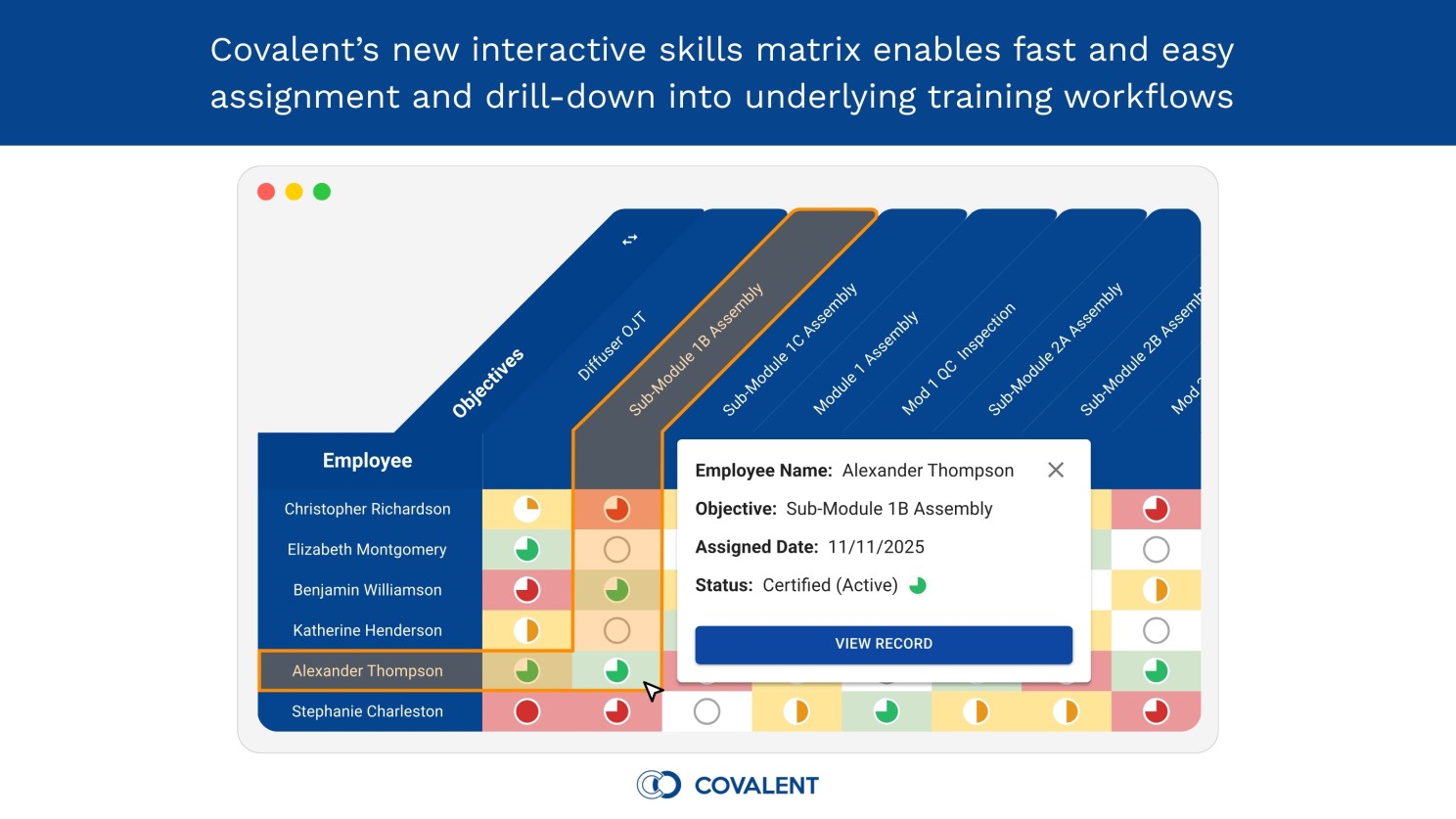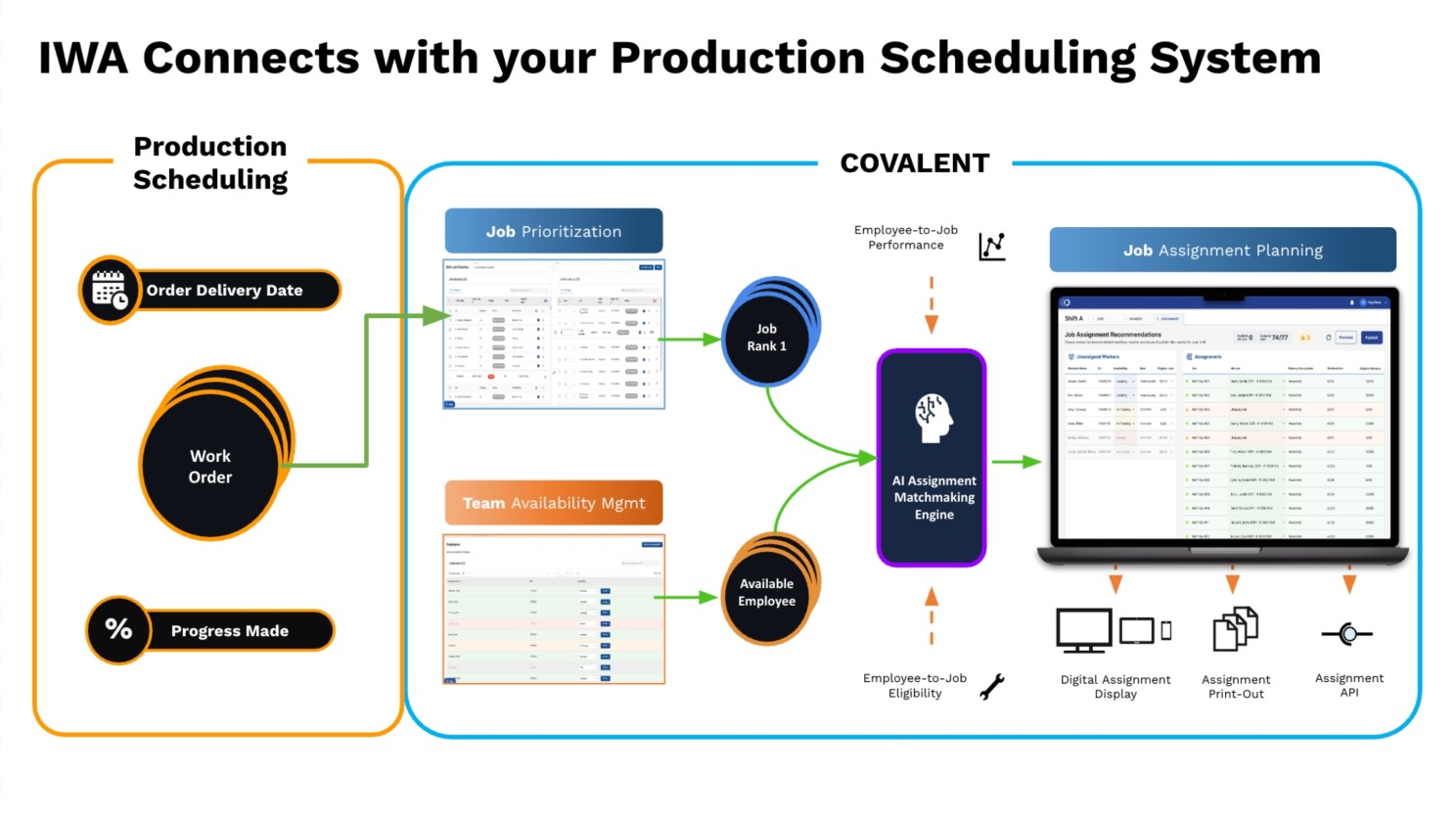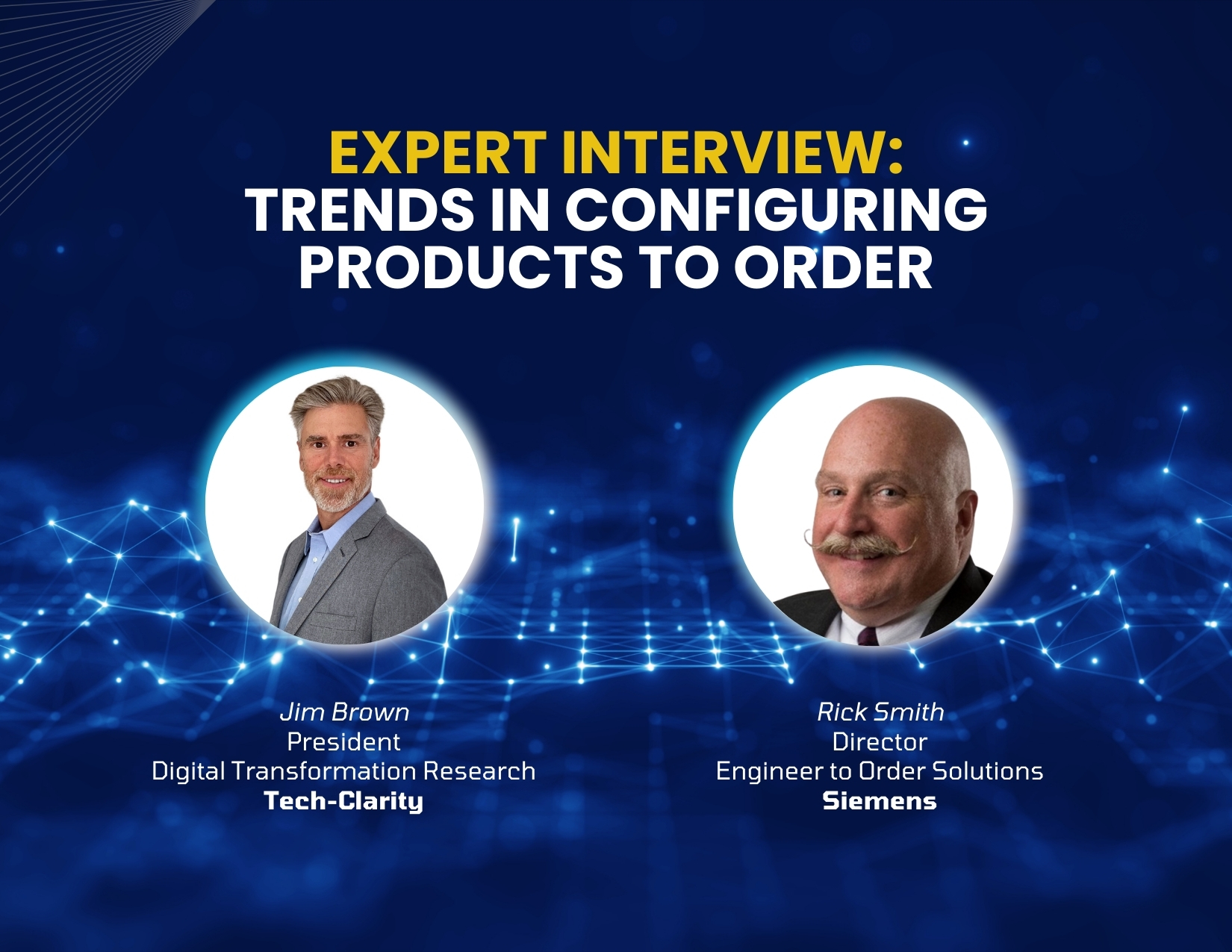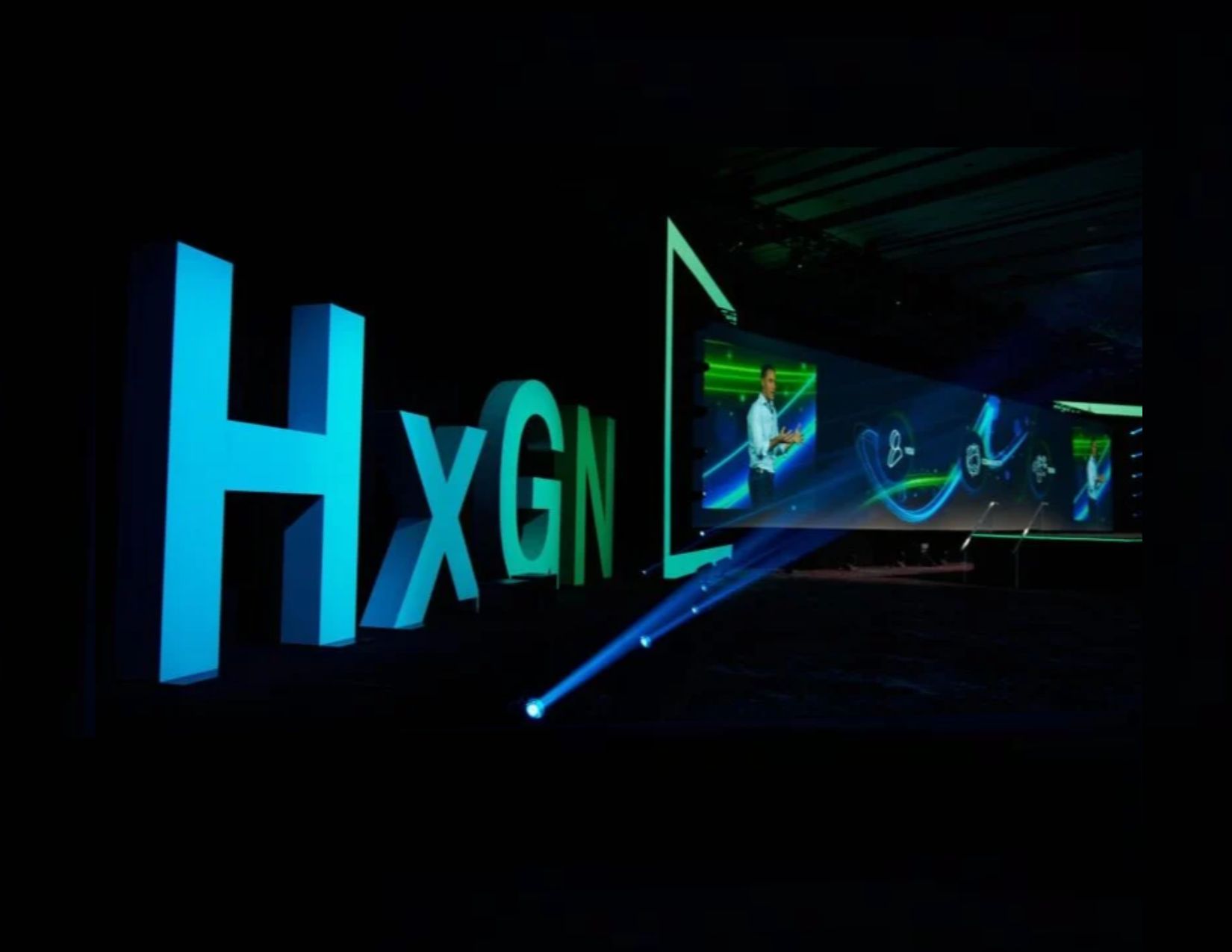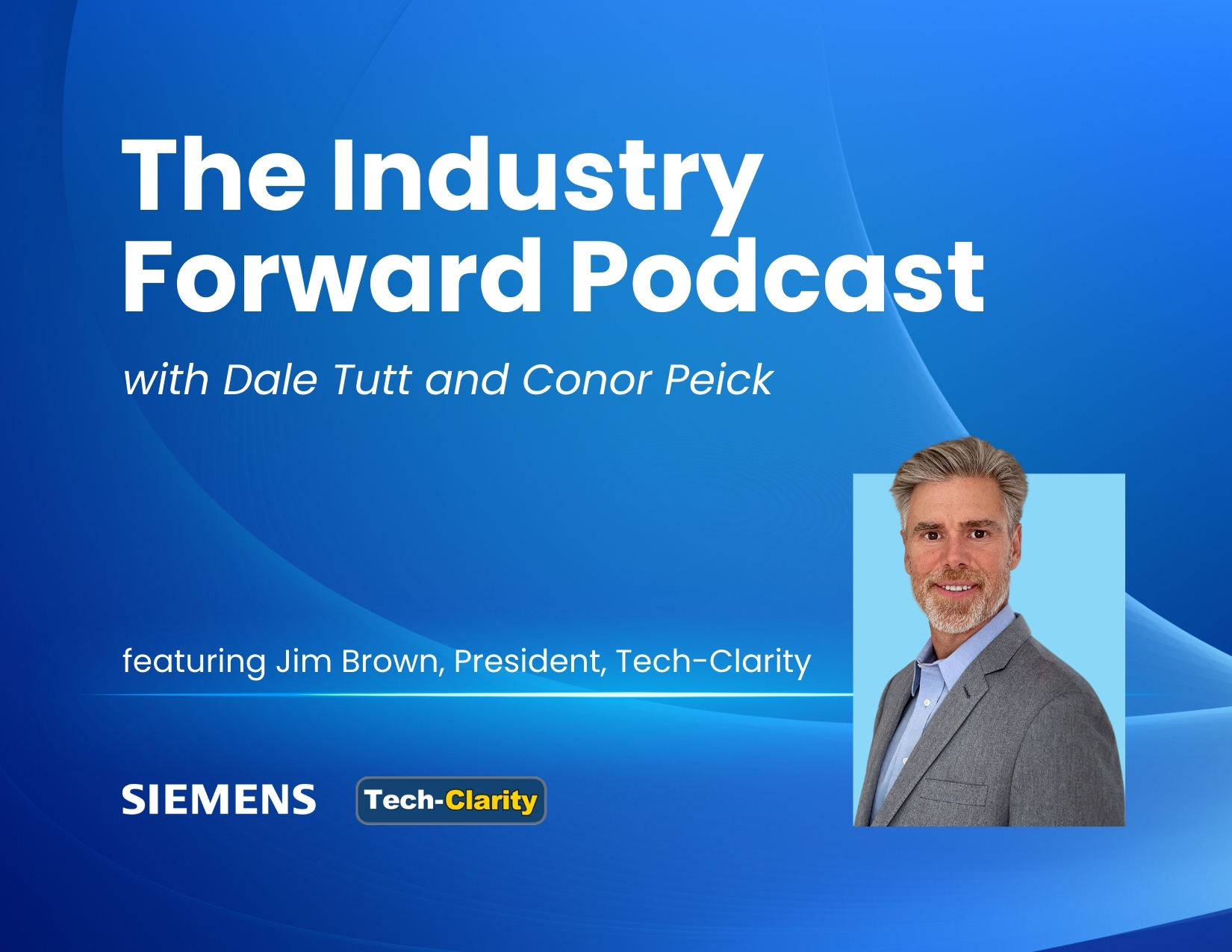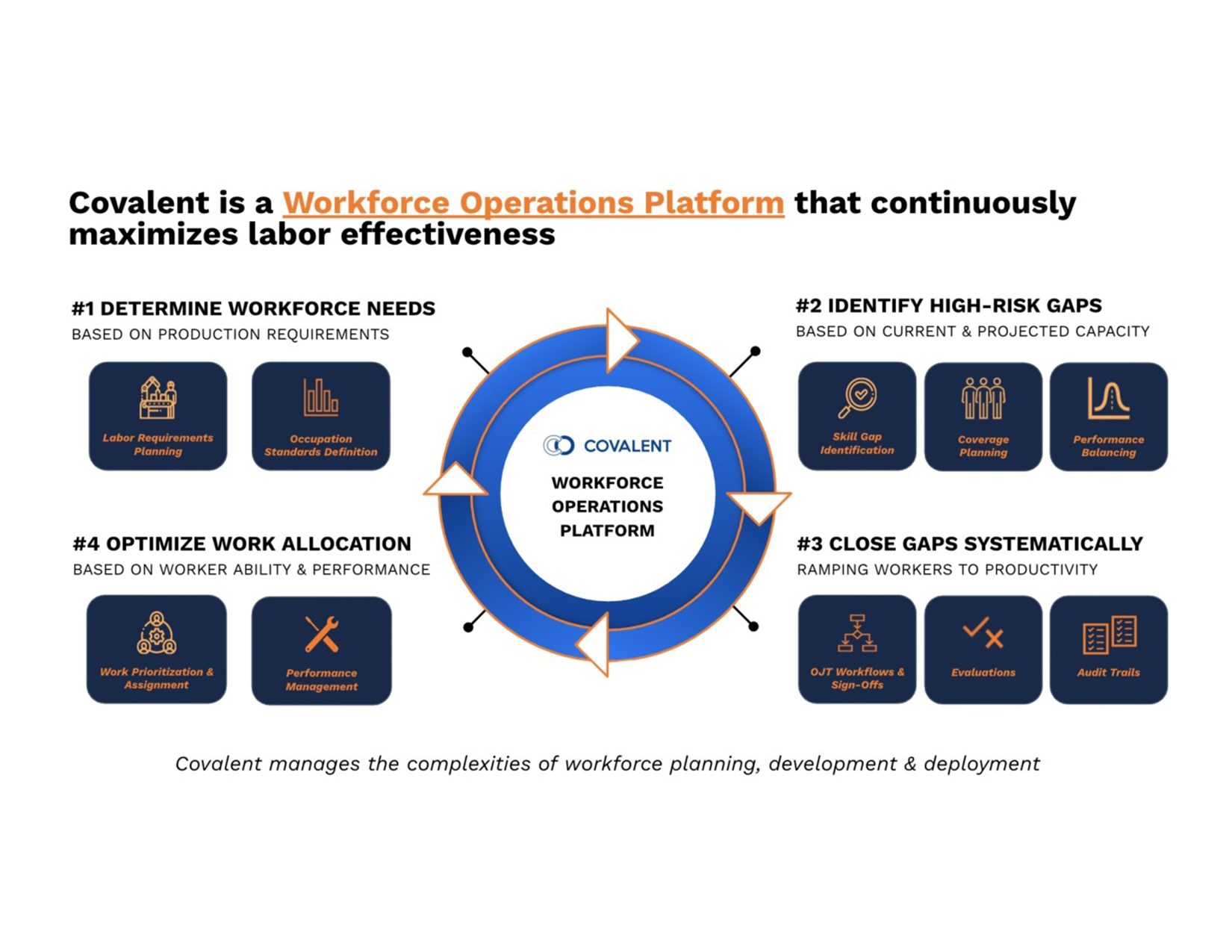What will help MedTech companies stay competitive in an era marked by rapid innovation, rising regulatory complexity, and global disruption? As the industry moves toward smarter, more personalized, and increasingly connected healthcare, MedTech manufacturers face mounting pressure to reduce time to market, improve patient outcomes, control costs, and ensure compliance without sacrificing quality or patient…
- Executive Summary
- Business Needs Driving Development Investment
- MedTech Development Challenges
- The Value of a Digital Thread
- 1. Requirements Management
- 2. Hardware Development
- 3. Software Development
- 4. Smart Connected Products
- 5. Regulatory Compliance
- 6. Quality Management
- 7. Plan for Manufacturing
- 8. Service & Post-Market
- Adoption and Implementation
- Vendor Considerations
- Specific Company Needs
- Conclusions and Next Steps
- Acknowledgments
Executive Summary
MedTech Opportunities By 2030, one in six people worldwide will be over 60, which will lead to an increase in age-related disorders. Additionally, there has been a rise in chronic diseases, such as diabetes, among younger populations. Trends like this are leading to the development of novel treatment and therapy options. This significant surge in innovation is evident in the 19,100 submissions the FDA received in 2023, along with the record 167 breakthrough designations it granted. Artificial intelligence (AI) is driving even more innovation as the FDA has now authorized over 1,000 AI-enabled devices. Given these trends, the global MedTech market is projected to grow 6.5% annually through 2032.5 The companies that thrive will likely be those that prioritize novel innovations, as incremental improvements won’t be enough. R&D excellence will be essential for growth. Challenges to Overcome Despite the strong market potential, MedTech companies face increasing regulatory complexity, rising costs, and growing product complexity, all of which reduce R&D productivity. To succeed, manufacturers must look beyond minor process improvements. Life sciences leaders see digital transformation as critical to success. To support digital transformation, MedTech companies need an integrated product development solution that connects hardware, software, quality, manufacturing, and service. This solution should enable traceability, compliance, and collaboration, thereby reducing risk, accelerating innovation, and improving outcomes. How to Use This Guide This guide comprises four major sections covering software tool functionality, service requirements, vendor attributes, and special company considerations. Each section includes a checklist of key requirements to support your selection process. While it is not an all-encompassing requirements list, it provides a high-level overview of criteria considerations.
The Value of a Digital Thread
 Operational Resilience
As regulations tighten and risks rise, full traceability has become critical. MedTech companies must demonstrate how decisions are made, how changes affect safety and performance, and maintain compliance from design to post-market support. Legacy systems cannot maintain this end-to-end visibility. A digital thread, enabled by an integrated solution, supports traceability, audit readiness, and proactive quality management.
Overcome Silos
A digital thread links requirements, design, engineering, manufacturing, quality, and service, making every decision traceable, every change visible, and every team aligned. Traceability accelerates root cause analysis, simplifies compliance, and improves first-time-right development. When requirements are linked to test results, quality and regulatory assurance become built-in.
By integrating Application Lifecycle Management (ALM), Product Lifecycle Management (PLM), Quality Management Systems (QMS), ERP, Manufacturing Execution Systems (MES), and Service Lifecycle Management (SLM), companies improve collaboration, manage requirements, plan for manufacturing, and leverage real-world service data in a shared digital environment. This integration yields numerous business benefits (see graphic).10
Prepare for the Future
This approach enables MedTech companies to transition from document-based processes to data-driven development, integrated quality systems, and connected service operations. It provides the agility needed to thrive in today's disruptive environment. The right solution will also support next-generation capabilities like AI, digital twins, and open interoperability.
Operational Resilience
As regulations tighten and risks rise, full traceability has become critical. MedTech companies must demonstrate how decisions are made, how changes affect safety and performance, and maintain compliance from design to post-market support. Legacy systems cannot maintain this end-to-end visibility. A digital thread, enabled by an integrated solution, supports traceability, audit readiness, and proactive quality management.
Overcome Silos
A digital thread links requirements, design, engineering, manufacturing, quality, and service, making every decision traceable, every change visible, and every team aligned. Traceability accelerates root cause analysis, simplifies compliance, and improves first-time-right development. When requirements are linked to test results, quality and regulatory assurance become built-in.
By integrating Application Lifecycle Management (ALM), Product Lifecycle Management (PLM), Quality Management Systems (QMS), ERP, Manufacturing Execution Systems (MES), and Service Lifecycle Management (SLM), companies improve collaboration, manage requirements, plan for manufacturing, and leverage real-world service data in a shared digital environment. This integration yields numerous business benefits (see graphic).10
Prepare for the Future
This approach enables MedTech companies to transition from document-based processes to data-driven development, integrated quality systems, and connected service operations. It provides the agility needed to thrive in today's disruptive environment. The right solution will also support next-generation capabilities like AI, digital twins, and open interoperability.
Adoption and Implementation
Accelerate Adoption To realize the expected value of the solution, it’s essential to drive adoption across teams, ensure systems integrate, and support long-term scalability. In a high-stakes, regulated environment, MedTech companies must transition with minimal disruption while transforming digitally. Why it Matters A modular, scalable architecture lets you start small and expand, minimizing disruption. A cloud-based deployment improves performance and global accessibility. Seamless integration with ERP, MES, and QMS reduces friction for cross-functional adoption. Flexible workflows and customizable UIs accommodate different process maturities and user roles, boosting usability. Low-code/no-code tools let admins adapt workflows, forms, and templates without heavy IT involvement. Combined with built-in analytics further supports adoption and performance. MedTech-specific templates, best-practice workflows, and structured onboarding all accelerate time to value. Validation-ready solutions simplify maintaining compliance under Computer Software Assurance (CSA).Conclusions and Next Steps
Prepare for the Future The MedTech sector is facing a perfect storm of challenges, including tightening regulations, geopolitical instability, rising costs, and constant pressure to innovate. To stay competitive, manufacturers must not only ensure product quality and patient safety, they must also build agility, resilience, and efficiency into their core processes for designing, developing, manufacturing, and servicing products. This requires a fundamental shift from fragmented systems and manual processes to a unified solution. These challenges jeopardize not only efficiency but also compliance, customer satisfaction, and even patient safety. The right solution can eliminate these bottlenecks by connecting every phase of the product lifecycle, integrating quality and compliance by design, and providing the digital agility that MedTech organizations need to thrive in a rapidly changing environment. Next Steps Use this buyer’s guide to define your organization’s priorities and must-have capabilities. Begin evaluating solution providers that offer integrated PLM, ALM, QMS, and service lifecycle tools tailored to the MedTech industry. Look for platforms that support regulatory compliance, multi-disciplinary collaboration, and scalable deployment. Engage cross-functional stakeholders early to align on goals and ensure a successful transformation. *This summary is an abbreviated version of the ebook and does not contain the full content. For the full report, please visit our sponsor PTC. If you have difficulty obtaining a copy of the research, please contact us. [post_title] => Buyer’s Guide for MedTech [post_excerpt] => [post_status] => publish [comment_status] => open [ping_status] => open [post_password] => [post_name] => medtech-buyers-guide [to_ping] => [pinged] => [post_modified] => 2025-09-17 09:57:38 [post_modified_gmt] => 2025-09-17 13:57:38 [post_content_filtered] => [post_parent] => 0 [guid] => https://tech-clarity.com/?p=22809 [menu_order] => 0 [post_type] => post [post_mime_type] => [comment_count] => 0 [filter] => raw ) [1] => WP_Post Object ( [ID] => 22937 [post_author] => 2572 [post_date] => 2025-09-16 23:35:29 [post_date_gmt] => 2025-09-17 03:35:29 [post_content] =>
Recently, we attended Realize LIVE 2025 events in both Detroit and Amsterdam. During these events, Siemens presented a clear and cohesive vision for helping customers manage increasing product complexity through digital transformation. This vision incorporates AI, cloud technology, a comprehensive digital twin, and an industry-tailored digital threads.
Across multiple presentations, starting with the vision shared by Siemens Digital Industries Software CEO Tony Hemmelgarn, Siemens positioned itself as a company dedicated to solving practical engineering challenges while embedding intelligence directly into workflows, integrating advanced simulation and AI, and closing the loop between design, manufacturing, and operations.
It was a wide-ranging program, but several consistent themes demonstrated how Siemens plans to realize this vision. While we can't cover everything discussed during the multi-day event, here are some highlights that stood out to us.
Key Themes
1. Tackling the Fundamentals
While new technologies like AI and immersive engineering draw attention, Tony Hemmelgarn reminded attendees that some of the most critical engineering challenges are deceptively "unsexy." He highlighted BOM management as an example. "It's not the most glamorous part of what we do," he said, "but if you can't manage your BOMs effectively, you can't make the right product, at the right time, at the right cost."
BOM management has become increasingly complex due to product variation, shorter cycles, and cross-domain dependencies. By embedding BOMs into the digital thread and connecting them to design, simulation, and manufacturing execution, service, and even supply chain, Siemens aims to prevent data mismatches and costly downstream errors. They highlighted several Teamcenter enhancements they’ve worked on:
- A 20x performance improvement over the past 18–24 months.
- A rules-based configurator that helps companies like GM validate buildable vehicle configurations.
- Out-of-the-box variant management tools replace years of costly customization in sectors such as mobile devices.
This focus on fundamental engineering execution indicates Siemens' commitment to solving core problems while also delivering next-generation technology.

2. AI as an Embedded Capability
Siemens positioned AI as an embedded capability that "works in the background," enhancing productivity without requiring process changes. Instead of being offered as a separate product line, AI is integrated throughout the Siemens Xcelerator portfolio, manifesting in generative design, automated simulation setup, manufacturability checks, and lifecycle intelligence, among many other areas.
We have been monitoring AI adoption, usage, and benefits through multiple studies. In our annual survey, Executive Strategies for Sustainable Business Success 2025, we found that since 2024, the percentage of companies reporting business value from AI has increased by an impressive 62%. In fact, AI was the technology most frequently cited as providing substantial value. Another research study, Making Manufacturing Analytics and AI Matter, indicated that AI is the technology most likely to yield a rapid time to benefit compared to others.

Tony shared an example of AI-enabled BOM management, "We asked Teamcenter to analyze warranty hotspots. AI interpreted severity and growth potential, pinpointed a problematic connector, created a change request, assessed supply chain risks, and found the best replacement, all automatically documented and visible to stakeholders."
This flow, from detection to resolution, demonstrates how Siemens is incorporating AI to accelerate decision-making, break down silos, and turn data into actionable insight. Joe Bohman further illustrated these capabilities by describing AI-assisted design optimization that happens in real time and design validation that flags production risks.
Tech-Clarity's research, The Business Value of Reducing Engineering Time Wasters, found that 96% of surveyed companies acknowledge that lost engineering productivity leads to significant business costs due to missed deadlines, higher expenses, decreased innovation, and poor quality. AI-embedded workflows like this show substantial potential for overcoming these challenges.
3. Simulation at the Core
Speakers repeatedly emphasized that simulation is central to Siemens’ comprehensive digital twin strategy, enabling companies to validate, optimize, and certify designs virtually, before committing to the physical product or prototype. The Simcenter portfolio supports multi-physics, system-level, high-fidelity simulation, with applications spanning multiple industries such as:
- Automotive: Thermal management and aerodynamics optimization with Simcenter Amesim and Simcenter STAR-CCM+ to validate EV powertrains.
- Aerospace: Structural and aerodynamic optimization for next-generation aircraft.
- Medtech: Simulating surgical device performance and fluid dynamics in medical instruments to validate compliance.
- Semiconductor: Thermal and structural analysis for chip packaging, ensuring reliability in high-density designs.
The recent Altair acquisition adds electromagnetic modeling and AI-driven process optimization, complementing Simcenter's existing capabilities. Altair SimSolid is a particularly exciting addition, as it eliminates the time-consuming geometry preparation and meshing process for analysis, providing design engineers with easier access to simulation for design guidance. During the Media and Analyst session, they also demonstrated simulation capabilities beyond Simcenter in EDA to support semiconductor lifecycle management and board design optimization.
4. The Digital Thread and the Comprehensive Digital Twin
At the core of Siemens' vision is the digital thread, an execution framework that links design, sourcing, simulation, manufacturing, supply chain, and service data in a cohesive flow. This framework also serves as the foundation for Siemens' comprehensive digital twin, which not only represents the product, but also encompasses production processes and operational behavior over time.
Siemens presented digital thread use cases spanning multiple industries, for example:
- Automotive: Thermal management and aerodynamics optimization with Simcenter Amesim and Simcenter STAR-CCM+ to validate EV powertrains.
- Aerospace: Structural and aerodynamic optimization for next-generation aircraft.
- Medtech: Simulating surgical device performance and fluid dynamics in medical instruments to validate compliance.
- Semiconductor: Thermal and structural analysis for chip packaging, ensuring reliability in high-density designs.
The key takeaway is that data should not merely be stored; it must be connected, contextualized, and utilized to inform better decisions throughout the product lifecycle.

5. Immersive Engineering and Human-Centered Design
During the NX keynote, Robert Haubrock introduced Immersive Engineering featuring a purpose-built Sony headset with "4K resolution per eye," which is available now. This resolution exceeds what the human eye typically perceives. Siemens views this technology as a tool for more intuitive design reviews, allowing engineers to walk through models, identify spatial issues, and collaborate in real-time. Bob emphasized, "The only way to understand it is to put it on your head." Beyond enhancing productivity, Siemens positions these immersive tools as appealing to the next generation of engineers, accustomed to interactive, high-fidelity experiences from the world of gaming. Our surveys and discussions with manufacturers show that AR/VR adoption is still low, but we believe it can provide significant value, especially as innovations around complementary technologies grow.
6. Modular Access and Broader Reach
Siemens highlighted the scalability of its design platform, Designcenter, which encompasses both NX and Solid Edge. For more on Designcenter, see our previous commentary in A Siemens NX Update: Extending Access and MBE. With this platform, the company is committed to making advanced capabilities more accessible by offering value-based licensing models. This approach allows customers to access features without investing in full enterprise suites.
Further, Siemens continues solidifying its position as a foundational technology provider, claiming that over 70% of the global solid modeling market relies on its PLM Components technology, including its kernel, Parasolid, also common across both Solid Edge and NX. This strategy promotes openness with third-party applications, facilitating seamless data flow between systems that use the same kernel. Additionally, this foundation supports AI-based applications that can leverage data across various platforms and tools.

7. Extending Value with Low-Code
Siemens continues to expand access to digital capabilities through Mendix, its low-code application development environment. Mendix enables non-IT specialists to create applications, adapt core applications, automate workflows, and integrate data. By doing so, low-code technology broadens the reach of the digital thread across the enterprise, accelerates transformation, and allows more stakeholders to participate in problem-solving. Mendix extends Siemens Xcelerator capabilities and promotes further adoption by allowing companies to develop purpose-built, composable applications to meet the unique needs of their people. For more of our analysis on Mendix please see Adapt and Extend Applications with Mendix.
8. Cloud Strategy
Siemens' cloud vision centers on delivering its Siemens Xcelerator portfolio as SaaS, with offerings such as NX X, Teamcenter X, and other "X" solutions. Their approach focuses on flexibility, scalability, and continuous updates, eliminating the IT overhead associated with traditional deployments. By hosting design, engineering, and manufacturing solutions in a secure, integrated cloud environment, Siemens aims to enhance collaboration, simplify adoption, and make emerging technologies like AI more readily available to customers. Tech-Clarity's research, The Business Value of Reducing Engineering Time Wasters, respondents reported that cloud-based solutions were implemented in nearly 50% less time than non-cloud alternatives. Further, 78% of those who described their implementation as "easy" had deployed a cloud-based solution.
Strategic Implications
In summary, here are some key strategic implications from the vision presented at the events:
- Embedded AI: This approach utilizes AI as an engineering tool to enhance existing workflows rather than replace them.
- Simulation-First Design: This strengthens Siemens' digital twin strategy, bolstered by the recent Altair acquisition.
- Attention to Fundamentals: Emphasizing basics like Bill of Materials (BOMs) helps reinforce credibility with engineering teams.
- Immersive Tools: These tools have the potential to accelerate collaboration and attract new talent; however, they will need to demonstrate proven return on investment (ROI).
- Digital Thread + Comprehensive Digital Twin: This combination creates a systems-of-systems advantage that may make it difficult for point solutions to compete.
- Cloud-First Delivery: This approach may facilitate faster adoption of AI and simulation technologies while minimizing IT friction.
Our Take
One of the notable aspects of Siemens' presentations was the balance between forward-looking innovation and the practical realities of day-to-day engineering. Exciting concepts like high-fidelity simulation, AI-assisted design, and immersive virtual reality (VR) were complemented by a strong emphasis on BOM management and the execution framework of the digital thread. This demonstrates Siemens' understanding that attention to fundamental aspects is just as important as pursuing breakthroughs.
We look forward to seeing how Siemens evolves its vision into mainstream engineering practices, especially with the exciting developments in physics AI that promise to make simulation tools even more accessible.
Tech-Clarity's research, How to Engineer Innovation, found that an overwhelming 99% of respondents find benefits in using simulation to explore design ideas to innovate and optimize designs in less time. Still, most agree that they could leverage simulation more effectively than they currently do. Integrating AI could be a key factor in unlocking even greater value from simulation.
Thanks
Thank you to Shaun Ennis, Heike Hofmann, and Julia Martin for the invitation and all the coordination to ensure we made the most of our time at the event. We'd also like to extend a special thanks to Brenda Discher, George Rendell, Tom Spangler, S. Ravi Shankar, Jean Claude Ercolanelli, and Jennifer Ferello for their thoughtful discussions and meeting with us one-on-one to answer our questions.
[post_title] => Siemens Realize LIVE 2025: A Vision for AI, Simulation, and Immersive Engineering in a Connected Digital Thread [post_excerpt] => [post_status] => publish [comment_status] => open [ping_status] => open [post_password] => [post_name] => siemens-realize-live-2025 [to_ping] => [pinged] => [post_modified] => 2025-10-01 23:37:00 [post_modified_gmt] => 2025-10-02 03:37:00 [post_content_filtered] => [post_parent] => 0 [guid] => https://tech-clarity.com/?p=22937 [menu_order] => 0 [post_type] => post [post_mime_type] => [comment_count] => 0 [filter] => raw ) [2] => WP_Post Object ( [ID] => 22467 [post_author] => 2572 [post_date] => 2025-09-16 09:06:29 [post_date_gmt] => 2025-09-16 13:06:29 [post_content] =>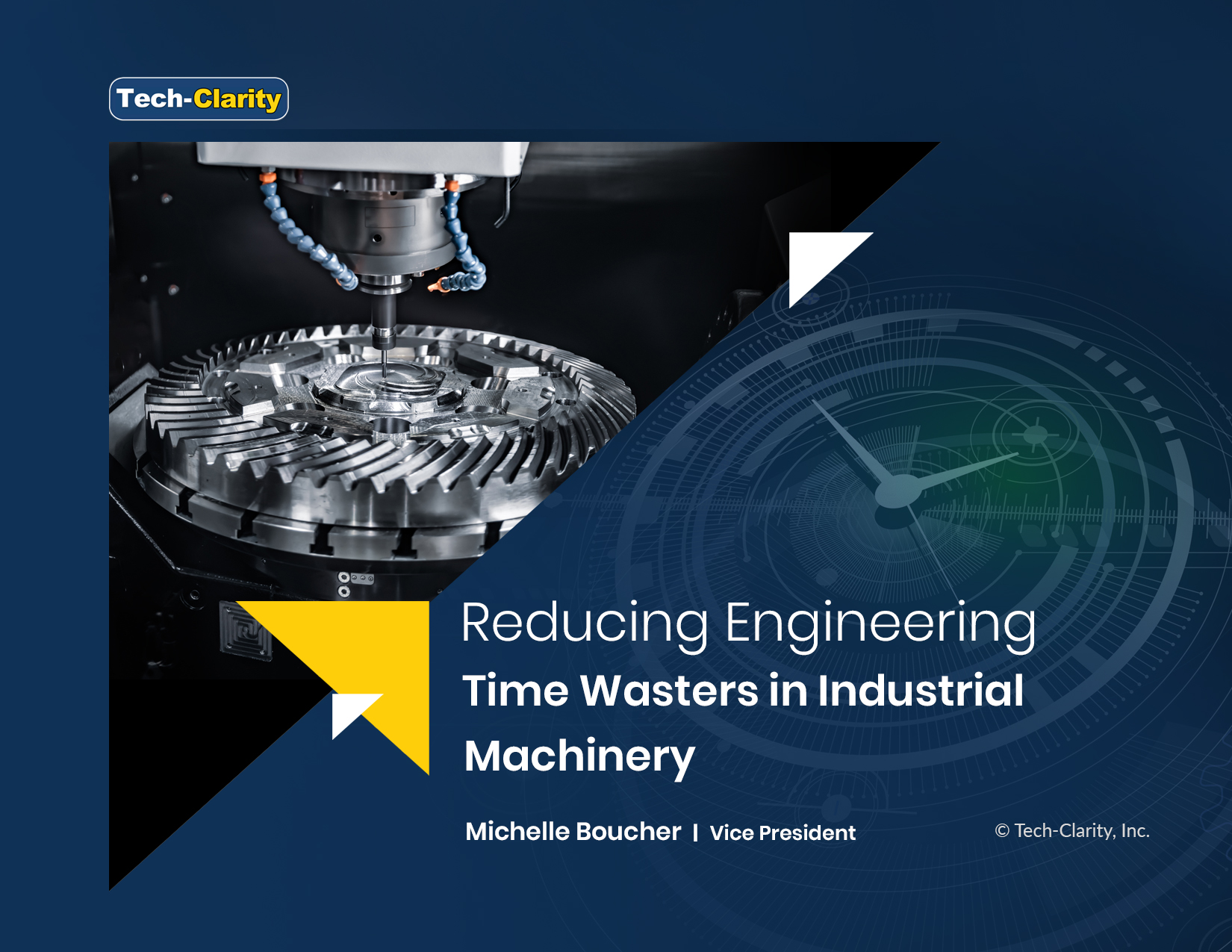 How can machine builders improve engineering productivity?
Industrial machinery has become increasingly complex, with even more mechanical components, electronics, and software. Customer needs for improved maintainability, increased automation, and better efficiency have driven this complexity further. Engineers are critical to successfully meet these requirements. Yet, engineers regularly lose productivity to non-value-add tasks that not only rob them of their ability to innovate, but also threaten their company’s ability to compete, differentiate, and grow. Imagine the potential of identifying and removing the most common non-value-add activities engineers face and empowering them to focus on designing better machines.
This research examines how engineers spend their time, where they lose productivity, and the impact on the business. It then identifies solutions and approaches to reduce time wasters. Based on a survey of 228 manufacturers across industries, this report shares the results of the industrial equipment industry and looks at their challenges and opportunities from the perspective of industrial machinery companies.
Please enjoy the summary* below. For the full research, please visit our sponsor, Siemens (registration required).
This report is based off the research published in The Business Value of Reducing Engineering Time Wasters which takes a look across all industries.
For other industry-specific related research, read:
How can machine builders improve engineering productivity?
Industrial machinery has become increasingly complex, with even more mechanical components, electronics, and software. Customer needs for improved maintainability, increased automation, and better efficiency have driven this complexity further. Engineers are critical to successfully meet these requirements. Yet, engineers regularly lose productivity to non-value-add tasks that not only rob them of their ability to innovate, but also threaten their company’s ability to compete, differentiate, and grow. Imagine the potential of identifying and removing the most common non-value-add activities engineers face and empowering them to focus on designing better machines.
This research examines how engineers spend their time, where they lose productivity, and the impact on the business. It then identifies solutions and approaches to reduce time wasters. Based on a survey of 228 manufacturers across industries, this report shares the results of the industrial equipment industry and looks at their challenges and opportunities from the perspective of industrial machinery companies.
Please enjoy the summary* below. For the full research, please visit our sponsor, Siemens (registration required).
This report is based off the research published in The Business Value of Reducing Engineering Time Wasters which takes a look across all industries.
For other industry-specific related research, read:
- Reducing Engineering Time Wasters in Aerospace & Defense
- Reducing Engineering Time Wasters in Heavy Equipment
- Reducing Engineering Time Wasters in Consumer Products
- Reducing Engineering Time Wasters in Shipbuilding
Table of Contents
- Executive Summary
- Product Development Is Critical to Business Strategies
- The Time Wasters
- Implications of Time Wasters to the Business
- A Solution to Avoid Time Wasters
- Business Value from PLM
- Extending PLM Use Results in Greater Satisfaction
- How Companies Implement PLM
- Additional Values Due to the Cloud
- Conclusions
- Recommendations
- About the Research
- Acknowledgments
Executive Summary
Engineers Impact Business Success Engineering is critical to exceptional machine design. Likewise, engineers are crucial to ensure designs incorporate customer requirements, stay within budget, and meet delivery dates. Therefore, empowering engineers is key to the successful execution of business strategies. Too Many Time Wasters Unfortunately, engineers report spending too much time on non-value-added work with too many interruptions, taking them away from critical innovation work. Furthermore, 96% of surveyed equipment companies say this loss in engineering productivity comes at a significant business cost due to missed deadlines, higher costs, and less innovation. To overcome productivity losses, one approach is to manage product data better and make it accessible to those who need it, when they need it. Reclaiming Wasted Time This report identifies substantial engineering time wasters in the industrial machinery industry by examining survey results of industrial equipment manufacturers. The analysis focuses on these results from the perspective of an industrial machinery company. This report explores how companies of all sizes reclaim lost time by examining the use and value of PLM (Product Lifecycle Management) solutions to centralize data across multiple domains, manage processes, and collaborate better. Incidentally, PLM users reported fewer changes due to outdated information and errors, significantly reducing non-value-added work and shortening development times. This report also examines how companies select and use PLM solutions, including cloud-based implementations. Product Development Is Critical to Business Strategies
Product Development Is Critical to Business Strategies
Business Strategies for Equipment Manufacturers of All Sizes
To understand what’s most important to equipment manufacturers of all sizes, Tech-Clarity asked about their business strategies (see graph). No matter the approach, the focus is on better equipment, either developing new offerings, improving them, or expanding their appeal.
Equipment companies are more likely to differentiate through product quality, performance, and innovation rather than compete on cost. From an industrial machinery company’s perspective, it is better to have superior offerings with a predictable cost rather than undercut competing bids with the lowest price. Winning a bid that is priced too low will only cut into margins, compromising profitability. Instead, high quality and performance can justify a higher price that provides more cushion to maintain profitable margins. Their brand differentiation also relies on meeting customer requirements and promised delivery dates as a reputation for quality and reliability is one of the best strategies for winning future bids. However, to achieve this, industrial machinery companies must empower their engineers to support a predictable process at the time of the bid to deliver what's promised on time and on budget.
Why Engineering Time Wasters?
As industrial machinery companies strive to differentiate through greater automation, improved energy efficiency, and new service offerings, equipment continues to evolve into complex interconnected systems of mechanical components, electronics, and software. This complexity increases the risk of errors. Plus, the "one-off" nature to meet unique customer needs within a tight timeline puts even more pressure on engineers. Any delay or error may result in disappointed customers, putting future business at risk.
While there's a lot to manage, supply chain disruptions can create opportunities for suppliers as OEMs look for new sources for components and subsystems. However, engineers need to be ready to respond to the increased demand. In other cases, machine designers must quickly adapt when supplied components come from a different supplier. Regardless of the opportunity, industrial machinery companies must empower their engineers to deliver value by strengthening the company's product development capabilities to win customer loyalty.
The Time Wasters
What Slows Engineers Down? The graph identifies the top engineering time wasters equipment manufacturers face. The findings highlight how much time engineers waste on non-value-added work. They need better ways to automate tedious tasks so engineers can focus more energy on ensuring customer requirements are met. Another top-ranking time waster, too many manual processes/bottlenecks, emphasizes this further. Interruptions Similarly, constant interruptions to answer questions, share data, and provide updates to others also slows engineers down. These interruptions break an engineer's train of thought and take them away from the work they need to focus on. Yet, exchanging data is critical to prevent engineers across domains from working with outdated data. Poor Collaboration Along with interruptions, equipment manufacturers find that poor collaboration also wastes time. The findings reveal that poor collaboration is a challenge for small, medium, and large companies alike. However, the integrated nature of machine design components, mechanisms, and systems requires good collaboration so that everyone on the development team, across all disciplines is aware of changes that impacts them. Otherwise, they waste time searching for needed data or redoing work. Difficulties consolidating engineering information across disciplines further complicates this. Redoing Work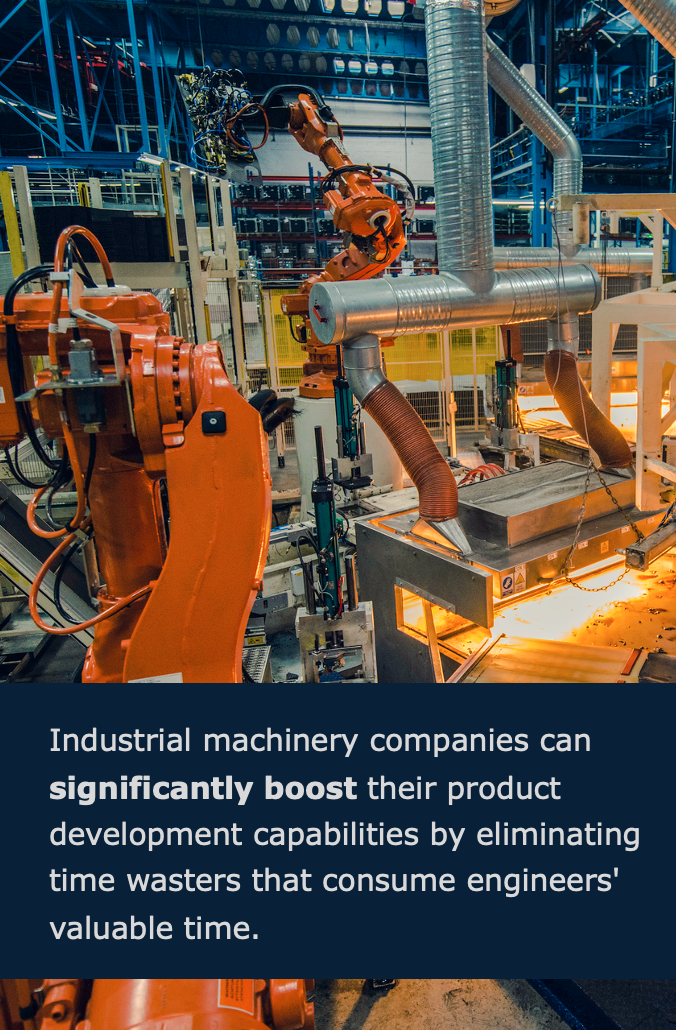 Machine designers also waste efforts redoing work. They waste time recreating what they can’t find or fixing errors due to outdated or conflicting information. Better methods to centralize access to data would help get that time back.
Machine designers also waste efforts redoing work. They waste time recreating what they can’t find or fixing errors due to outdated or conflicting information. Better methods to centralize access to data would help get that time back.
Conclusions
Reclaiming Lost Time Industrial machinery companies prioritize their future growth and sustained success on winning in the marketplace with better, differentiated equipment. To support this, they can significantly boost their product development capabilities by eliminating time wasters that consume engineers' valuable time. Equipment manufacturers find that PLM can empower their engineers to innovate by significantly reducing engineers' time on non-value-added tasks. As a result, they can enjoy a competitive advantage. In addition, technological advances, such as cloud-based offerings, can reduce implementation time, cost, and difficulty, making PLM more accessible. *This summary is an abbreviated version of the ebook and does not contain the full content. For the full report, please visit our sponsor Siemens. If you have difficulty obtaining a copy of the research, please contact us. [post_title] => Industrial Machinery: Reducing Engineering Time Wasters [post_excerpt] => [post_status] => publish [comment_status] => open [ping_status] => open [post_password] => [post_name] => industrial-machinery [to_ping] => [pinged] => [post_modified] => 2025-09-16 09:06:30 [post_modified_gmt] => 2025-09-16 13:06:30 [post_content_filtered] => [post_parent] => 0 [guid] => https://tech-clarity.com/?p=22467 [menu_order] => 0 [post_type] => post [post_mime_type] => [comment_count] => 0 [filter] => raw ) [3] => WP_Post Object ( [ID] => 22767 [post_author] => 2574 [post_date] => 2025-09-12 10:17:22 [post_date_gmt] => 2025-09-12 14:17:22 [post_content] =>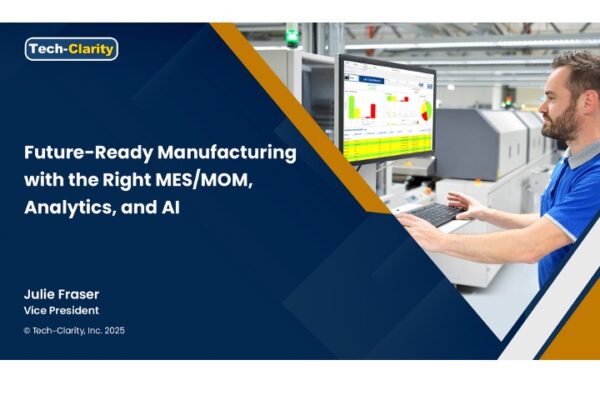 Given how fast technology and markets are changing, how can manufacturers of intelligent products ensure they are ready for what’s next? Future-ready manufacturing requires plant floor systems that go beyond traditional manufacturing execution systems (MES). With the full scope of manufacturing operations management (MOM), analytics, and artificial intelligence (AI), companies have a good opportunity to be agile enough to make the next pivot. This eBook explores all of that and more.
Please enjoy the summary* below. For the full research, please visit our sponsor iTAC Software (registration required).
Given how fast technology and markets are changing, how can manufacturers of intelligent products ensure they are ready for what’s next? Future-ready manufacturing requires plant floor systems that go beyond traditional manufacturing execution systems (MES). With the full scope of manufacturing operations management (MOM), analytics, and artificial intelligence (AI), companies have a good opportunity to be agile enough to make the next pivot. This eBook explores all of that and more.
Please enjoy the summary* below. For the full research, please visit our sponsor iTAC Software (registration required).
Table of Contents
- MES is Evolving
- MES, Analytics, and AI for the Journey
- End-to-End Operations Coverage and Control
- Functional Breath
- Connectivity for Data Flows
- Connector Characteristics
- Modern Future-Ready Architecture
- Analytics to Extend Data Value
- Flexible and Agile to Match Operations
- Suitable for Multi-Plant Collaboration
- Beyond Today's Realities
- Future-Ready MES Considerations
- Acknowledgments
Foundations for Future Success
Comprehensive Operational Software Given how fast high-tech products, materials, suppliers, and processes change, how can the manufacturing operation keep up and achieve business goals? Being future-ready is complex and multi-faceted, particularly for serialized high-tech manufacturing. These companies have particular requirements for manufacturing execution systems (MES) and the expanded functionality called manufacturing operations software (MOM). Ensuring the MES will evolve into the future has additional requirements. One of those is leveraging the data more fully for analysis. Combining MES with analytics and artificial intelligence (AI) can significantly enhance each technology's current and future value.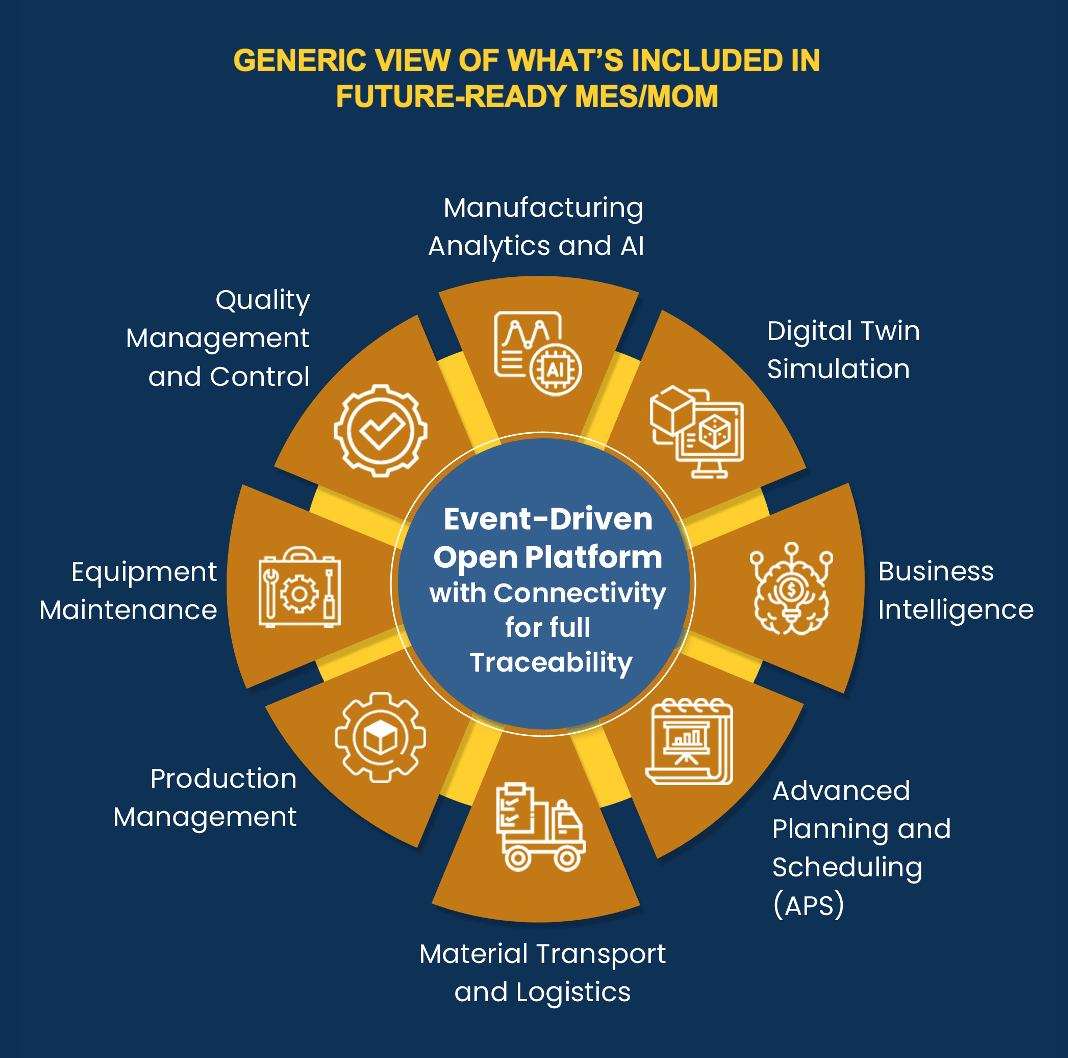
MES Is Evolving
MES Expands to MOM The face of modern MES is different than it was even a few years ago. One element is that the scope is more extensive. This is often considered an expansion from MES to MOM, with functions to support not only production but also quality, maintenance, and inventory inherently in the system, per the ISA95 model. More Data Makers of smart products typically also have far more data to process. MES must be ready to handle data feeds from equipment and industrial Internet of Things (IIoT) devices. In addition, many products are more complex than ever, with more variants, and all of these have serialized components at every level. MES for Quick Value Manufacturers want to gain value from software immediately. To accomplish that, companies are moving to more tailorable applications. With tailoring, software providers can focus more on the product than customizing code and laboring through each project. This means manufacturers get a good fit and quick time to value. Ready for Change Software must be flexible and adaptable to keep up with the pace of change in manufacturers’ products, materials, processes, and people. Beyond the physical, data requirements are also changing frequently. These changes come from shifting expectations for customer data, cybersecurity, sustainability, and new regulations. Analytics for Better Outcomes MES has always been a source of critical in-context data about operations, products, and processes. Performance dashboards and current-state views have long been part of MES. Today’s analytics and AI can sit inside MES to drive better operations and business outcomes. MES with advanced analytics and AI can also help troubleshoot causes, predict what will happen, compare options, and guide more effective action.Analytics to Extend Data Value
Analytics in MES Aim for data-driven decisions from the system for operators, data scientists, and engineers. MES with analytics pre-configured functionality is common. Beyond that, look for an open analytics platform for development. This enables third-party tools to come into play and supports multiple parties collaborating. AI and ML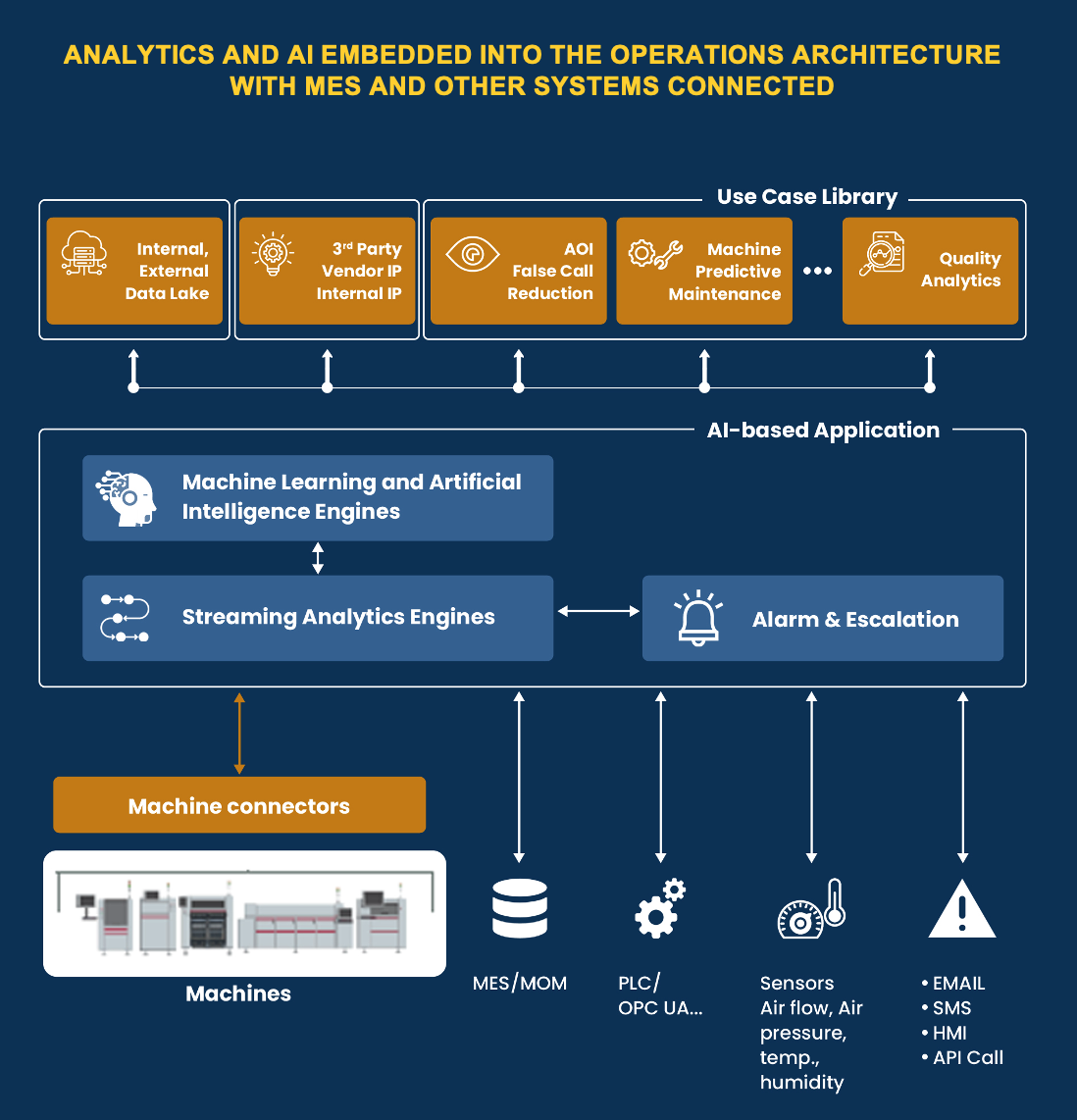 Modern software should include an engine for machine learning and artificial intelligence (ML/AI). Look for models trained based on the MES provider’s expertise. The AI capability must span specific production environments that the engineers know, not just data scientists. The beauty of ML, as the name suggests, is that it learns from reality. In this case, the MES data reflects reality and teaches the model. Sometimes, the MOM offering also includes a toolbox of algorithms that can deliver automated insights.
At the Speed of Operations
What’s crucial is that the analytics, AI, or ML provide results fast enough for the operation to use them effectively. Event streaming can add speed and agility. For maximum effectiveness, the system will also deliver alarms and escalation when anomalies occur. Decision-makers often need to know right away.
Optimizing Analytics
While basic analytics are standard for MES, some special factors can optimize analytics. These include:
Modern software should include an engine for machine learning and artificial intelligence (ML/AI). Look for models trained based on the MES provider’s expertise. The AI capability must span specific production environments that the engineers know, not just data scientists. The beauty of ML, as the name suggests, is that it learns from reality. In this case, the MES data reflects reality and teaches the model. Sometimes, the MOM offering also includes a toolbox of algorithms that can deliver automated insights.
At the Speed of Operations
What’s crucial is that the analytics, AI, or ML provide results fast enough for the operation to use them effectively. Event streaming can add speed and agility. For maximum effectiveness, the system will also deliver alarms and escalation when anomalies occur. Decision-makers often need to know right away.
Optimizing Analytics
While basic analytics are standard for MES, some special factors can optimize analytics. These include:
- Data quality and model or algorithm validation
- Analytics that process engineers can configure, not just IT
- Digital twin for testing algorithms and approaches
- AI support for system users
Beyond Today’s Realities
People-friendly MES does connect to equipment, but human interaction is crucial. We need humans in the loop for anomalies and new situations to ensure AI is on track. This means the system should provide visualization of data and status through intuitive UIs. Ongoing changes in reality mean the system must also be simple to set up, use, and change. Analytics and AI We are already in the age of analytics and AI in production operations. However, moving beyond where we are today will require a robust approach to analytics in all forms. For example, prescriptive analytics, which recommends actions to take in the future based on the past, will benefit from complete data sets and history. More sophisticated ML pattern recognition will likely also come online to spot anomalies in real-time and trigger alerts and action to prevent scrap and rework. Autonomous Future Many high-volume production tasks are tedious and repetitive. Some are automated, but many plants are not automated beyond a particular line, such as an SMT line. Autonomous operation for repetitive tasks and workflows is likely in the future. This will require an event-driven architecture that connects to every piece of equipment, data source, and data-consuming device in the operation. It will also require flexibility to change as conditions change. Ecosystem Connection There is also hope for industry-wide data connectivity standardization in the future. Organizations such as International Manufacturing-X6 are building out use cases for using industrial data across supply chains. The need for multi-company analytics and traceability is crucial, and software should consider new guidelines as it evolves. *This summary is an abbreviated version of the ebook and does not contain the full content. For the full report, please visit our sponsor iTAC Software. If you have difficulty obtaining a copy of the research, please contact us. [post_title] => Future-Ready Manufacturing with the Right MES/MOM, Analytics, and AI [post_excerpt] => [post_status] => publish [comment_status] => open [ping_status] => open [post_password] => [post_name] => future-ready-manufacturing [to_ping] => [pinged] => [post_modified] => 2025-09-12 10:26:34 [post_modified_gmt] => 2025-09-12 14:26:34 [post_content_filtered] => [post_parent] => 0 [guid] => https://tech-clarity.com/?p=22767 [menu_order] => 0 [post_type] => post [post_mime_type] => [comment_count] => 0 [filter] => raw ) [4] => WP_Post Object ( [ID] => 22928 [post_author] => 2572 [post_date] => 2025-09-10 23:25:38 [post_date_gmt] => 2025-09-11 03:25:38 [post_content] => We recently had the opportunity to speak with Denis Morais and Greg Goulanian from SSI. SSI offers specialized solutions for the design, engineering, construction, and maintenance of shipbuilding projects. We’ve known SSI for years and realized that their strategy had shifted so felt it was time for an update.
We recently had the opportunity to speak with Denis Morais and Greg Goulanian from SSI. SSI offers specialized solutions for the design, engineering, construction, and maintenance of shipbuilding projects. We’ve known SSI for years and realized that their strategy had shifted so felt it was time for an update.
Who Are They?
SSI focuses exclusively on the shipbuilding industry, with over 30 years of experience that has given them deep expertise in this highly specialized domain. Their two flagship offerings are:
- ShipConstructor – A CAD platform for the design, engineering, and construction of ships and offshore projects.
- ShipbuildingPLM – A lifecycle platform tailored to managing the complexities of the shipbuilding process, from concept to end-of-life.
How Are They Different?
Purpose-Built for Shipbuilding
SSI’s technology is designed specifically around how ships are engineered and built. Their data models, workflows, and terminology reflect the language and logic of shipbuilding, with native support for concepts like hulls, outfitting, and vessel configurations. Even within the same class of ship, design and manufacturing vary based on the shipyard, and SSI accounts for that. Their platform supports the design, construction, and maintenance of multiple hulls in a series, production planning, change and configuration management, and digital ship handover.

Fast Implementation / Time-to-Value
SSI says that their standardized implementation approach enables them to bring full shipbuilding PLM environments online in as little as 1.5 to 2 months. They say most projects go live within 2 to 6 months, even in complex defense environments. Their ability to import data and documents from legacy systems helps even smaller or repair-focused yards move quickly.
Expertise-Led Configuration
Every SSI implementation is led by people who know shipbuilding inside and out. This deep domain knowledge allows their team to deliver faster, more relevant, and lower-effort deployments for shipbuilding. All clients start with the same foundational data model, with customization happening at the workflow level, such as change approvals or configuration management. The result is a solution that fits naturally with how shipyards operate, without relying on heavy custom coding or large consultant teams.
Strong Technical Foundation
SSI’s PLM platform is powered by Aras, but extensively tailored to shipbuilding. They’ve built in custom data models that span requirements, work breakdown structures (WBS), MBSE, and shipbuilding-specific change and configuration management workflows, which they report enables a unified model that supports full traceability and engineering, planning, and production team collaboration. They’ve extended the platform to manage functional design, ship-specific WBS models, and Navy-specific requirements around approvals and lifecycle documentation.
Open Architecture
SSI has a fully open data model with complete API access. This openness allows shipbuilders to integrate SSI’s tools with external solutions, ERP, MRP, MES, CFD software, training tools, or visualization platforms like Canvas GFX.

How Do They Help?
SSI helps their customers solve a wide variety of challenges:
Planning and Scheduling
SSI helps coordinate across the many partners involved in a ship build. From design agencies, contractors, or the shipyard itself, their shared platform facilitates schedule alignment and better decision-making, especially projects with complex workflows such as Navy-focused projects.
Early BOM Access and Long-Lead Purchasing
Shipyards often need to make early material purchases, like steel or piping, well before the full design is finalized. SSI enables the creation of preliminary BOMs to support those decisions, helping procurement teams act with more confidence and reducing the risks that come with long-lead items in evolving designs.
Cross-Partner Collaboration
SSI provides a common platform that enables real-time collaboration between all players in the shipbuilding ecosystem. Engineers, subcontractors, and manufacturers all work from the same source of truth, providing needed transparency as the design evolves.
Change Management and Compliance
SSI’s platform supports the specific requirements of defense programs, including Navy-specific approval workflows (such as for penetrations, the openings or holes cut into structural elements, such as bulkheads, decks, or hull sections) with full lifecycle traceability to support a digital thread. This traceability supports change management and compliance processes across one or multiple hulls.
Clash Detection and Model Integration
SSI enables simultaneous modeling of structure and outfitting, allowing yards to run clash detection early to catch potential problems in a digital environment, helping to avoid rework later on.

Our Take
Tech-Clarity’s research, published in Reducing Engineering Time Wasters in Shipbuilding, finds that 87% of companies developing complex products, such as ships, say lost engineering productivity comes at a significant business cost due to missed deadlines (reported by 63%), inability to stay on budget (44%), less innovation (38%), higher costs (38%), and poor quality (25%). In fact, 59% report that time wasted on non-value-added work is the top thing that slows engineers down.
Our research has found that those who have adopted PLM/PDM find it helps reduce much of this non-value-added work. Those working on complex products like ships report that PLM helps them in these ways:

We believe there’s a lot of opportunity for improvement in shipbuilding and these results show how a PLM solution could enable those improvements.
For an industry like shipbuilding, the specialized needs and high levels of complexity mean implementation industry expertise is essential. SSI’s ability to deliver fast, under-budget projects without heavy onsite support is a testament to how well their platform fits the unique needs of modern shipyards. We’re also watching with interest as SSI moves beyond engineering to support broader yard-wide objectives, and as they expand internationally.
Thanks again to Denis Morais and Greg Goulanian for the informative conversation.
[post_title] => SSI: Shipbuilding Platform That’s Purpose-Built from the Hull Up [post_excerpt] => [post_status] => publish [comment_status] => open [ping_status] => open [post_password] => [post_name] => shipbuilding-ssi [to_ping] => [pinged] => [post_modified] => 2025-10-01 23:27:43 [post_modified_gmt] => 2025-10-02 03:27:43 [post_content_filtered] => [post_parent] => 0 [guid] => https://tech-clarity.com/?p=22928 [menu_order] => 0 [post_type] => post [post_mime_type] => [comment_count] => 0 [filter] => raw ) [5] => WP_Post Object ( [ID] => 22756 [post_author] => 2572 [post_date] => 2025-09-10 07:00:57 [post_date_gmt] => 2025-09-10 11:00:57 [post_content] => What are your biggest electrical design challenges? We are researching electrical design, including top challenges, identifying the most time consuming tasks, the impact of greater automation, and how poor collaboration between electrical and mechanical engineers affects the development process. We will also use the results to identify best practices. The survey takes about 10 to 15 minutes.
If you are familiar with the electrical design work at your company, either by doing the design work yourself, collaborating with those who do, or managing electrical design teams, please take the survey to share your thoughts. As a thank you, we will send you a copy of the report summarizing the findings.
We are researching electrical design, including top challenges, identifying the most time consuming tasks, the impact of greater automation, and how poor collaboration between electrical and mechanical engineers affects the development process. We will also use the results to identify best practices. The survey takes about 10 to 15 minutes.
If you are familiar with the electrical design work at your company, either by doing the design work yourself, collaborating with those who do, or managing electrical design teams, please take the survey to share your thoughts. As a thank you, we will send you a copy of the report summarizing the findings.
 In addition, respondents will be entered into a drawing for one of 20 $25 Amazon gift cards.*
Individual responses will be kept confidential. Please feel free to forward this survey to others you feel have an opinion to share.
Thank you for your support, please check out our Active Research page for additional Tech-Clarity survey opportunities.
*See survey for eligibility rules
[post_title] => Accelerating Electrical Design Survey
[post_excerpt] =>
[post_status] => publish
[comment_status] => open
[ping_status] => open
[post_password] =>
[post_name] => electrical-design-survey
[to_ping] =>
[pinged] =>
[post_modified] => 2025-09-10 02:12:15
[post_modified_gmt] => 2025-09-10 06:12:15
[post_content_filtered] =>
[post_parent] => 0
[guid] => https://tech-clarity.com/?p=22756
[menu_order] => 0
[post_type] => post
[post_mime_type] =>
[comment_count] => 0
[filter] => raw
)
[6] => WP_Post Object
(
[ID] => 22746
[post_author] => 2
[post_date] => 2025-09-09 12:14:36
[post_date_gmt] => 2025-09-09 16:14:36
[post_content] =>
In addition, respondents will be entered into a drawing for one of 20 $25 Amazon gift cards.*
Individual responses will be kept confidential. Please feel free to forward this survey to others you feel have an opinion to share.
Thank you for your support, please check out our Active Research page for additional Tech-Clarity survey opportunities.
*See survey for eligibility rules
[post_title] => Accelerating Electrical Design Survey
[post_excerpt] =>
[post_status] => publish
[comment_status] => open
[ping_status] => open
[post_password] =>
[post_name] => electrical-design-survey
[to_ping] =>
[pinged] =>
[post_modified] => 2025-09-10 02:12:15
[post_modified_gmt] => 2025-09-10 06:12:15
[post_content_filtered] =>
[post_parent] => 0
[guid] => https://tech-clarity.com/?p=22756
[menu_order] => 0
[post_type] => post
[post_mime_type] =>
[comment_count] => 0
[filter] => raw
)
[6] => WP_Post Object
(
[ID] => 22746
[post_author] => 2
[post_date] => 2025-09-09 12:14:36
[post_date_gmt] => 2025-09-09 16:14:36
[post_content] => Introducing the Topic
We’ve been researching make-to-order (MTO) and engineer-to-order (ETO) approaches for over two decades and we’ve witnessed continued growth in product customization. We’ve also watched configuration approaches and technologies evolve. Two things have been consistent over time:
- Configured products are compelling for customers
- Configuring and making products to order is challenging for manufacturers
What else has changed? We recently surveyed over 200 companies that manufacture to-order products to find out.
Introducing the Expert
I recently had the opportunity to sit down with Rick Smith , Director of Engineer to Order Solutions at Siemens Digital Industries Software, to get his perspective on our survey and configuration and MTO (make-to-order) trends. I’ve worked with Rick on some of our research, including his participation as a contributing subject matter expert for our recent Making To-Order Product Configuration Profitable survey. I’m always excited to learn from his experience working with customers in the MTO and ETO (engineer-to-order) space.
Jim Brown
Hi Rick. Will you please introduce yourself and your company, and let us know your role with configurators and to-order products?
Rick Smith
I'm Rick Smith with Siemens Digital Industry Software. I'm a product manager for the Rulestream product line. Siemens has a very broad portfolio of engineering and manufacturing software, of which Rulestream is the solution for engineering automation. It works very closely with Teamcenter, our industry-leading PLM system. Rulestream interfaces directly through Teamcenter to a large number of the other solutions in the Siemens software portfolio, so it’s integrated to a complete set of design and CAE (Computer Aided Engineering, or simulation) tools.
Jim Brown
Rick, I always appreciate your enthusiasm as much as your expertise. What gets you jazzed about to-order manufacturing and configurators?
Rick Smith
The excitement goes back to the early 2000s when I discovered the profound impact an automation solution could have on the world of manufacturing complex products. I always suffered from the inefficiencies of the available tools and thought there had to be a better way to do it. In my early exposure to Rulestream (as a customer), I realized that it is a really different way of doing things, giving me the tools that I need to be more productive not only as an engineer but also across the whole business in terms of accuracy and efficiency.
Configuration Drivers
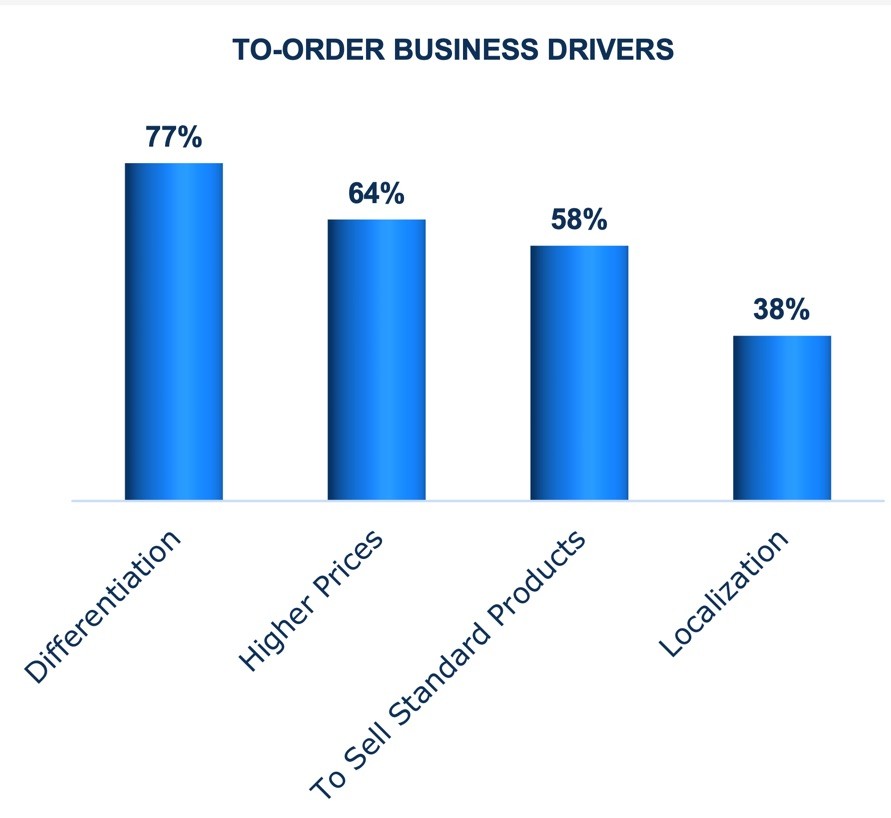
Jim Brown
Thanks Rick. I’m excited to talk about the research with you. The survey looked into why companies configure products. The results show a variety of reasons. The top two, differentiation and higher prices, are about the ability to attract business and profit from it. For them, it’s about revenue and profitability. But sometimes companies don’t have a choice. In fact, our studies often show that providing to-order products is a “must have” for their industry.
Rick, you’ve been working in the space for a long time. Why is making products to order so compelling?
Rick Smith
I think there are several reasons, and it depends on the company and the industry. For one industry, it may just be the nature of the beast. If you're building a solar or a wind solution, you want to use every square inch or cubic inch of space to generate as much income as possible. That means that you want to put up as many solar panels or as many turbines of the right size to fit the space available. Or, if it's a hydro dam, you want to get more kilowatt hours or KVA from the same amount of water. Can we get a more efficient turbine? Can we get more efficient distribution? All of those things require engineering to customize the solution to the unique requirements of the request. By choosing to be in this industry, you chose MTO.
Jim Brown
The next most common response is to sell standard products. In this case, selling customized products is a necessity for commercial rather than technical reasons. What creates this scenario?
Rick Smith
One way this happens is in industries that are commoditized or commoditizing. If customers are consolidating their spend and a manufacturer can offer customized products alongside their standard ones, they choose the company that can offer related products that are configurable, allowing that company to sell more standard products and become the supplier of choice.Making To-Order Product Configuration Profitable, Tech-ClarityMaking To-Order Product Configuration Profitable, Tech-Clarity
Or, they're in a commodity business and they recognized that if they can offer a customized solution at the same cost and lead time as their competitors are offering standard solutions they can take over the market. We had just one such company do that with a commercial air handler, a very competitive business, and they became the number one supplier of that product in the world.
Growth / Trends in Configuration

Jim Brown
Configured products are compelling and companies don’t seem to be able to get enough of them. Our research from five years ago showed that the majority of companies were increasing the amount of configuration in their products, and it jumped again during our latest study with 94% saying it will grow over the next five years.
Why do you think customization continues to grow?
Rick Smith
It's all the reasons that we just talked about that drive the desire to do it. Everybody wants a product that is tailored to their unique needs, right? But
I think more companies are moving towards it because their competitors are and they want to either lead or catch up. Just the HVAC example that we talked about, right? They killed their competitors because they offered a custom product.
I also think it’s because automation makes it more cost-effective. Engineering software can do more for to-order manufacturers than ever. It now takes them less effort to support customization across their business because the technology can accomplish more for them and is more integrated into other engineering and manufacturing applications.
Sales Best Practices
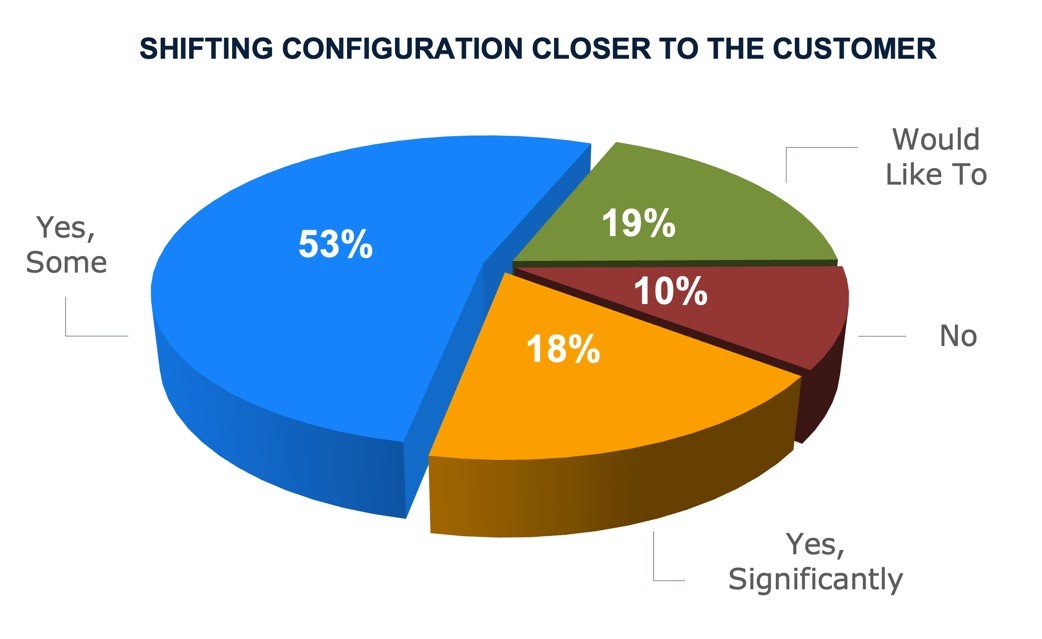
Jim Brown
One of the things we looked at in the survey was best practices to increase profits from to-order products across different aspects of their business, including engineering. I know you and I are both engineers, and we found best practices there, but let’s focus on sales. We analyzed what top performing companies do differently in the selling process.
One of the things that we saw was moving configuration closer to the customer, or “shifting left. About one-half of all respondents have taken steps to shift configuration left, such as from sales engineers to salespeople or from distributors to customer self-service. Almost all, a full 90% of responding companies, have, or would like to, shift configuration closer to the customer. Why do you think that the manufacturers are moving detailed configure order entry towards the customer?
Rick Smith
Making To-Order Configuration Profitabile, Tech-ClarityPart of it I believe is due to demographics of the people who are buying. I was a chalkboard and slate guy. There are people today that were born with technology in their hands that expect the ability to chat to their friends at any point in time. So their expectation is I want to do whatever I want to do when I want to do it. They want self-service.
I think part of it is to be easier to buy from. So, we always talk about the sales process. I want to talk about the buying process, which is the more important part. Customers are going to buy from whoever they can buy from the easiest, so long as it is a good solution at a competitive price. It doesn't even have to be the lowest price necessarily, but they're the easiest to buy from. The same is even more true for distributors that may carry different product lines. They don’t necessarily care which line they sell, so they are motivated to sell the one that is easiest to order.
Another proof point that the shift left is happening because is that the survey says companies need mobile device support. Ten years ago, you were not going to buy anything on your phone. Now, it's required because people expect to be able to configure and order things from their mobile device.
Jim Brown
Great insights. Well, we know it’s valuable because Top Performers are 74% more likely to have significantly shifted configuration left than poorer performing companies. As I mentioned, we also identified best practices for engineering techniques, but we’ll have to save that for another interview.
Supporting Technologies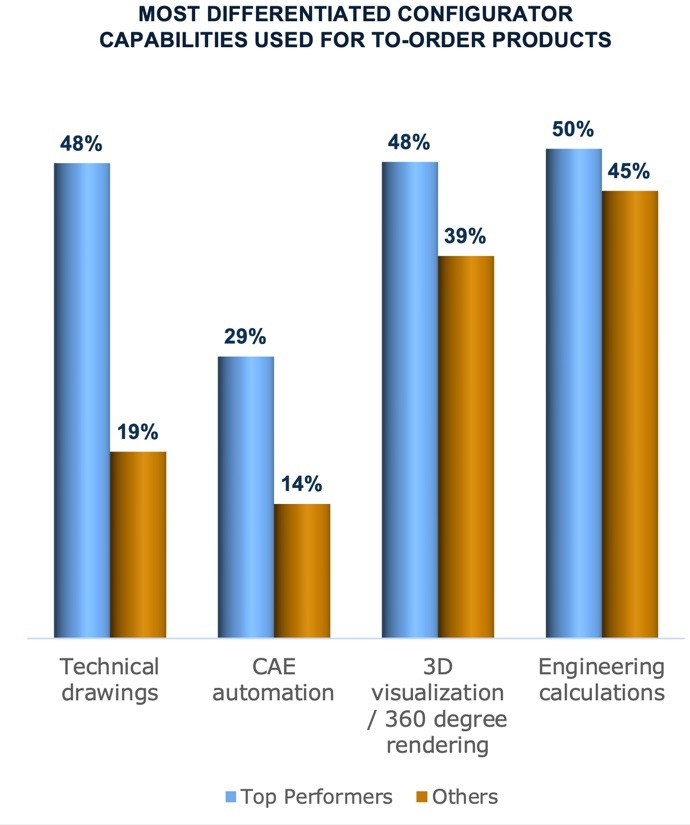
Jim Brown
There are a variety of technologies available to help companies reduce (or perhaps embrace) the complexity of configuration. Sales configurators, engineering configurators, and simpler CPQ solutions. Top Performers are more likely to use configurators in general. But what really stood out is that they’re also more likely to use advanced configuration functions like of drawing creation, CAE automation, 3D visualization, and engineering calculations.
Rick, this reminds me of the automation you spoke about earlier. In the survey report, we interviewed a customer who says they reduced engineering hours from CAD automation that works hand-in-hand with their PLM. The Top Performers also say it helps them grow revenue and profitability.
Why do you think these capabilities are correlated with improving operational and business performance of their to-order products?
Rick Smith
I think there's two things. It allows them to create a better quality design and a better quality bid package. That’s a start. But the types of products that our customers sell are not simple products, right? There are calculations that need to take place. There are a lot of very good CPQ systems with good configurators built into them, but those are not really built for technically complex products. The industries targeted in the survey included heavy equipment, industrial machinery, agriculture, and energy equipment. Those products require more industrial strength, if you will, configuration technologies.
They need better tools to get the value they want. For example, the survey showed the leaders use substantially fewer engineers in the bid process. It's because those companies use the more sophisticated tools that are capable of doing more of what an engineer does as part of the sales process. The market leaders have figured out how to get the engineers to invest their brains into the configurator so they can go off and build new, exciting things and they don't need to be a part of creating the bid package.
Jim Brown
So not only are the Top Performers able to create better-configured order designs and design deliverables, but they are also doing it more efficiently, responding more quickly and freeing up engineering resources at the same time?
Rick Smith
Exactly!
Looking Forward to AI
Jim Brown
Let’s drill down on technology. Our research shows that companies are getting significant value from AI, and we’ve even seen that AI is providing benefits faster than other technologies. We haven’t studied the use of AI for configuration, although it seems like there could be significant value. I have to imagine you have looked into the value of AI for product configuration. Is there real value, or are we just in a period of hype?
Rick Smith
There is a ton of excitement. I think you’re right that it is a little bit early, and I think some of it is misunderstood. One of the areas where we can see direct applicability of AI is getting specifications right. A customer may provide a spec document and drawings. Then, a sales engineer opens it up with a yellow highlighter (or virtual yellow highlighter) and reads through those requirements and the drawings and creates takeoffs. That’s a perfect application for AI, and there are solutions available to help with that today. That directly replaces manual effort.
Another area that's very interesting is being able to get more information out of your configuration knowledge. Configuration rules have typically been expressed in a form that a solver can use, whether it's declarative, closed form, constraints, or whatever. You could use AI to interpret it and give you back that knowledge in a format that people can understand, validate, and reuse.
Jim Brown
That’s very interesting. Will AI replace traditional configuration techniques?
Rick Smith
I don't think they're going to replace the automation or configuration solutions. And here's why. You need to train AI. But how many designs do most companies have that actually follow their design best practices? The designs may include changes to address a supply chain event or may be prior to a cost engineering event. Do they have enough designs to cover the full range of product variability in the way they design today? Automating outdated rules does you no good. And even if AI got you 80% of the way there, well-formed automation or well-formed configurators give you the right answer 100% of the time.
In the next several years, I do think AI can be used to help feed configurators the rules. That’s something that's done by hand today and can be assisted by a co-pilot.
Advice
Jim Brown
The last question I would ask you is if you were working for a manufacturer and trying to figure out what you were going to do around configuration, what advice would you give yourself?
Rick Smith
I did not have an answer thought through on this one. I think there are three things I would say:
First is to understand your product space, your competitive landscape, your market, and the trends for the future. Don't just try to solve today's problem.
The second thing is be careful. You need to leverage the experts and ask them counter questions. We’ve seen examples where consultants have recommended an approach like shifting from ETO to MTO that was fundamentally unachievable. That company wasted a lot of time and money, and ended up losing significant market share. Work with people who understand configuration.
Finally, look at a platform. You want to have a platform that's going to be around because you're going to be investing in it. Look at companies that have proven track records, are continuing to invest in their solutions, and are investing in the integration of solutions. Point automation can be helpful, but optimizing for an entire business process is even more powerful. Configuration is not trying to automate one little thing, it's trying to optimize an overall digital thread, a business process for to-order products.
Jim Brown
That makes sense. Configuration doesn’t only touch Engineering, it impacts across the enterprise and the supply chain.
Key Takeaways
Thank you Rick. That’s all we have time for. As we concluded in the report, we believe that the use of product configurators is a basic necessity for designing, selling, and delivering to-order products, but that companies who adopt proven best practice engineering, order, quote, and technical enabler gain significant advantages that translate directly to improved revenue and profitability.
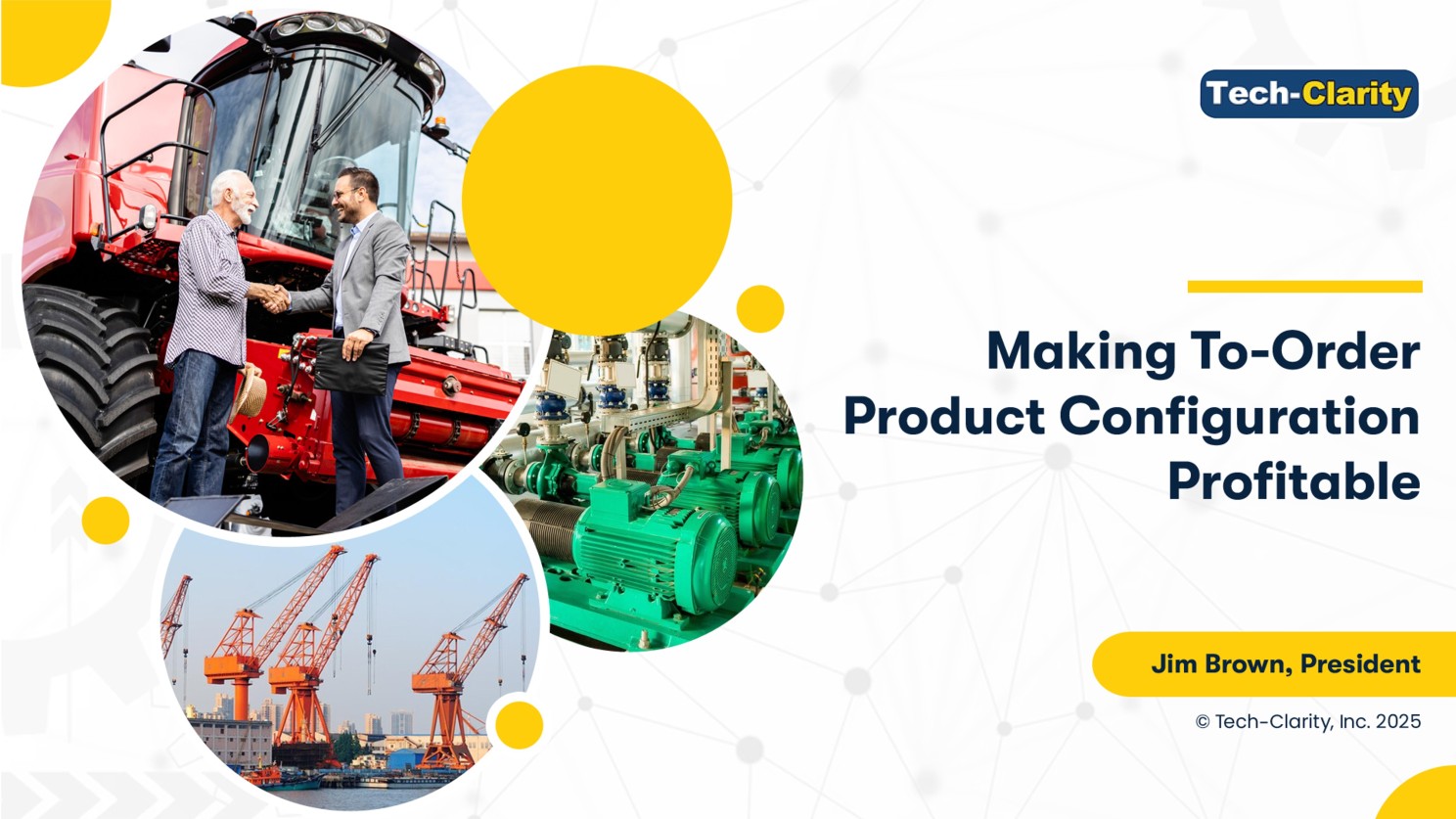
There is more information available in the underlying survey report, including interviews with Schumacher Elevator Company and Ingersoll Rand. You can view a summary of the research on our site or download the full survey report courtesy of Siemens.
Thank You
Thank you for the conversation Rick, I always learn something new when we talk!
[post_title] => Trends in Configuring Products to Order [post_excerpt] => [post_status] => publish [comment_status] => open [ping_status] => open [post_password] => [post_name] => configuration-trendstrends-in-configuring-products-to-order [to_ping] => [pinged] => [post_modified] => 2025-11-12 22:38:01 [post_modified_gmt] => 2025-11-13 03:38:01 [post_content_filtered] => [post_parent] => 0 [guid] => https://tech-clarity.com/?p=22746 [menu_order] => 0 [post_type] => post [post_mime_type] => [comment_count] => 0 [filter] => raw ) [7] => WP_Post Object ( [ID] => 22842 [post_author] => 2580 [post_date] => 2025-09-08 10:22:07 [post_date_gmt] => 2025-09-08 14:22:07 [post_content] =>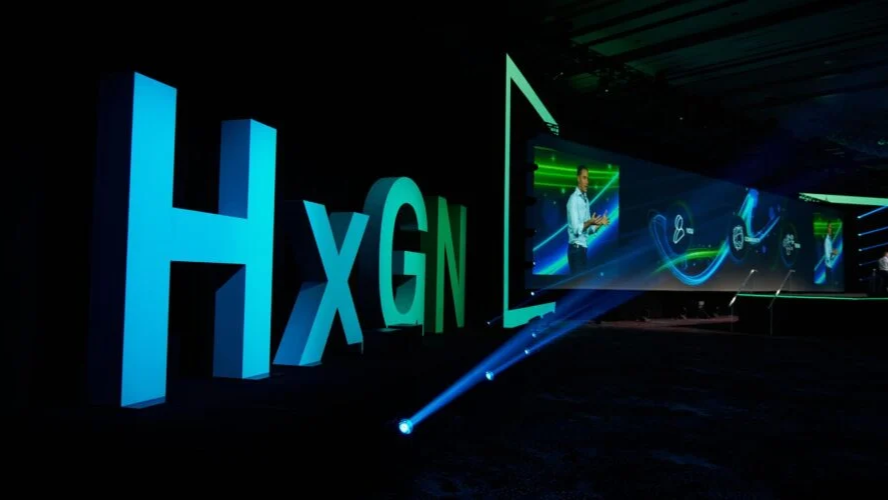 Hexagon AB invited Tech-Clarity to the recently concluded HxGN LIVE Global 2025 event in Las Vegas and our analyst, Arvind Krishnan covered this event. In this article, we want to discuss three announcements that stood out: Octave, Proplan AI/Autonomous Metrology Suite, and Aeon.
Hexagon AB invited Tech-Clarity to the recently concluded HxGN LIVE Global 2025 event in Las Vegas and our analyst, Arvind Krishnan covered this event. In this article, we want to discuss three announcements that stood out: Octave, Proplan AI/Autonomous Metrology Suite, and Aeon.
Octave – The New Home for Asset Lifecycle Intelligence
What is Octave, and why did Hexagon create this new company?
Not too long ago, Hexagon announced it would spin off its Asset Lifecycle Intelligence (ALI) division. Now, we know the name of the new company - Octave. In addition to ALI, Octave will include the Safety, Infrastructure, and Geospatial (SIG), ETQ, and Bricsys divisions. Hexagon also announced Mattias Stenberg as Octave's CEO. Hexagon expects Octave to become a publicly listed company sometime in 2026 (subject to the approval of the Board and shareholders). So, what was the need to create Octave? The answer is FOCUS, in our opinion. If you attended HxGN LIVE Global 2025, it was clear that Hexagon's core business wants to focus on metrology and other hardware-related verticals. Another reason could be that it intends to separate its software/SaaS businesses from its hardware businesses and unlock value in both divisions. If you believe that the growth potential of the SaaS business is higher than that of the traditional hardware business, Hexagon's shareholders can realize this superior growth from Octave. We wish Octave the very best in its new journey.
Proplan AI and Autonomous Metrology Suite – Manufacturing Intelligence's Answer to Quality and Skill Gaps in Manufacturing
The theme for Manufacturing Intelligence was quality. Andreas Renault, the President of MI, talked about quality for life. Many of today's products touch people's lives and quality products are about delivering a great experience. Good quality products turn functionalities into great experiences for customers. And Hexagon believes that quality is the #1 driver for innovation. Andreas shared some eye-popping data (85% of manufacturers struggle to solve the underlying causes of quality issues), where solving quality problems is a significant business challenge. Many new products (scanners, CMM machines, and software) that Hexagon unveiled at the event directly address quality. A couple of solutions that I want to discuss are Proplan AI and the Autonomous Metrology Suite.
Proplan AI is an advanced AI-driven CNC process planning solution integrated with Hexagon's ESPRIT EDGE CAM suite. Proplan AI helps new operators quickly become proficient in programming CNC machines, enables companies to cope with the skills gap, and improves productivity by reducing manual processing time. Since Proplan AI learns from past CAM files generated by experienced programmers in the company, it embeds corporate know-how (preferred speeds, feeds, tools) to ensure consistency and guarantee quality. Ultimately, Proplan AI empowers organizations to retain institutional knowledge, defer routine engineering work to AI, and accelerate time‑to‑market with consistent quality and lower resource overhead. Proplan AI uses the Nexus platform and also Nexus SaaS user interface. According to Hexagon. this platform and user interface approach to Proplan AI would accelerate the adoption of cloud technology for traditional desktop users.
Hexagon also announced the Autonomous Metrology Suite, an innovative software solution designed to streamline quality control in manufacturing by eliminating coding from coordinate measuring machine (CMM) workflows. By Automating and simplifying measurement processes the Autonomous Metrology Suite drastically reduces programming time from days to hours, making it easier for manufacturers to maintain high accuracy amid growing pressures like shorter product lifecycles and a shortage of skilled CMM programmers. Based on the Nexus platform, the solution features a user-friendly interface, enabling even novice users to create compliant inspection programs while ensuring consistent measurement standards across operations. solution's real-time data analytics and monitoring capabilities empower manufacturers to make data-driven decisions, ultimately enhancing productivity and efficiency on the shop floor.
Aeon – Advancing the Use of Humanoids in Manufacturing
Hexagon’s Robotics Division introduced Aeon, a versatile, humanoid robotic system blending advanced mobility, sensor fusion, and AI-powered spatial awareness to execute tasks in human-centric industrial environments autonomously. Hexagon Robotics designed Aeon for manufacturing applications. Three use cases that Hexagon highlighted stood out for us.
- With its dextrous hands, Aeon can perform tasks such as placing, tightening, and quality assessment without requiring tooling change.
- With its sensor-rich architecture, Aeon can perform autonomous in-line inspections to spot quality issues.
- Finally, Aeon can meet workforce disparities through automation that enhances safety, operational uptime, and ergonomic outcomes while working collaboratively with human operators.
Our Take
Many of the new solutions we learned about in this event directly support Tech-Clarity's research findings. Quality is indispensable to manufacturers, and they are investing in technologies that can help them improve the quality of their products and services. At the same time, finding a skilled workforce in manufacturing is challenging. Manufacturers in every region echo this challenge. So, solutions like Proplan AI, Autonomous Metrology Suite, and Aeon, which address quality and skill deficiency issues, are likely to be widely adopted by manufacturers.
Many of Hexagon's existing software solutions in Design and Engineering also help manufacturers find and address the root cause of quality problems in manufacturing. The users of these solutions could also benefit from AI. Unfortunately, Hexagon did not share much about its AI strategy for existing products. It is possible to see Copilot-like features for many of Hexagon's software solutions. And this enhancement could be a game-changer for Hexagon’s customers.
Thank you, Robin Wolstenholme and Mandy Wardman, for giving us analysts a wonderful experience at the 2025 event.
[post_title] => Highlights from Hexagon Live Global 2025 [post_excerpt] => [post_status] => publish [comment_status] => open [ping_status] => open [post_password] => [post_name] => hexagon-live-global-2025 [to_ping] => [pinged] => [post_modified] => 2025-09-18 10:32:56 [post_modified_gmt] => 2025-09-18 14:32:56 [post_content_filtered] => [post_parent] => 0 [guid] => https://tech-clarity.com/?p=22842 [menu_order] => 0 [post_type] => post [post_mime_type] => [comment_count] => 0 [filter] => raw ) [8] => WP_Post Object ( [ID] => 22557 [post_author] => 2572 [post_date] => 2025-09-05 10:10:33 [post_date_gmt] => 2025-09-05 14:10:33 [post_content] =>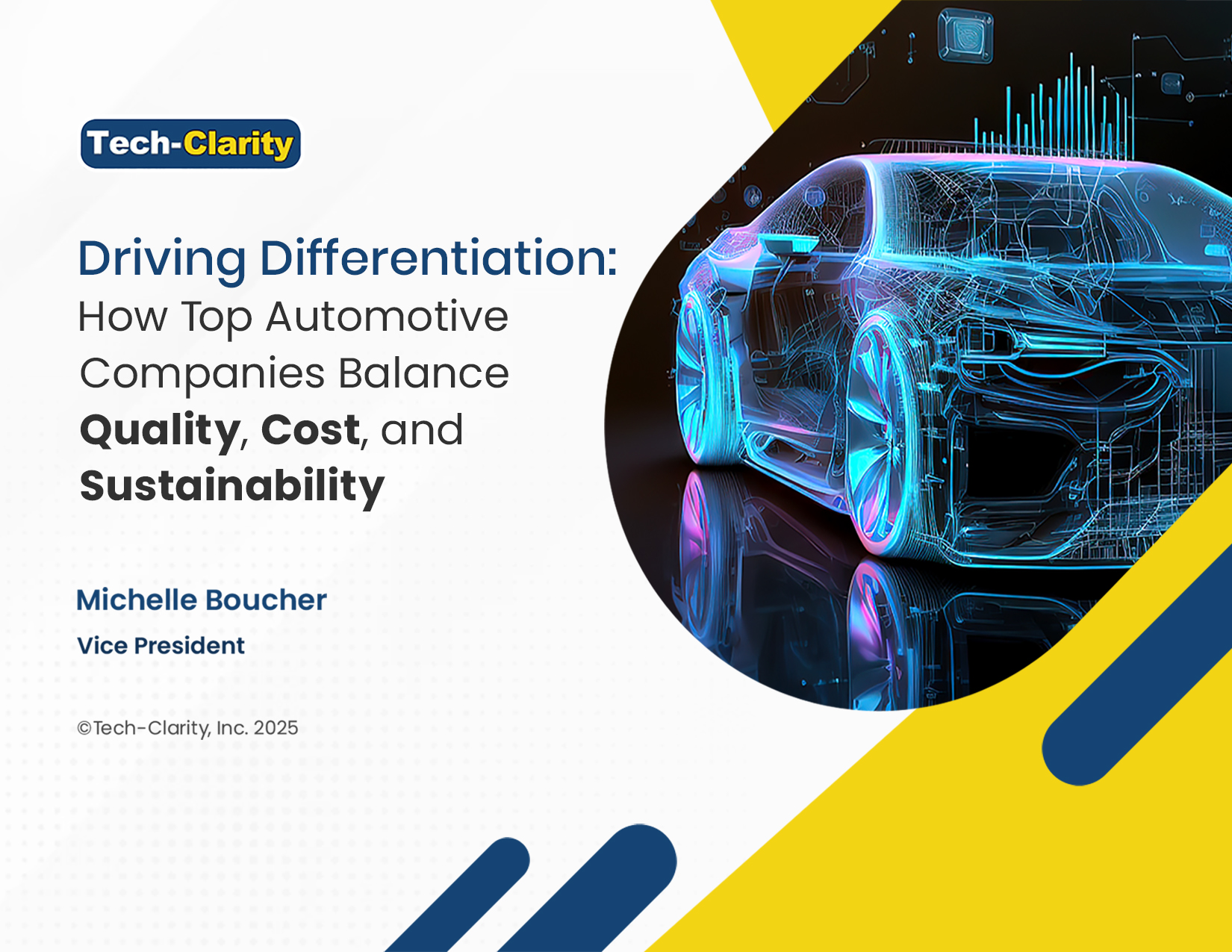 How do Top Performing automotive companies balance quality, cost, and sustainability to gain a competitive edge?
Early design decisions significantly shape a vehicle’s total cost and environmental impact. Yet, for many OEMs and suppliers, critical cost and carbon footprint data is scattered across systems, making it hard to evaluate trade-offs when it matters most.
How can automotive companies empower teams to make informed decisions to optimize trade-offs?
Based on a survey of 178 automotive companies, including OEMs and suppliers, this research study examines best practices for managing cost while considering the implications of quality and carbon footprint. The research also reveals how automotive companies can empower teams, including sales, design, procurement, and sustainability, to make more informed decisions to increase profitability.
Please enjoy the summary* below. For the full research, please visit our sponsor, Siemens (registration required).
How do Top Performing automotive companies balance quality, cost, and sustainability to gain a competitive edge?
Early design decisions significantly shape a vehicle’s total cost and environmental impact. Yet, for many OEMs and suppliers, critical cost and carbon footprint data is scattered across systems, making it hard to evaluate trade-offs when it matters most.
How can automotive companies empower teams to make informed decisions to optimize trade-offs?
Based on a survey of 178 automotive companies, including OEMs and suppliers, this research study examines best practices for managing cost while considering the implications of quality and carbon footprint. The research also reveals how automotive companies can empower teams, including sales, design, procurement, and sustainability, to make more informed decisions to increase profitability.
Please enjoy the summary* below. For the full research, please visit our sponsor, Siemens (registration required).
Table of Contents
- Executive Summary
- Differentiating in the Automotive Industry
- Identifying Top Performers
- What Makes a Winning Bid?
- How Suppliers Win
- Assessing Product Cost
- Assessing Product Carbon Footprint
- Positive Business Impact
- Optimize Early
- Optimizing Product Carbon Footprint and Cost
- A Foundation for Profitable Growth
- Cost-Effective, Sustainable Vehicles
- Recommendations and Next Steps
- About the Research
- Acknowledgments
Executive Summary
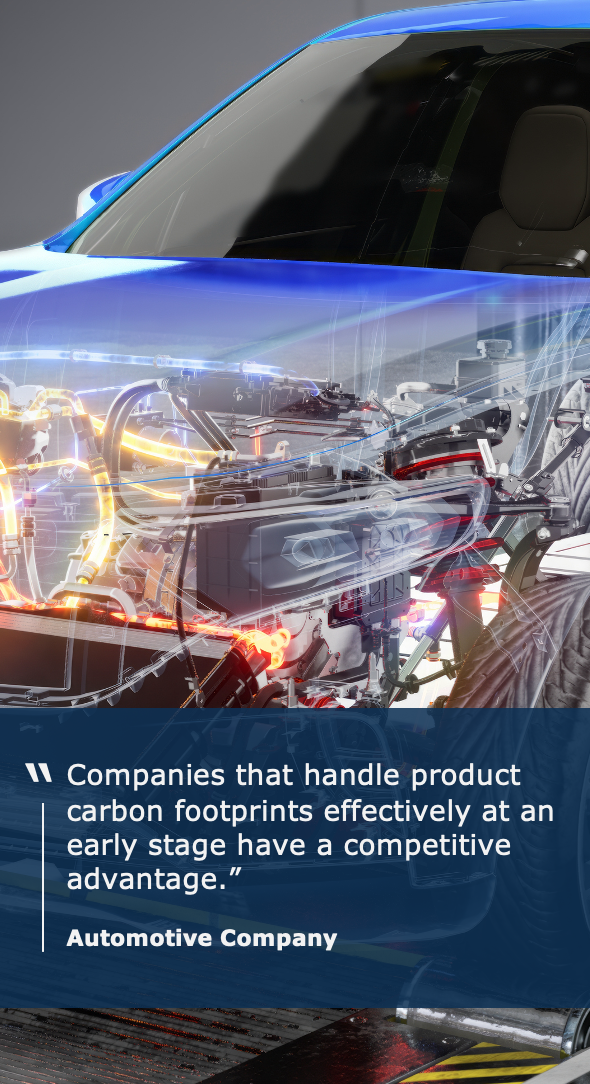 Balancing Profitability Drivers
Standing out in the competitive automotive market requires early strategic decisions. Survey respondents report cost, quality and product carbon footprint among the most important differentiators. Research estimates that 70%-80% of a product's lifecycle costs1 and 80% of a product’s environmental impact2 are determined by decisions made early in the product lifecycle. Multiple roles including sales, design, procurement, and sustainability would benefit from accurate, consolidated insights to make more informed decisions around this criterial criteria. However, data is unavailable or scattered, making it hard to assess trade-offs. With competing priorities, teams struggle to gather needed information. If they could, it would drive significant advantages. This report explores those benefits.
Win More Bids
Competitive pricing and delivery timelines are key to winning bids. Consequently, understanding cost is critical to keeping prices reasonable without compromising profit margins. Beyond that, when everything else is equal, lowering the carbon footprint can be a deciding factor.
Early Assessments
Early product cost and carbon footprint estimates enable better decisions when they have the most impact. Access to comprehensive data helps automotive companies reduce costs without compromising quality.
Digital Thread
While early access helps, decisions based on outdated information offer little value. Teams need a comprehensive view of current data as designs evolve and supplier data changes. Traceability will enable a better understanding of a decision's full impact.
Use the Right Software Tools
A tool that consolidates data sources, such as from PLM, CAD, ERP, and supply chain solutions, provides a comprehensive view of design details, material information, and supplier data to support more informed decisions.
This report explores this approach and the benefits Top Performing automotive companies achieve.
Balancing Profitability Drivers
Standing out in the competitive automotive market requires early strategic decisions. Survey respondents report cost, quality and product carbon footprint among the most important differentiators. Research estimates that 70%-80% of a product's lifecycle costs1 and 80% of a product’s environmental impact2 are determined by decisions made early in the product lifecycle. Multiple roles including sales, design, procurement, and sustainability would benefit from accurate, consolidated insights to make more informed decisions around this criterial criteria. However, data is unavailable or scattered, making it hard to assess trade-offs. With competing priorities, teams struggle to gather needed information. If they could, it would drive significant advantages. This report explores those benefits.
Win More Bids
Competitive pricing and delivery timelines are key to winning bids. Consequently, understanding cost is critical to keeping prices reasonable without compromising profit margins. Beyond that, when everything else is equal, lowering the carbon footprint can be a deciding factor.
Early Assessments
Early product cost and carbon footprint estimates enable better decisions when they have the most impact. Access to comprehensive data helps automotive companies reduce costs without compromising quality.
Digital Thread
While early access helps, decisions based on outdated information offer little value. Teams need a comprehensive view of current data as designs evolve and supplier data changes. Traceability will enable a better understanding of a decision's full impact.
Use the Right Software Tools
A tool that consolidates data sources, such as from PLM, CAD, ERP, and supply chain solutions, provides a comprehensive view of design details, material information, and supplier data to support more informed decisions.
This report explores this approach and the benefits Top Performing automotive companies achieve.
Identifying Top Performers
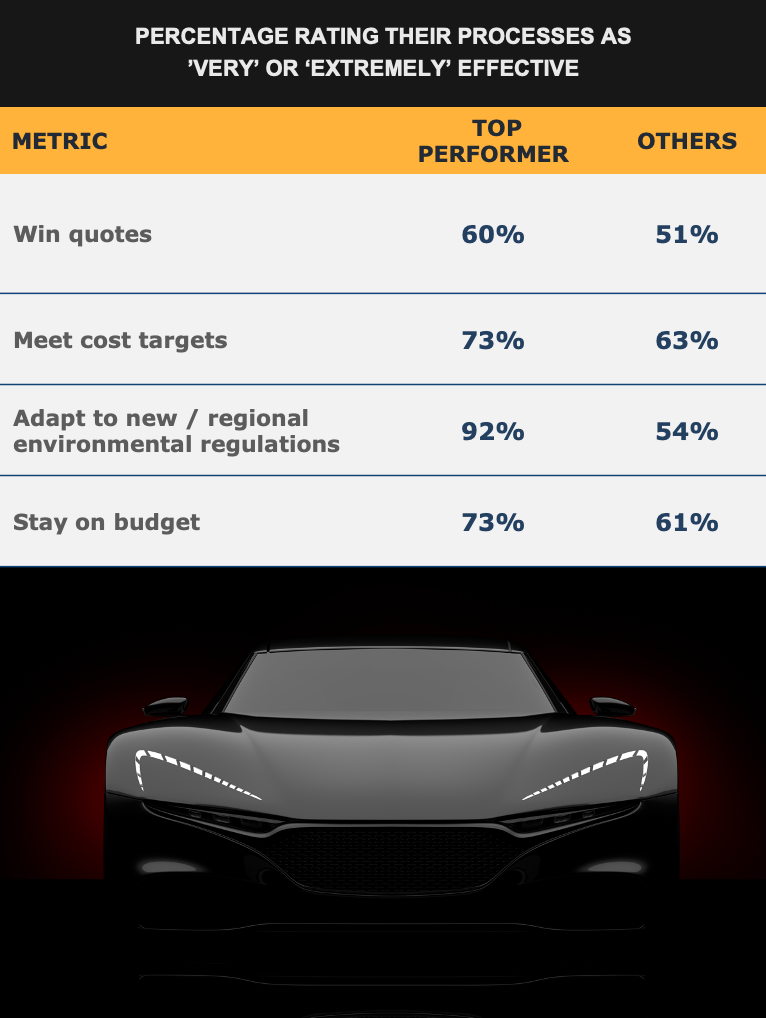 How Top Performers Were Defined
To define Top Performers, Tech-Clarity identified the top 25% of companies that outperform their competitors in metrics that indicate business success. These metrics were:
How Top Performers Were Defined
To define Top Performers, Tech-Clarity identified the top 25% of companies that outperform their competitors in metrics that indicate business success. These metrics were:
- Revenue growth over the last 24 months
- Profit margin expansion over the previous 24 months
- Percent of sales from new products (less than 3 years old)
- Product cost reduction
- On-time delivery
Cost-Effective, Sustainable Vehicles
PLM Integration An overwhelming 97% of Top Performing companies agree that a solution to assess product cost and carbon footprint should integrate with PLM. By integrating design and engineering PLM data, with manufacturing, procurement, and supply chain data, companies can get a complete view of material costs, energy consumption, and carbon emissions across the product lifecycle. This leads to data-driven insights for cost-effective, eco-friendly decision-making. Many companies, regardless of performance, integrate ERP, but integrating PLM is what sets Top Performers apart, allowing them to gain deeper insights. Single Solution Benefits Automotive companies agree that a single solution that integrates these data sources will lead to more optimized products that cost less, giving them a competitive advantage, and supporting more accurate estimates. They can evaluate the product carbon footprint at the same time as product cost without additional time or effort. This approach should enhance profitability and help capture market share because it better equips them to excel at meeting the criteria needed to differentiate vehicles and components.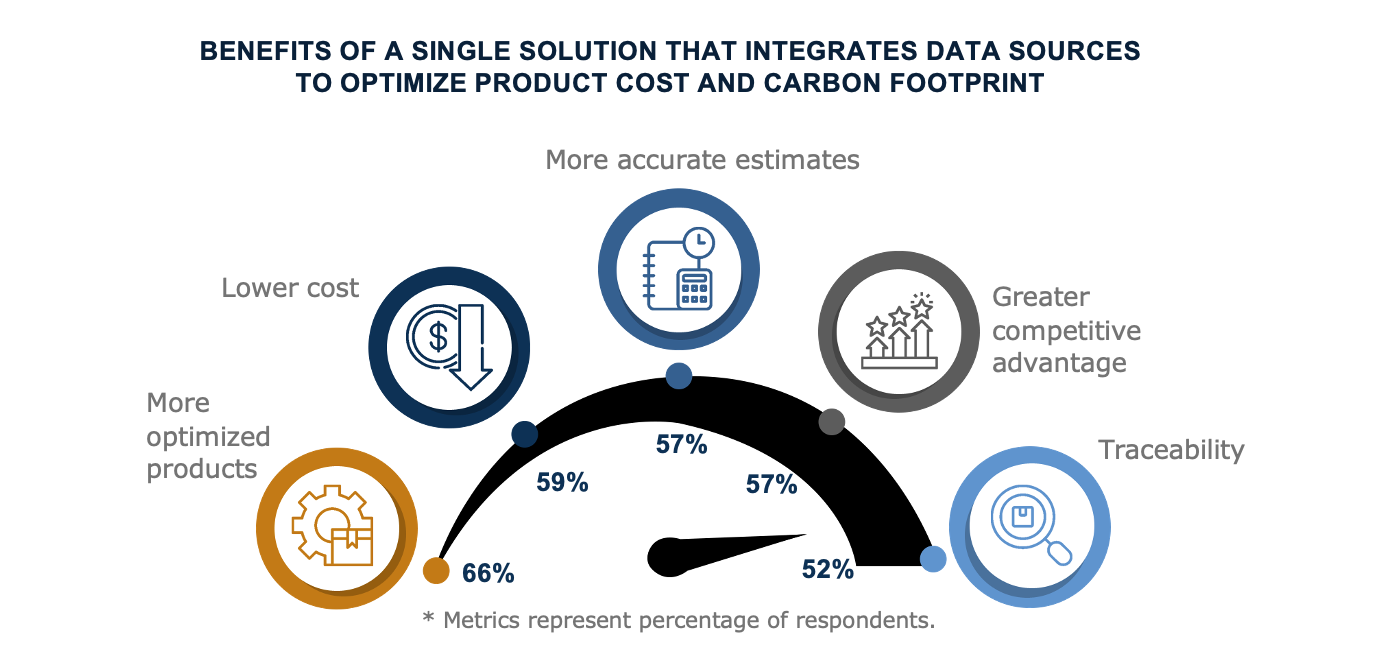 Recommendations and Next Steps
Recommendations and Next Steps
Based on industry experience and research for this report, Tech-Clarity offers the following recommendations for automotive companies:
- Prioritize quality, cost, and carbon footprint. This balance is crucial for brand differentiation and customer loyalty. While carbon footprint is a larger concern for companies headquartered in Europe, it is needed to meet the growing number of regulations.
- Equip sales teams with tools for accurate cost assessment for bidding. Top Performing suppliers value solutions that enable profitability analysis, understanding supply chain impacts, comparing product cost and carbon footprint, and tool cost calculations to win bids.
- Empower teams to simultaneously assess cost and carbon footprint. Lightweight materials, aerodynamics, and fuel efficiency reduce the product carbon footprint, but understanding cost impact ensures better decisions.
- Leverage a software tool that consolidates data sources. Data needed to assess product cost and carbon footprint is typically distributed across multiple systems. With competing priorities, teams don't have time to hunt for it. Data sources should include design details, material information, and supplier data.
- Ensure multiple teams have access to up-to-date data impacting product cost and carbon footprint. Teams, including sales, design, procurement, and sustainability, can make better decisions that will improve profitability if they have real-time access to the data they need, when they need it.
- Assess product cost and carbon footprint together early in the lifecycle. Decisions made early in the product lifecycle have the most impact. Empowering teams with early visibility and access to comprehensive data will facilitate more informed decision-making.
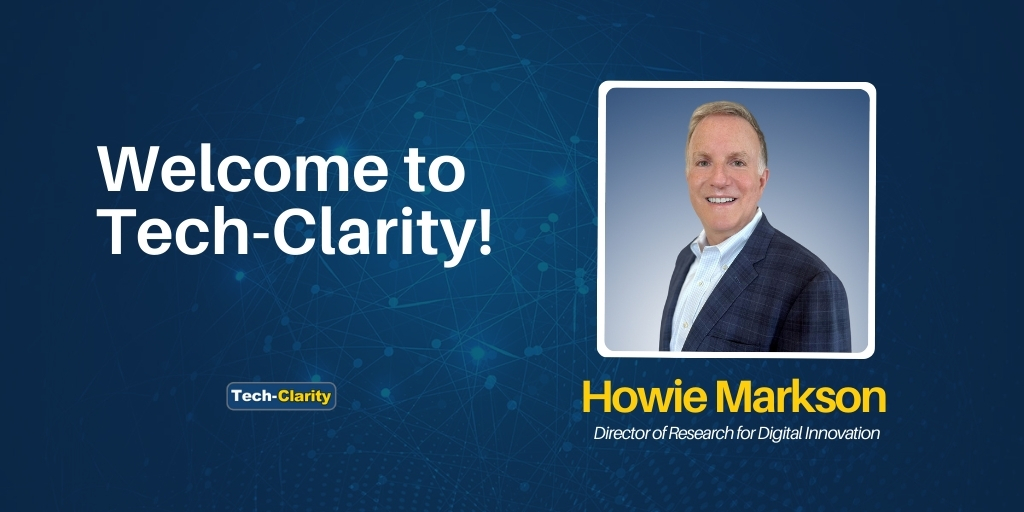 We are pleased to announce that Howie Markson joins Tech-Clarity as Director of Research for Digital Innovation. This strategic hire strengthens Tech-Clarity’s ability to help educate manufacturers on how to navigate complex technology decisions to improve business performance. Howie’s focus areas include product design, simulation, PLM, PDM, SLM, IoT, AI, and other product development solutions for manufacturing companies. Howie has a degree in mechanical engineering and 25+ experience across product design, product management, application engineering, and product marketing covering a wide range of companies, industries, and technologies.
Please visit Howie’s bio page for more details on his background.
“Howie brings deep PLM knowledge and experience to Tech-Clarity. This enables our analyst team to expand coverage of digital transformation across the enterprise, including service and supply solutions,” notes Jim Brown, President and Founder of Tech-Clarity. “At Tech-Clarity our goal is to provide manufacturers valuable insights on industry trends and new technologies, such as AI, throughout the product digital thread from inception to service. Howie’s extensive industry background and keen understanding of technology and its business value helps us further our mission.”
Today, manufacturers are challenged by product complexity, regulations, cost pressures, and changing market dynamics across many traditional sectors. Consumer expectations have reached new heights with the desire for sustainability, personalization, affordability, and advanced features. This puts enormous pressure on a company’s product development process. Fortunately, unprecedented access to mature product development applications and powerful digital technologies makes it possible for manufacturers to improve their product innovation and business performance.
To take advantage of these opportunities, manufacturers are digitally transforming and seeking the latest technologies and best-in-class solutions for their product development needs. Their goal is to find solutions that deliver powerful new capabilities (such as Artificial Intelligence) and support key transformative goals (such as Digital Twin, Digital Thread) that bring tangible business benefits.
However, in a software industry full of acronyms, rapidly evolving product capabilities, and fast-changing technology it is difficult for manufacturers to navigate through the myriads of software providers and product offerings. Howie‘s experience across a wide range of industry products and technologies brings a needed perspective to manufacturers looking for clarity on the capabilities and value of the various offerings.
[post_title] => Howie Markson Joins Tech-Clarity Research Team for Digital Innovation
[post_excerpt] =>
[post_status] => publish
[comment_status] => open
[ping_status] => open
[post_password] =>
[post_name] => howie-markson-joins-tech-clarity-research-team-for-digital-innovation
[to_ping] =>
[pinged] =>
[post_modified] => 2025-09-03 09:15:08
[post_modified_gmt] => 2025-09-03 13:15:08
[post_content_filtered] =>
[post_parent] => 0
[guid] => https://tech-clarity.com/?p=22696
[menu_order] => 0
[post_type] => post
[post_mime_type] =>
[comment_count] => 0
[filter] => raw
)
[10] => WP_Post Object
(
[ID] => 22679
[post_author] => 2
[post_date] => 2025-08-29 10:33:18
[post_date_gmt] => 2025-08-29 14:33:18
[post_content] =>
We are pleased to announce that Howie Markson joins Tech-Clarity as Director of Research for Digital Innovation. This strategic hire strengthens Tech-Clarity’s ability to help educate manufacturers on how to navigate complex technology decisions to improve business performance. Howie’s focus areas include product design, simulation, PLM, PDM, SLM, IoT, AI, and other product development solutions for manufacturing companies. Howie has a degree in mechanical engineering and 25+ experience across product design, product management, application engineering, and product marketing covering a wide range of companies, industries, and technologies.
Please visit Howie’s bio page for more details on his background.
“Howie brings deep PLM knowledge and experience to Tech-Clarity. This enables our analyst team to expand coverage of digital transformation across the enterprise, including service and supply solutions,” notes Jim Brown, President and Founder of Tech-Clarity. “At Tech-Clarity our goal is to provide manufacturers valuable insights on industry trends and new technologies, such as AI, throughout the product digital thread from inception to service. Howie’s extensive industry background and keen understanding of technology and its business value helps us further our mission.”
Today, manufacturers are challenged by product complexity, regulations, cost pressures, and changing market dynamics across many traditional sectors. Consumer expectations have reached new heights with the desire for sustainability, personalization, affordability, and advanced features. This puts enormous pressure on a company’s product development process. Fortunately, unprecedented access to mature product development applications and powerful digital technologies makes it possible for manufacturers to improve their product innovation and business performance.
To take advantage of these opportunities, manufacturers are digitally transforming and seeking the latest technologies and best-in-class solutions for their product development needs. Their goal is to find solutions that deliver powerful new capabilities (such as Artificial Intelligence) and support key transformative goals (such as Digital Twin, Digital Thread) that bring tangible business benefits.
However, in a software industry full of acronyms, rapidly evolving product capabilities, and fast-changing technology it is difficult for manufacturers to navigate through the myriads of software providers and product offerings. Howie‘s experience across a wide range of industry products and technologies brings a needed perspective to manufacturers looking for clarity on the capabilities and value of the various offerings.
[post_title] => Howie Markson Joins Tech-Clarity Research Team for Digital Innovation
[post_excerpt] =>
[post_status] => publish
[comment_status] => open
[ping_status] => open
[post_password] =>
[post_name] => howie-markson-joins-tech-clarity-research-team-for-digital-innovation
[to_ping] =>
[pinged] =>
[post_modified] => 2025-09-03 09:15:08
[post_modified_gmt] => 2025-09-03 13:15:08
[post_content_filtered] =>
[post_parent] => 0
[guid] => https://tech-clarity.com/?p=22696
[menu_order] => 0
[post_type] => post
[post_mime_type] =>
[comment_count] => 0
[filter] => raw
)
[10] => WP_Post Object
(
[ID] => 22679
[post_author] => 2
[post_date] => 2025-08-29 10:33:18
[post_date_gmt] => 2025-08-29 14:33:18
[post_content] => 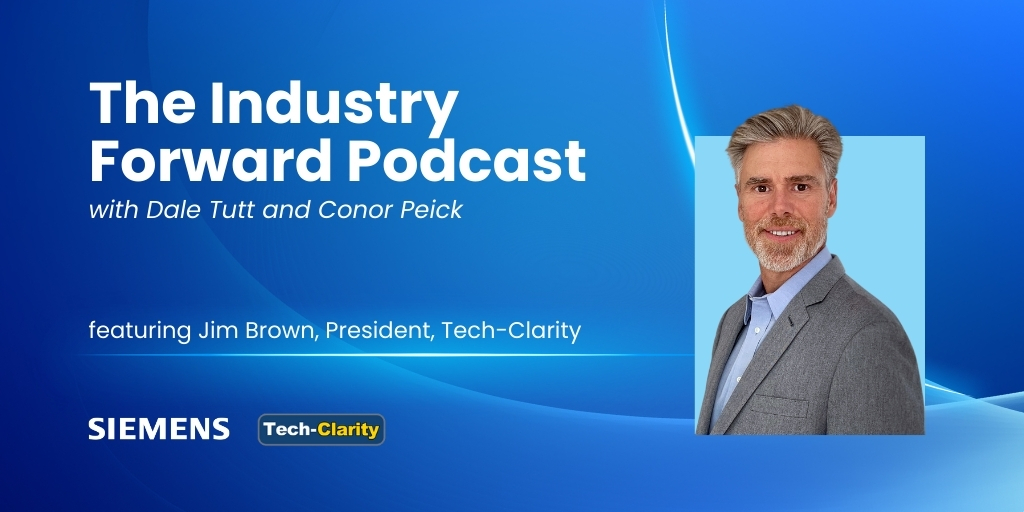 Tech-Clarity President and Founder Jim Brown had the opportunity to join Siemens Vice President of Industry Strategy Dale Tutt on his podcast, The Industry Forward. Host Conor Pieck leads a lively conversation between Dale and Jim where Jim shares insights from Tech-Clarity’s research and Dale offers perspectives from his rich experience in the manufacturing and software industries.
Conor leads them in a discussion about what leading companies are doing differently in pursuing the digital enterprise and how they use digital transformation to drive agility and overcome disruption. Jim shares statistics showing that companies with more digital data and processes achieve better business performance. Dale and Jim discuss how becoming more digital helps companies in a variety of ways, including getting to market faster and improving engineering efficiency. There are three parts of this conversation between the two seasoned professionals, please access them below:
About The Industry Forward Podcast:
Welcome to the Industry Forward Podcast with Dale Tutt! Join Dale Tutt, Vice President of Industry Strategy at Siemens Digital Industries Software, and host Conor Peick to learn more about the trends, technologies, and opportunities affecting some of the largest and most important industries in the world. In each episode we will be joined by a seasoned expert to dive into the dynamic challenges and creative solutions being developed in a variety of industries to learn how companies are transforming for the future. These experts will tell us about everything from medical devices to heavy equipment and more and explain how each of these industries is approaching digitalization and the digital twin to overcome the hurdles they are facing.
There are two more episodes of the Industry Forward Podcast. Episode two
[post_title] => Jim Brown Talks Digital Transformation on The Industry Forward Podcast
[post_excerpt] =>
[post_status] => publish
[comment_status] => open
[ping_status] => open
[post_password] =>
[post_name] => the-industry-forward-podcast
[to_ping] =>
[pinged] =>
[post_modified] => 2025-10-02 23:04:45
[post_modified_gmt] => 2025-10-03 03:04:45
[post_content_filtered] =>
[post_parent] => 0
[guid] => https://tech-clarity.com/?p=22679
[menu_order] => 0
[post_type] => post
[post_mime_type] =>
[comment_count] => 0
[filter] => raw
)
[11] => WP_Post Object
(
[ID] => 22800
[post_author] => 2574
[post_date] => 2025-08-27 21:13:18
[post_date_gmt] => 2025-08-28 01:13:18
[post_content] =>
Tech-Clarity President and Founder Jim Brown had the opportunity to join Siemens Vice President of Industry Strategy Dale Tutt on his podcast, The Industry Forward. Host Conor Pieck leads a lively conversation between Dale and Jim where Jim shares insights from Tech-Clarity’s research and Dale offers perspectives from his rich experience in the manufacturing and software industries.
Conor leads them in a discussion about what leading companies are doing differently in pursuing the digital enterprise and how they use digital transformation to drive agility and overcome disruption. Jim shares statistics showing that companies with more digital data and processes achieve better business performance. Dale and Jim discuss how becoming more digital helps companies in a variety of ways, including getting to market faster and improving engineering efficiency. There are three parts of this conversation between the two seasoned professionals, please access them below:
About The Industry Forward Podcast:
Welcome to the Industry Forward Podcast with Dale Tutt! Join Dale Tutt, Vice President of Industry Strategy at Siemens Digital Industries Software, and host Conor Peick to learn more about the trends, technologies, and opportunities affecting some of the largest and most important industries in the world. In each episode we will be joined by a seasoned expert to dive into the dynamic challenges and creative solutions being developed in a variety of industries to learn how companies are transforming for the future. These experts will tell us about everything from medical devices to heavy equipment and more and explain how each of these industries is approaching digitalization and the digital twin to overcome the hurdles they are facing.
There are two more episodes of the Industry Forward Podcast. Episode two
[post_title] => Jim Brown Talks Digital Transformation on The Industry Forward Podcast
[post_excerpt] =>
[post_status] => publish
[comment_status] => open
[ping_status] => open
[post_password] =>
[post_name] => the-industry-forward-podcast
[to_ping] =>
[pinged] =>
[post_modified] => 2025-10-02 23:04:45
[post_modified_gmt] => 2025-10-03 03:04:45
[post_content_filtered] =>
[post_parent] => 0
[guid] => https://tech-clarity.com/?p=22679
[menu_order] => 0
[post_type] => post
[post_mime_type] =>
[comment_count] => 0
[filter] => raw
)
[11] => WP_Post Object
(
[ID] => 22800
[post_author] => 2574
[post_date] => 2025-08-27 21:13:18
[post_date_gmt] => 2025-08-28 01:13:18
[post_content] => 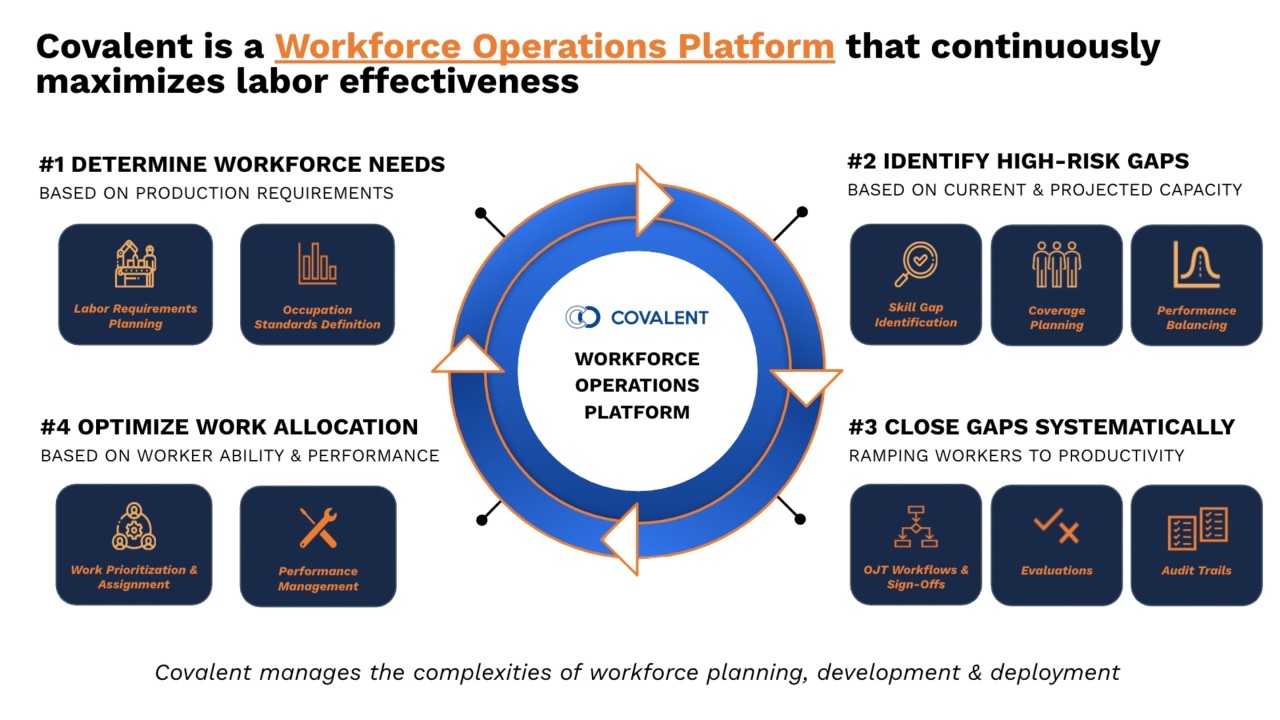 Can manufacturers maximize plant human resources as effectively as inventory and equipment? Covalent would say yes. That is what their workforce operations platform is designed to do: continuously maximize labor effectiveness. They continue to build out in multiple directions: functionally, beyond tracking training and job experience to creating an interactive skills matrix, optimizing work allocation, and last-mile line staffing. They have also gained new customers beyond A&D and automotive in chemicals and CPG.
Can manufacturers maximize plant human resources as effectively as inventory and equipment? Covalent would say yes. That is what their workforce operations platform is designed to do: continuously maximize labor effectiveness. They continue to build out in multiple directions: functionally, beyond tracking training and job experience to creating an interactive skills matrix, optimizing work allocation, and last-mile line staffing. They have also gained new customers beyond A&D and automotive in chemicals and CPG.
Workforce Operations Platform
Covalent's main users are manufacturing, engineering, and quality leaders. They need to answer questions such as: How many people do we require? What quantity and quality of skills do we need for the work we have this week, today, or on this shift? How do we train up our people to fill any gaps? Is all of this easily auditable? To answer these labor-related questions, Covalent’s Workforce Operations Platform creates a profile for every employee with details of their skills, knowledge, and experience. Covalent’s platform is based on the AWS Cloud, which brings benefits in security, compliance, and infrastructure. Both the AWS and Covalent platforms continue to improve and deepen over time. On this SaaS platform sit role-based solutions, typically aimed at manufacturing, engineering, and quality leaders. Imagine having all this information about each employee in the plant to plan coverage for the week, day, or shift. This continuous employee tracking also enables remediation when quality trends show problems relating to how someone performed a task at a particular work area. Covalent has many built-in objects often found in MES, such as assets, work centers, tasks, and jobs, to understand an employee's eligibility to perform a piece of work. Being able to gauge whether an employee has the skills and certifications needed to buy off and start a task is also hugely beneficial for both manufacturing and quality leaders.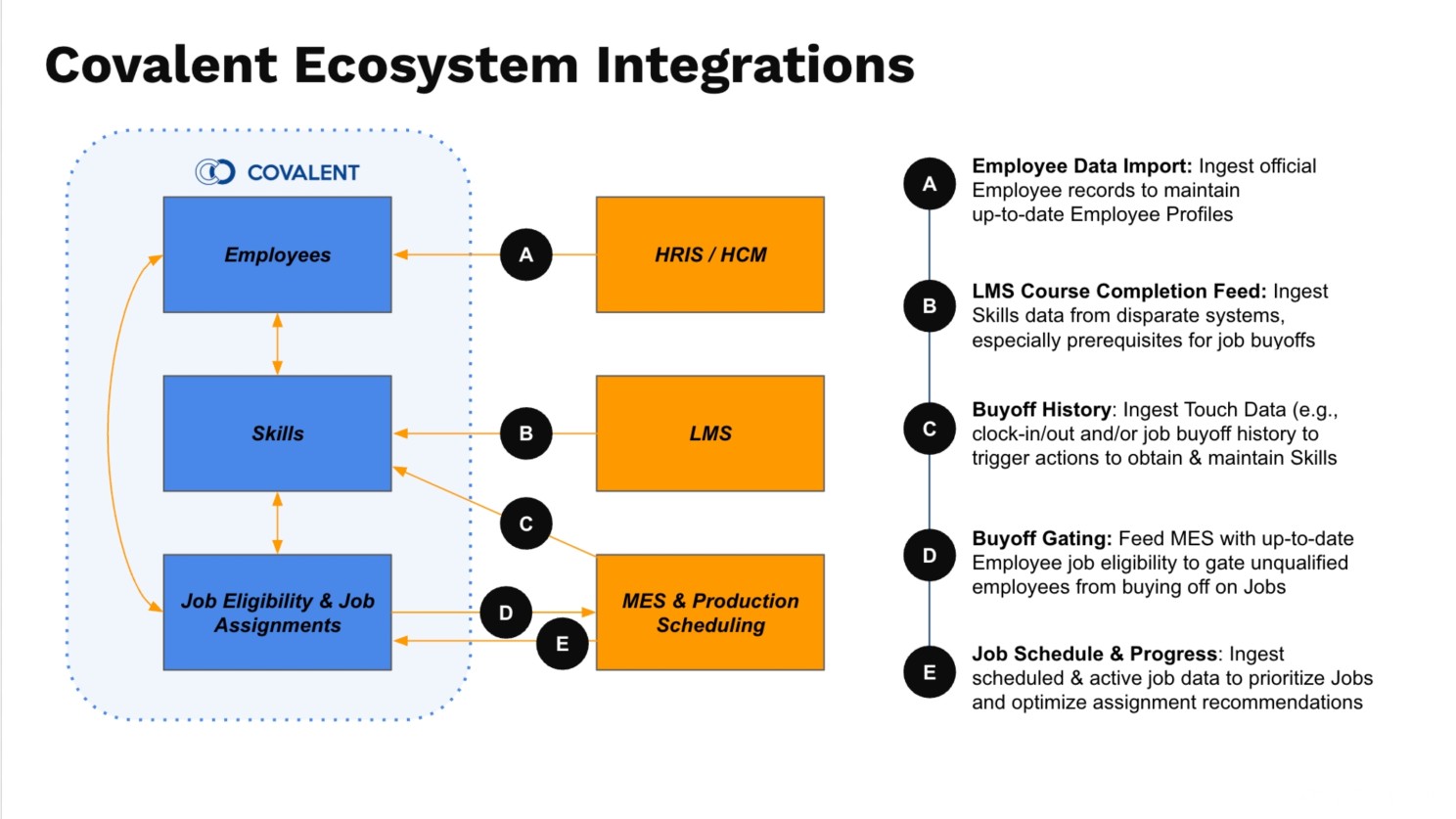
Integration and Building on LMS, MES
Integration with the manufacturer’s learning management system (LMS) is just one element of training. Covalent can also deliver content, evaluations, training tasks, and digital sign-offs. It also integrates with time and attendance (T&A) and MES to enable touch and task performance tracking for employees as they perform the work. Beyond that, the newest functionality also interacts with advanced production planning and scheduling (APS) to deepen the ability to ensure scheduled work has the staffing in place to be executed efficiently and compliantly. Covalent is already integrated with SAP, Siemens Opcenter, and iBase-t Solumina MES. It is also integrated with LMSs such as Workday Learning, SAP SuccessFactors, and Cornerstone. There are some overlaps with LMSs, but Covalent’s clear OTJ extensions seem to keep customers happy.Interactive Skills Matrix
One of the newer capabilities is an interactive skills matrix. The benefit of interactivity is that users don’t need to jump pages or go to email. They liken it to Google Maps; you can drill in and assign training or drill to see each person’s training. The matrix includes parent-child relationships and digital forms to complete for training or renewal logic. The system can also layer on alerts. So if, for example, a certification has an expiration date, the system can alert the supervisor that a person will need to take refresher training to continue all the work they’ve been doing.Intelligent Work Allocation
One of Covalent's newest capabilities is Intelligent Work Allocation (IWA), which improves production accuracy even in the face of workforce shortages. A smart job assignment board helps ensure the system sees job touch data that enriches the employee profiles. With this, work order data and job progress come together with who is on shift. A machine learning (ML) algorithm creates a suggested or optimized build plan with people allocated to it based on the needs for the day. The system’s logic can account for jobs where multiple people are needed for a step, or one person follows the product or serialized assembly through many steps. The supervisor reviews the plan and has the opportunity to override it. Supervisors can also review the shift performance at the end. One large A&D customer already has this capability in production. Covalent’s team is also working to perfect the capabilities for automotive within-shift ergonomics rotations. Remember, Covalent started out in training, so creating a shadowing shift for someone to learn is part of what this can do, too.Origins in the Future of Work
Covalent started in 2016 while the founders were in graduate school in the Harvard Future of Work program. The focus was to play a broker during the shortage of skilled manufacturing workers. Initially, it was focused on replacing paper-based forms and Excel for structured apprenticeships at defense contractors and European companies. They evolved into on-the-job (OTJ) training for some of the same very complex discrete manufacturers. Today, customers have pulled the company well beyond the training management roots.Benefits and What’s Next
Covalent already has over 50,000 users on its platform. Many work at a handful of A&D companies that have deployed the platform across their enterprise. So far, the company appears to be doing a great job of balancing the needs of current customers. They report- 5% increase in line productivity
- 5X increase in bench strength without adding headcount
- 12X ROI with over $10M in savings from an enterprise rollout
- 65% reduction in training time
- 92% of manual administration tasks digitized, and 40% of those tasks automated
- Passed over 1000 audits
 How can individuals be more effective and efficient through improved collaboration? How can companies get the most out of their people, processes, projects, and portfolios? We'll explore how improved collaboration, both structured and unstructured, helps companies grow, scale their business, and become more resilient to achieve long-term, sustainable business success. We'll also share how to improve collaboration in five dimensions: people, process, project, portfolio, and technology.
You can download the full eBook here here and learn more about business collaboration from our sponsor, Dassault Systèmes.
How can individuals be more effective and efficient through improved collaboration? How can companies get the most out of their people, processes, projects, and portfolios? We'll explore how improved collaboration, both structured and unstructured, helps companies grow, scale their business, and become more resilient to achieve long-term, sustainable business success. We'll also share how to improve collaboration in five dimensions: people, process, project, portfolio, and technology.
You can download the full eBook here here and learn more about business collaboration from our sponsor, Dassault Systèmes.
Table of Contents
- People-centric Collaboration
- Process-centric Collaboration
- Project-centric Collaboration
- Portfolio-centric Collaboration
- Enabling Technology
- It’s Time to Operationalize Collaboration
- Acknowledgments
Improving Business through Better Collaboration
Improving Collaboration along Five Dimensions Our research on strategies for long-term business success shows that the majority of companies faced steadily increasing business risk and disruption over the last five years. The data shows that companies responded by growing their resilience through focus on innovation, agility, and digital transformation. To accomplish this, they have had to empower their people to get the most from everyone, working together, through effective collaboration. Collaboration is natural in small organizations like startups, but it requires more intentionality as companies grow and teams get separated by departmental boundaries, dispersed geographies, and remote work environments. Collaboration must then be fostered and enabled. Leaders must evolve beyond ad-hoc brainstorming sessions by adopting a collaborative culture and more systematic processes and tools. These allow organizations of all sizes, even startups, to target the right things, get the right people involved, and center their collaboration around common information, enabling their people to do more.
People-centric Collaboration
Get People Working Together Let's look at operationalizing collaboration from a people perspective to maximize their collective insights, innovation, and knowledge. As companies grow, it's essential to move beyond more naturally occurring ad-hoc collaboration common to smaller teams and organizations. Larger teams and companies must be more intentional to create a virtual environment that encourages people to share their unique ideas, perspectives, and expertise. Even smaller companies typically have significant room for improvement.
Beyond simply submitting ideas, contributors have to be able to expand on ideas and provide feedback in a social, community setting. They have to create an environment where ideas can mature, grow, and spawn new idea threads. Community-centered collaboration helps empower individuals to effectively contribute based on their unique skills, training, and experience. It allows the company to leverage the tacit knowledge in their employees’ heads in addition to structured documentation.
A Case in Point
Let's look at a scenario where people work together and combine their expertise to resolve a customer complaint about a product damaged in delivery. In this case, the problem – and the solution – may lie across a variety of company domains, including product engineering, packaging design, distribution, the supply chain, and customer service. Bringing a cross-functional team together to brainstorm and problem-solve in a virtual workspace with a virtual whiteboard allows employees to contribute to a more holistic solution. They can work toward a common goal instead of placing blame across departments. In this way, the company leverages its know-how to develop an optimal solution and simultaneously capture the interaction to increase company knowledge.
Let's look at operationalizing collaboration from a people perspective to maximize their collective insights, innovation, and knowledge. As companies grow, it's essential to move beyond more naturally occurring ad-hoc collaboration common to smaller teams and organizations. Larger teams and companies must be more intentional to create a virtual environment that encourages people to share their unique ideas, perspectives, and expertise. Even smaller companies typically have significant room for improvement.
Beyond simply submitting ideas, contributors have to be able to expand on ideas and provide feedback in a social, community setting. They have to create an environment where ideas can mature, grow, and spawn new idea threads. Community-centered collaboration helps empower individuals to effectively contribute based on their unique skills, training, and experience. It allows the company to leverage the tacit knowledge in their employees’ heads in addition to structured documentation.
A Case in Point
Let's look at a scenario where people work together and combine their expertise to resolve a customer complaint about a product damaged in delivery. In this case, the problem – and the solution – may lie across a variety of company domains, including product engineering, packaging design, distribution, the supply chain, and customer service. Bringing a cross-functional team together to brainstorm and problem-solve in a virtual workspace with a virtual whiteboard allows employees to contribute to a more holistic solution. They can work toward a common goal instead of placing blame across departments. In this way, the company leverages its know-how to develop an optimal solution and simultaneously capture the interaction to increase company knowledge.
Process-centric Collaboration
 Create Repeatable Collaboration
Next, let's look at operationalizing collaboration from a process perspective. There is no value in recreating the wheel for every collaboration effort. Companies should coordinate work and workflows to move from ad-hoc to repeatable, managed approaches. By focusing efforts around tasks and workflows, teams can leverage best practices and continuously improve the way they work together on specific scenarios. Leveraging workflows to manage collaborative processes helps people stay on task and track progress.
These workflows should also be associated with their context, the underlying data people need to play their roles. Associating the process with the appropriate information improves efficiency because team members can efficiently work in a common environment on the same data. Then, they can add their own information to extend knowledge. It also helps create traceability and develop a digital thread of information related to the process.
A Case in Point
Let's take an example of bidding for a new program or contract. Capturing new business requires input and tradeoffs between legal, financial, pricing, strategy, compliance, technical, and other perspectives. Allowing participants to track progress centrally by creating a collaborative process that leverages common data streamlines their work. Enabling them to make new information visible across roles in real-time so they don't have to wait for another department to finalize their input before providing feedback or adding their own perspective saves time. By leveraging a standard workflow, or at least starting from a common template, the team can ensure they cover all aspects and take advantage of automation, such as routing logic to improve the efficiency of input, reviews, and signoffs.
Create Repeatable Collaboration
Next, let's look at operationalizing collaboration from a process perspective. There is no value in recreating the wheel for every collaboration effort. Companies should coordinate work and workflows to move from ad-hoc to repeatable, managed approaches. By focusing efforts around tasks and workflows, teams can leverage best practices and continuously improve the way they work together on specific scenarios. Leveraging workflows to manage collaborative processes helps people stay on task and track progress.
These workflows should also be associated with their context, the underlying data people need to play their roles. Associating the process with the appropriate information improves efficiency because team members can efficiently work in a common environment on the same data. Then, they can add their own information to extend knowledge. It also helps create traceability and develop a digital thread of information related to the process.
A Case in Point
Let's take an example of bidding for a new program or contract. Capturing new business requires input and tradeoffs between legal, financial, pricing, strategy, compliance, technical, and other perspectives. Allowing participants to track progress centrally by creating a collaborative process that leverages common data streamlines their work. Enabling them to make new information visible across roles in real-time so they don't have to wait for another department to finalize their input before providing feedback or adding their own perspective saves time. By leveraging a standard workflow, or at least starting from a common template, the team can ensure they cover all aspects and take advantage of automation, such as routing logic to improve the efficiency of input, reviews, and signoffs.
Project-centric Collaboration
 Organize Activities and Actions
Let's examine operationalizing collaboration at a broader level to improve project performance. Larger initiatives require greater coordination but bigger team sizes can hamper collaboration. It's essential to ensure project basics, including tasks, schedules, staffing, and budgets, are in place and people are working against a single plan. But to get the most from everyone, companies have to move beyond spreadsheets and disconnected project planning tools. Instead, they need a shared project environment so the entire team can access shared, measurable, and highly visible objectives that create a sense of team mission.
A collaborative project approach gives teams central visibility to track and manage tasks, progress, KPIs, and risks so everyone has visibility to the broader initiative, not just their individual activities. Connecting project management with underlying people, processes, and data makes project management integral and not standalone. This is important for traditional project management approaches but even more critical for increasingly common agile project approaches.
A Case in Point
Let's consider a company planning and executing a decarbonization initiative. People need to know their roles and tasks and should be able to raise issues so they can be addressed quickly, for example by using lean techniques like Kanban. Taking an integrated approach associates data and tools so the team can work together in real time, such as using data science tools to gather supplier data, product information, and additional details to calculate, optimize, and report on carbon content. An integrated approach also allows dashboarding, for example connecting sustainability goals with actions, giving the team more ownership of – and pride in – the results of their work.
Organize Activities and Actions
Let's examine operationalizing collaboration at a broader level to improve project performance. Larger initiatives require greater coordination but bigger team sizes can hamper collaboration. It's essential to ensure project basics, including tasks, schedules, staffing, and budgets, are in place and people are working against a single plan. But to get the most from everyone, companies have to move beyond spreadsheets and disconnected project planning tools. Instead, they need a shared project environment so the entire team can access shared, measurable, and highly visible objectives that create a sense of team mission.
A collaborative project approach gives teams central visibility to track and manage tasks, progress, KPIs, and risks so everyone has visibility to the broader initiative, not just their individual activities. Connecting project management with underlying people, processes, and data makes project management integral and not standalone. This is important for traditional project management approaches but even more critical for increasingly common agile project approaches.
A Case in Point
Let's consider a company planning and executing a decarbonization initiative. People need to know their roles and tasks and should be able to raise issues so they can be addressed quickly, for example by using lean techniques like Kanban. Taking an integrated approach associates data and tools so the team can work together in real time, such as using data science tools to gather supplier data, product information, and additional details to calculate, optimize, and report on carbon content. An integrated approach also allows dashboarding, for example connecting sustainability goals with actions, giving the team more ownership of – and pride in – the results of their work.
Portfolio-centric Collaboration
 Develop Profitable Portfolios
Stepping up to an even broader perspective, let's discuss how operationalizing collaboration helps improve the ability to turn innovation portfolios into profits. Defining a winning portfolio is inherently a data-driven activity and companies have to move beyond disconnected tools and spreadsheets. Instead, they must be able access internal and external content from enterprise systems, the cloud, managed content, broader data repositories, and data lakes in real time to optimize decisions through simulation and what-if scenarios to act on facts instead of opinions.
Optimizing portfolios, however, requires effective collaboration. Portfolio management and new product development are inherently team-oriented activities, requiring input and analysis from across the organization. Team members must be able to share internal knowledge and prior experience to analyze and validate opportunities. They have to be able to work together across departmental boundaries to test assumptions, find issues early, and make difficult tradeoffs required to optimize the innovation strategy. Doing this in a collaborative environment allows them to trace decisions so they can leverage prior analysis as market or technical considerations change over time.
A Case in Point
Let's look at an example of setting the product innovation roadmap. Companies need to optimize their R&D investments to drive market share and profitability. Analysts need to be able to rapidly gather market data, insights, and analysis through data analytics and incorporate internal data like customer experience, sales, complaints, and requests. They need to be able to bring perspectives from across the enterprise to identify risks and validate plans to optimize the portfolio and gain executive buy-in before communicating and executing the portfolio strategy. Beyond the data, they must incorporate the organization's collective experience through collaborative decision-making on centralized data.
Develop Profitable Portfolios
Stepping up to an even broader perspective, let's discuss how operationalizing collaboration helps improve the ability to turn innovation portfolios into profits. Defining a winning portfolio is inherently a data-driven activity and companies have to move beyond disconnected tools and spreadsheets. Instead, they must be able access internal and external content from enterprise systems, the cloud, managed content, broader data repositories, and data lakes in real time to optimize decisions through simulation and what-if scenarios to act on facts instead of opinions.
Optimizing portfolios, however, requires effective collaboration. Portfolio management and new product development are inherently team-oriented activities, requiring input and analysis from across the organization. Team members must be able to share internal knowledge and prior experience to analyze and validate opportunities. They have to be able to work together across departmental boundaries to test assumptions, find issues early, and make difficult tradeoffs required to optimize the innovation strategy. Doing this in a collaborative environment allows them to trace decisions so they can leverage prior analysis as market or technical considerations change over time.
A Case in Point
Let's look at an example of setting the product innovation roadmap. Companies need to optimize their R&D investments to drive market share and profitability. Analysts need to be able to rapidly gather market data, insights, and analysis through data analytics and incorporate internal data like customer experience, sales, complaints, and requests. They need to be able to bring perspectives from across the enterprise to identify risks and validate plans to optimize the portfolio and gain executive buy-in before communicating and executing the portfolio strategy. Beyond the data, they must incorporate the organization's collective experience through collaborative decision-making on centralized data.
Enabling Technology
 Adopt a Collaborative Platform
The fifth dimension supports the first four. Companies need the right digital infrastructure to operationalize collaboration across people, process, project, and portfolio perspectives. As the examples show, moving from ad-hoc and unstructured collaboration demands new ways of working. These methods require new technology, such as virtual workspaces for people, processes, projects, and portfolios that connect data, decisions, and workflows with the people who have the right information and ability to take action.
Traditional, ad-hoc tools are insufficient to support innovation, agility, and resilience. Today's status quo, including spreadsheets, presentations, emails, texts, online meetings, and phone calls, are all disconnected forms of collaboration. These result in people acting on partial information and not getting the benefits of company-wide experience and knowledge. Informal, disconnected tools don’t support even very small companies well, and certainly won’t allow them to scale collaboration as they grow.
What to Look For
It's critical to adopt the right collaboration platform. Standalone collaboration tools that provide communication and threaded discussions are valuable but don't create a single source of truth. Further, they don't provide the tools needed to make and execute optimal decisions without having to open yet another set of applications. On the other hand, the right collaboration platform can create more harmonized collaboration and communication by capturing all activity and information in a central location, integrating it, and putting it in the context of data, tasks, projects, and decisions.
It's essential to adopt socially-oriented collaboration, for example through cloud-based wikis, discussions, and communities to encourage broad participation. However, the solution should also provide integrated status, processes, and contextual data.
It should offer the right analytic, simulation, and visual communication tools to gather the right information, frame the decision, provide direction, and allow people to collaborate and communicate an optimal plan.
Go Beyond Generic Tools
Beyond generalized collaboration tools, it's prudent to explore collaboration platforms that to provide tools to get the job done in addition to enhancing communication. Companies should look for a platform that adds direct value to their business, such as functionality to support product development or engineering work. The ideal collaboration environment provides a common area for collaboration, decision-making, and traceability. That platform, however, should also incorporate modeling, digital twins, simulation, and analytics surrounding common data to support the task at hand from people, process, project, and portfolio perspectives to drive future innovation and continuous improvement.
Adopt a Collaborative Platform
The fifth dimension supports the first four. Companies need the right digital infrastructure to operationalize collaboration across people, process, project, and portfolio perspectives. As the examples show, moving from ad-hoc and unstructured collaboration demands new ways of working. These methods require new technology, such as virtual workspaces for people, processes, projects, and portfolios that connect data, decisions, and workflows with the people who have the right information and ability to take action.
Traditional, ad-hoc tools are insufficient to support innovation, agility, and resilience. Today's status quo, including spreadsheets, presentations, emails, texts, online meetings, and phone calls, are all disconnected forms of collaboration. These result in people acting on partial information and not getting the benefits of company-wide experience and knowledge. Informal, disconnected tools don’t support even very small companies well, and certainly won’t allow them to scale collaboration as they grow.
What to Look For
It's critical to adopt the right collaboration platform. Standalone collaboration tools that provide communication and threaded discussions are valuable but don't create a single source of truth. Further, they don't provide the tools needed to make and execute optimal decisions without having to open yet another set of applications. On the other hand, the right collaboration platform can create more harmonized collaboration and communication by capturing all activity and information in a central location, integrating it, and putting it in the context of data, tasks, projects, and decisions.
It's essential to adopt socially-oriented collaboration, for example through cloud-based wikis, discussions, and communities to encourage broad participation. However, the solution should also provide integrated status, processes, and contextual data.
It should offer the right analytic, simulation, and visual communication tools to gather the right information, frame the decision, provide direction, and allow people to collaborate and communicate an optimal plan.
Go Beyond Generic Tools
Beyond generalized collaboration tools, it's prudent to explore collaboration platforms that to provide tools to get the job done in addition to enhancing communication. Companies should look for a platform that adds direct value to their business, such as functionality to support product development or engineering work. The ideal collaboration environment provides a common area for collaboration, decision-making, and traceability. That platform, however, should also incorporate modeling, digital twins, simulation, and analytics surrounding common data to support the task at hand from people, process, project, and portfolio perspectives to drive future innovation and continuous improvement.
It’s Time to Operationalize Collaboration
Improve Resilience Today's companies must improve resilience to drive long-term business success. To succeed, they must enhance innovation, agility, and digital transformation to overcome disruption, grow, and scale. Doing this requires allowing individuals to work together effectively and efficiently so they can each contribute their unique value and perspective. Leaders must get the most out of their teams by allowing them to easily contribute their knowledge and insights to achieve company goals. Adopt a Platform Operationalizing collaboration helps companies move beyond ad-hoc collaboration to achieve these objectives. It's time for companies to invest in the right technology to improve collaboration in five dimensions:- People
- Process
- Project
- Portfolio
- Technology
 It’s Time to Act on Collaboration
Collaboration is more than a buzzword, it’s a means of competition that drives countless business benefits ranging from individual productivity to enterprise-level profitability. Companies that optimize how they collaborate are better poised for profitable growth as they compete in today’s environment characterized by increased business risk from disruption and increased opportunity from digital transformation. It’s time to focus on collaboration as an operational discipline that can be enabled and continuously improved over time.
[post_title] => Operationalize Collaboration for Agility and Resilience
[post_excerpt] =>
[post_status] => publish
[comment_status] => open
[ping_status] => open
[post_password] =>
[post_name] => operationalize-collaboration-2
[to_ping] =>
[pinged] =>
[post_modified] => 2025-08-27 09:22:23
[post_modified_gmt] => 2025-08-27 13:22:23
[post_content_filtered] =>
[post_parent] => 0
[guid] => https://tech-clarity.com/?p=22604
[menu_order] => 0
[post_type] => post
[post_mime_type] =>
[comment_count] => 0
[filter] => raw
)
[13] => WP_Post Object
(
[ID] => 22710
[post_author] => 2574
[post_date] => 2025-08-26 10:00:51
[post_date_gmt] => 2025-08-26 14:00:51
[post_content] =>
It’s Time to Act on Collaboration
Collaboration is more than a buzzword, it’s a means of competition that drives countless business benefits ranging from individual productivity to enterprise-level profitability. Companies that optimize how they collaborate are better poised for profitable growth as they compete in today’s environment characterized by increased business risk from disruption and increased opportunity from digital transformation. It’s time to focus on collaboration as an operational discipline that can be enabled and continuously improved over time.
[post_title] => Operationalize Collaboration for Agility and Resilience
[post_excerpt] =>
[post_status] => publish
[comment_status] => open
[ping_status] => open
[post_password] =>
[post_name] => operationalize-collaboration-2
[to_ping] =>
[pinged] =>
[post_modified] => 2025-08-27 09:22:23
[post_modified_gmt] => 2025-08-27 13:22:23
[post_content_filtered] =>
[post_parent] => 0
[guid] => https://tech-clarity.com/?p=22604
[menu_order] => 0
[post_type] => post
[post_mime_type] =>
[comment_count] => 0
[filter] => raw
)
[13] => WP_Post Object
(
[ID] => 22710
[post_author] => 2574
[post_date] => 2025-08-26 10:00:51
[post_date_gmt] => 2025-08-26 14:00:51
[post_content] => 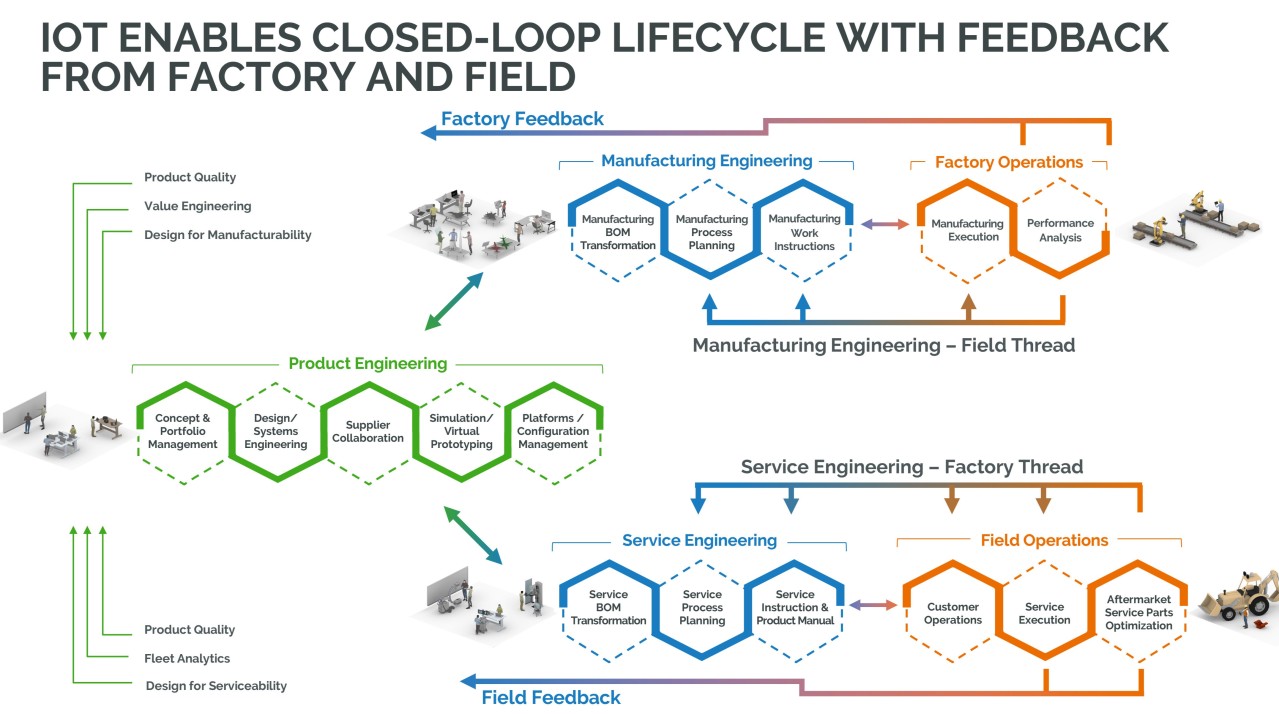
What makes a digital thread that weaves through manufacturing possible? The answer is: operational data management, which includes a host of capabilities to connect, collect, contextualize, and make data flow across offices, plants, and the field. ThingWorx, a PTC Technology, has been doing that for years, and we recently had an update briefing on version 10.0. Working with customers, PTC continues to improve, evolve, and expand the platform.
Platform for IIoT and More
ThingWorx is an established and widely used industrial Internet of Things (IIoT) platform. PTC claims over 2800 customers trust it, including over half of the Fortune 500. It also has an impressive ecosystem of partners with thousands of developers. It is widely used in industrial equipment, automotive, aerospace and defense, and medical technology companies.
Our research shows that having data available and ready to use is the most common challenge for AI projects. Together with Kepware connectors, ThingWorx can bridge to nearly any on-prem, edge, and cloud data to enable an industrial digital thread. Beyond connectivity, the ThingModel ensures the data is in context. Other keys to gaining value are the ability to build mash-up solutions and dashboards or other visualizations. These can help the manufacturers’ teams solve specific issues and analyze the complex data sets that the platform puts into context. 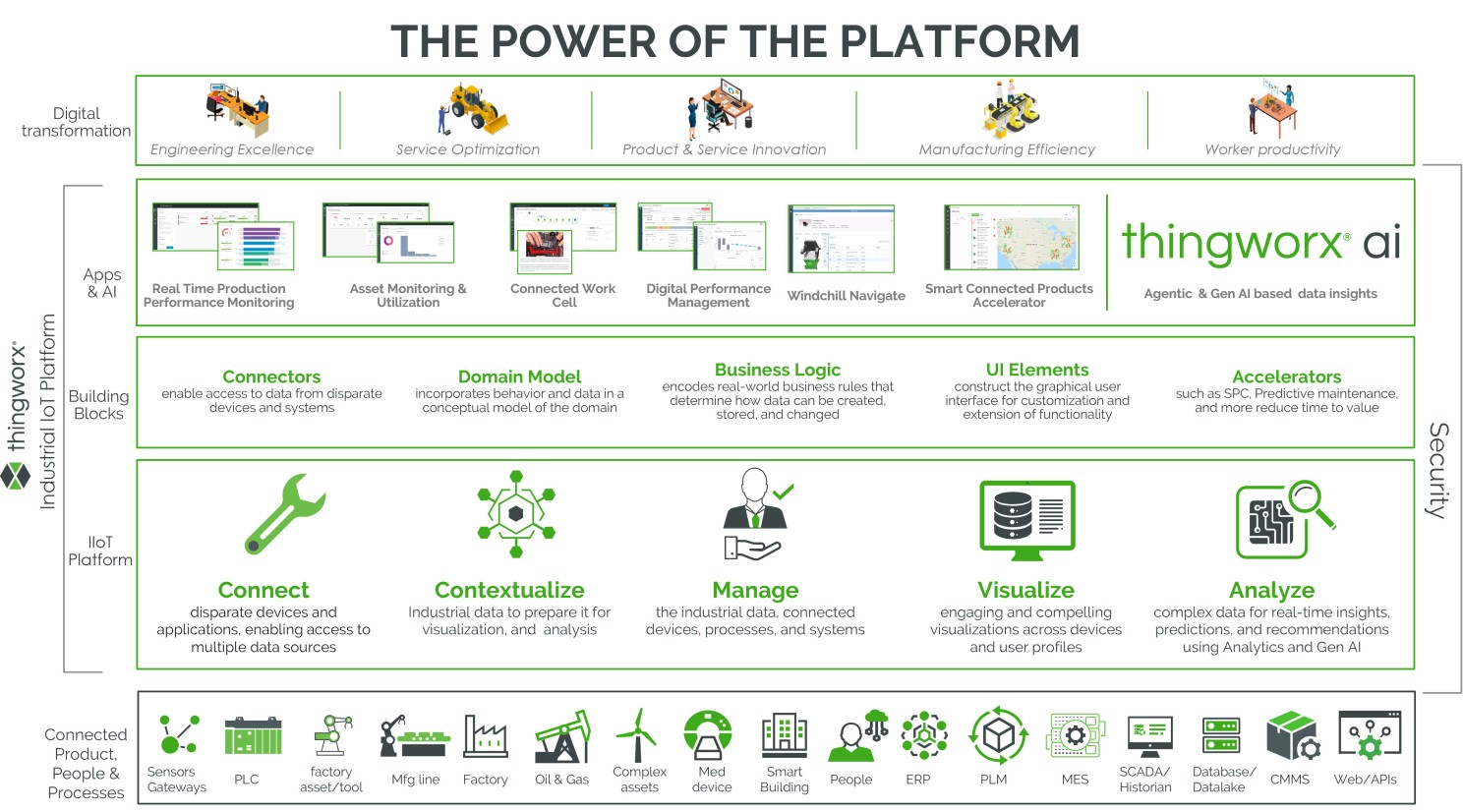
Evolving Solutions
On top of the platform, PTC has built a set of interesting solutions. These leverage the ThingWorx platform for data management, but go well beyond. These pre-built solutions deliver specific, targeted capabilities.
- Real Time Production Performance Monitoring includes interactive dashboards showing production KPIs as they change.
- Asset Monitoring and Utilization is often the basis for a profitable service or product-as-a-service (PaaS) business for equipment makers whose products have a long lifecycle in the field.
- The Connected Work Cell (CWC) delivers digital work instructions and guidance. It helps ensure that entire high-mix and high-volume work areas are coordinated and working effectively. PTC says over 80 sites already use it, with double-digit benefits in productivity, training time, and scrap.
- Digital Performance Management (DPM) supports continuous improvement and boosts overall throughput effectiveness (OTE), leveraging time savings as the key to comparable and business-meaningful performance reporting.
- Windchill Navigate enables product engineers to access useful data in ThingWorx without leaving the PLM. The latest release also improves work instruction availability for plant employees based on Windchill product data.
- Accelerators for smart connected products (SCP), generative AI, and analytics are predefined configurations or starter applications that customers can customize for their needs.
New in Version 10
During the MLC Rethink conference, PTC released ThingWorx Version 10. We were particularly impressed with IoT Streams, which deliver fast access to time-series industrial data from anywhere in the company. To do this, ThingWorx 10.0 aligns with Kafka and soon, MQTT, for data flows, contextualizes the data. Upcoming releases enable it to feed into a data lake or AI model. PTC is partnering with Databricks and Microsoft Fabric on this. We see this as a crucial improvement for industrial DataOps.
Performance enhancements include better caching, better server scalability, and reduced response times. Security upgrades to TLS, Tomcat, and Java are designed to meet the needs of regulated industries such as federal contractors and medical devices. The 10.0 version also updates analytics and integration with genAI tools[AT1] [AT2] , and includes a native debugger to boost development productivity.

Customer Examples
ThingWorx has many fascinating customer examples of business value.
- MedTech company Elekta delivers PaaS using ThingWorx. It found that its connected assets are utilized 3X more than non-connected assets. It can now resolve 30% of issues remotely and performs hundreds of preventative actions each year.
- One large manufacturer has deployed nearly 1000 ThingWorx applications and saved almost $1M with diverse detection capabilities.
- Manufacturers in automotive supply and medical contract manufacturing use the DPM solution to digitize and accelerate their continuous improvement efforts.
- Bridgestone uses ThingWorx for systematic performance optimization, with ThingWorx for data contextualization and DPM to optimize complex operations such as splicing.
Looking Forward
Clearly, the original scope of ThingWorx as an IIoT Platform is central, but it keeps growing. Solutions and accelerators are becoming more robust and scalable with users’ input. As most software providers today, AI is a significant focus for the roadmap.
Our key takeaway is that ThingWorx with Kepware for industrial connectivity has grown to be more capable as an industrial data management and data operations platform than we’d realized. All the essentials are there and being improved regularly. This makes ThingWorx a capable platform for AI and applications using an array of industrial and enterprise data.
Thank you, Ayush Tiwari, for taking the time to brief Julie Fraser and Rick Franzosa on the latest for ThingWorx. We look forward to following your continued progress in the market.
[post_title] => PTC Strengthens ThingWorx Industrial Data Management Platform [post_excerpt] => [post_status] => publish [comment_status] => open [ping_status] => open [post_password] => [post_name] => thingworx-industrial-data-management-platform [to_ping] => [pinged] => [post_modified] => 2025-09-16 09:01:01 [post_modified_gmt] => 2025-09-16 13:01:01 [post_content_filtered] => [post_parent] => 0 [guid] => https://tech-clarity.com/?p=22710 [menu_order] => 0 [post_type] => post [post_mime_type] => [comment_count] => 0 [filter] => raw ) [14] => WP_Post Object ( [ID] => 22587 [post_author] => 2574 [post_date] => 2025-08-26 08:55:51 [post_date_gmt] => 2025-08-26 12:55:51 [post_content] => Should emerging companies implement factory software before product lifecycle software? Sometimes. Julie Fraser’s blog post for the First Resonance site explores the strengths of modern MES and when it might be the priority application to implement, even when PLM is not yet in place.
Should emerging companies implement factory software before product lifecycle software? Sometimes. Julie Fraser’s blog post for the First Resonance site explores the strengths of modern MES and when it might be the priority application to implement, even when PLM is not yet in place.
Software for a Manufacturing Business
Young companies, especially those with breakthrough products, typically start as R&D operations. This blog post explains what MES is - and how modern factory systems are often doing more than just guiding and tracking the operation. It also points to why MES is crucial, and how some of the manufacturing-focused capabilities of other systems might fall short of what a company needs to manufacture profitably. Scaling the business for reliable, cost-efficient manufacturing needs many types of software, including typically ERP, PDM and PLM, and MES. This short piece includes a view of what types of activities manufacturers need software to support.Is MES Next?
Because many companies do not have factory software in their early stages, this blog describes the strengths of MES. It also points to some capabilities that modern factory software has that older MES might not have had. The goal is to educate the reader about what to expect from such a factory system investment. The post even includes key questions to ask to help decide whether MES is the next best step. These point to pain points, prerequisites, and alignment with strategy and stage of the business. We advocate for ensuring all disciplines are at the table along with top executives who have the full purview and own the strategy software must support. Thanks to First Resonance for their support or our research. Read the full guest blog post on the First Resonance website. [post_title] => When is MES Best Implemented Before PLM? [post_excerpt] => [post_status] => publish [comment_status] => open [ping_status] => open [post_password] => [post_name] => factory-software-before-plm [to_ping] => [pinged] => [post_modified] => 2025-08-26 09:00:19 [post_modified_gmt] => 2025-08-26 13:00:19 [post_content_filtered] => [post_parent] => 0 [guid] => https://tech-clarity.com/?p=22587 [menu_order] => 0 [post_type] => post [post_mime_type] => [comment_count] => 0 [filter] => raw ) [15] => WP_Post Object ( [ID] => 22655 [post_author] => 2574 [post_date] => 2025-08-21 10:00:10 [post_date_gmt] => 2025-08-21 14:00:10 [post_content] =>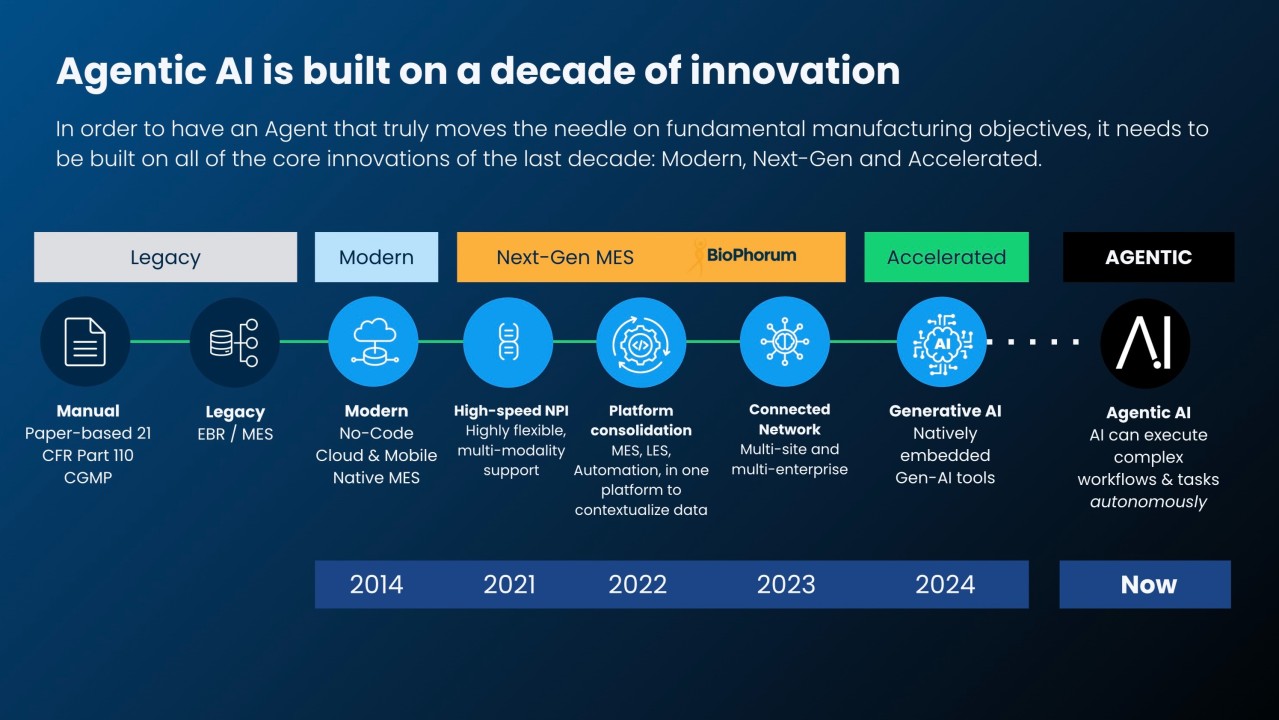 Can a highly regulated pharmaceutical or biotech company trust AI in their GXP manufacturing operations? Apprentice says yes. In the past year, they have added GenAI for intelligent context-awareness to the Tempo MES / LES / Automation solution. Now, they have added agentic AI to automate production and lab processes further. It might sound like auditors would balk, but Apprentice has built ways to control the agents’ capabilities and validate the system.
Can a highly regulated pharmaceutical or biotech company trust AI in their GXP manufacturing operations? Apprentice says yes. In the past year, they have added GenAI for intelligent context-awareness to the Tempo MES / LES / Automation solution. Now, they have added agentic AI to automate production and lab processes further. It might sound like auditors would balk, but Apprentice has built ways to control the agents’ capabilities and validate the system.
Breaking New Ground – Again
Apprentice started in 2014 with cloud-native training, and shook the market in 2020 with its GXP-focused Tempo MES being no-code, cloud-native, and available on mobile. Pharmaceutical, biotech, and vaccine companies started to adopt it with good results. These customers pushed for a broader footprint, including the lab execution (LES) and automation elements. Apprentice also added multi-site and multi-enterprise capable versions to serve its major pharma customers. Now AI is the news, and Apprentice has it, with additions that support all of the functionality and users in new, intuitive ways.
GenAI
Last year, the product gained generative AI capabilities. In Ask Apprentice, operators can ask questions about their tasks and get guidance on the spot. Supervisors can also see status and get production updates from this portion of the software. This is classic copilot capability for Tempo.
Other GenAI capabilities include a procedure author that can start with a prompt, an existing PDF procedure document, or the procedure from an MES and uses natural language for editing. It could also recommend procedures that the user could accept or reject. The AI Run Simulate capability could simulate and test procedures to ensure they behave as expected before deploying them to the operation.
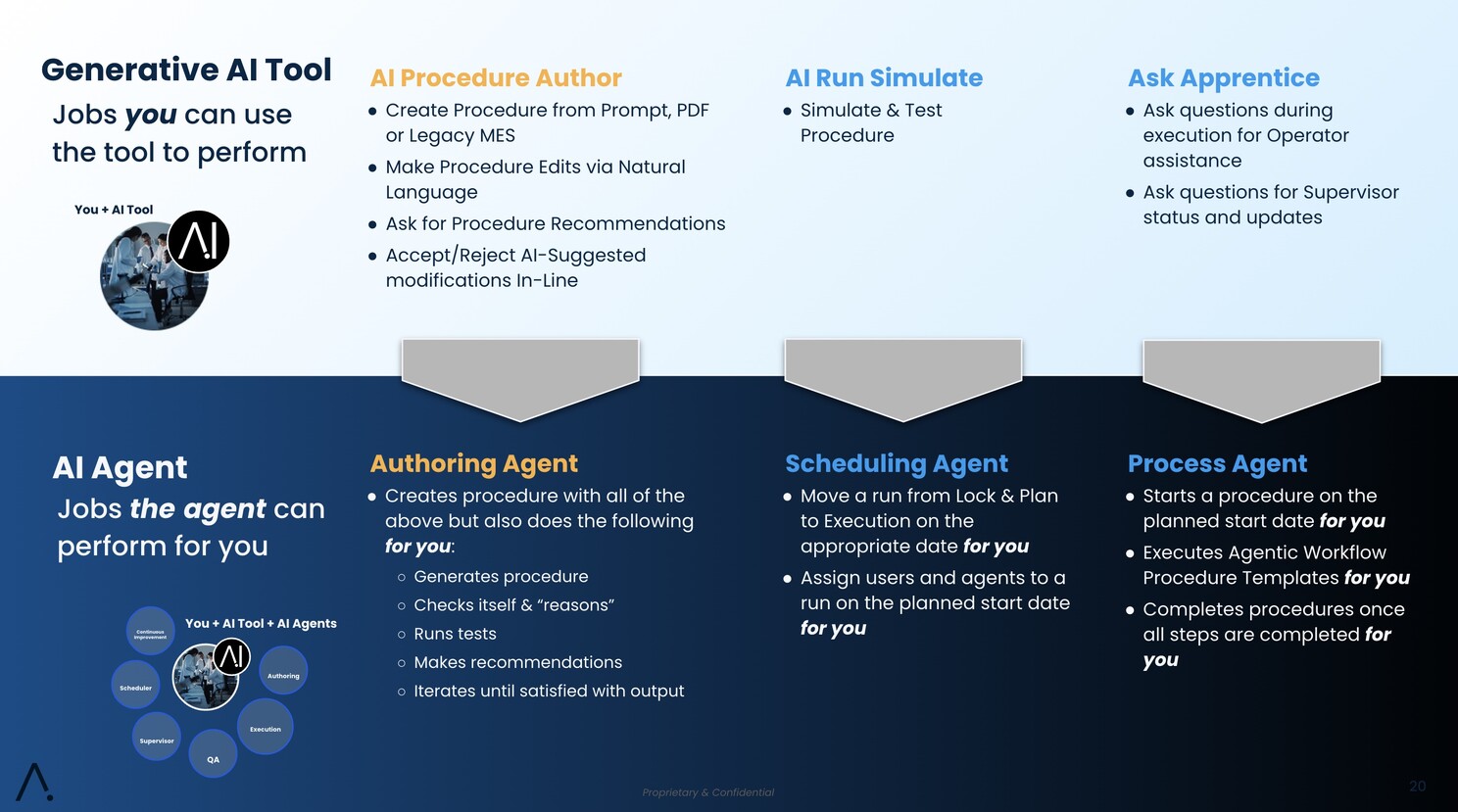
Agentic AI
Apprentice is adding agents for authoring, quality, and a limited release for process in the September release. These take GenAI capabilities to the next level, with autonomous agents to execute tasks that still have a human in the loop. They have chain-of-thought reasoning and test their work. Authoring, for example, will check itself, quality will focus on things such as review by exception and batching for bulk approval. There is also a second agent checking the work and recommending edits to the procedures. These agents can test what executed values of a recipe would be using that procedure, and can iterate until satisfied with the output. The end-of-2025 release will include additional agents for scheduling and continuous improvement. All five agents were in beta testing when we met with them in August.
These agents are built on top of everything already in the Tempo system, which our research shows is what manufacturers want. The vision Apprentice has is that instead of scaling out teams with people, their customers will use these agents for tasks no one wants to do or that are time-consuming. The agents are intended to free the people for deep thinking tasks. In this way, the company believes they will make it easier to see the financial payback of MES by increasing throughput and decreasing the cost of goods sold (COGS).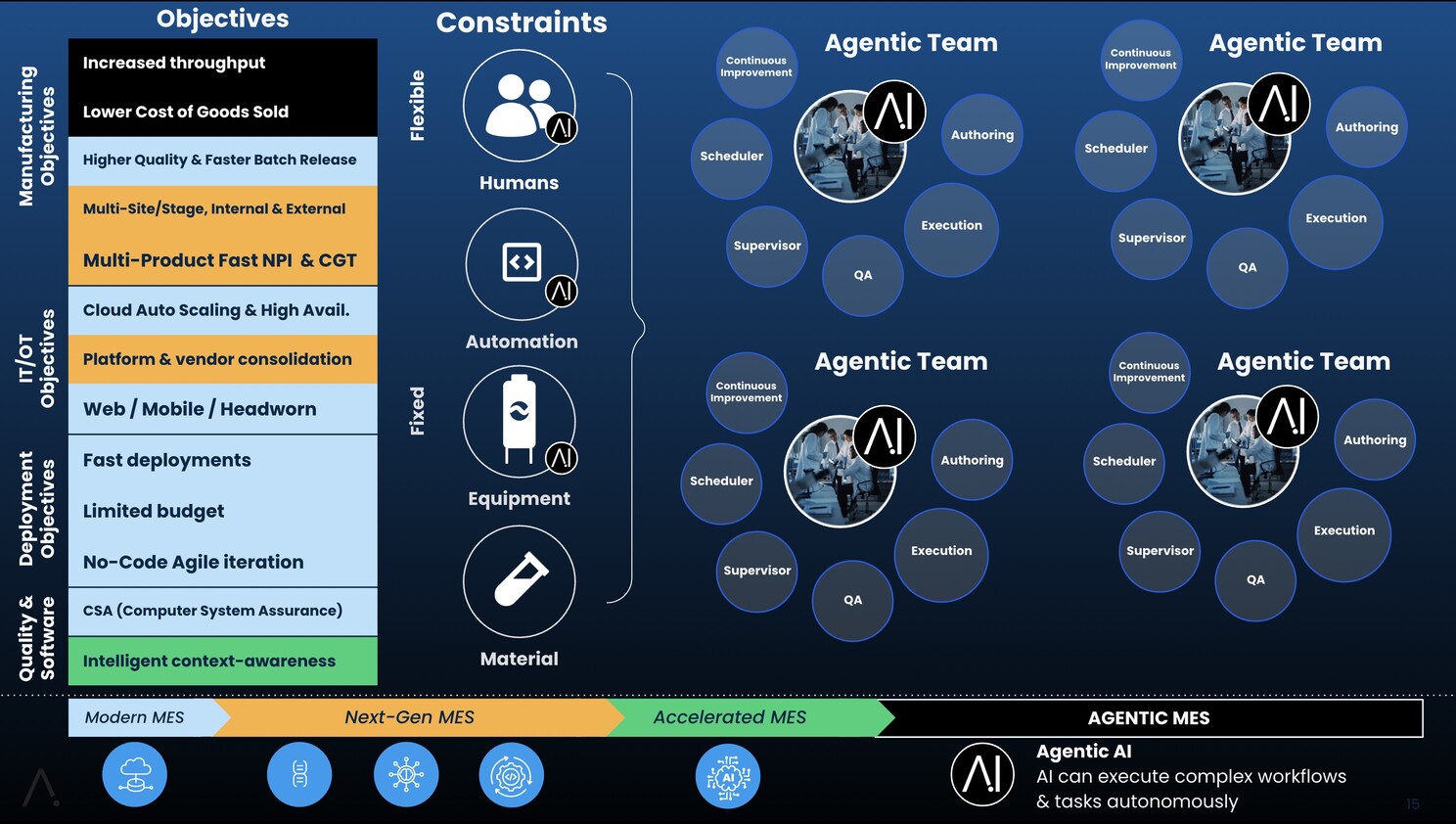
Privacy, Guardrails, and Validation
Privacy: In the regulated environments Apprentice serves, questions abound. We asked about privacy and protecting the customers’ IP in these agents. Apprentice does not train the agents on customers’ data, but rather on internally generated golden run data sets.
Guardrails: Customers are in control of what agents can do. They can set per-agent parameters either globally or for each process. They also decide who can use which agentic and GenAI capabilities. This goes beyond existing Tempo roles and access controls.
Validation: Apprentice has, for years, followed FDA guidance for risk-based computer software assurance (CSA) validation, including documenting the validation. This reduces or eliminates the need for customers to do additional validation. With the agents, they are ensuring explainable decisioning, implementing data and concept drift, and stressing input conditions to see output accuracy, among other things. Apprentice product management and quality team members participate in the Biophorum AI validation work stream and the ISPE AI Guidance steering Committee to ensure they help drive and are up to date with the latest practices.
Customer Experiences
Apprentice manages over 7000 runs and 2000 exception approvals per month. Its customers have shared their successes at events such as Pharma MES USA.
Moderna used Tempo for a global facility expansion to improve preparation for a pandemic. Its greenfield plant went live in under a year, with 28 procedures created digitally in five months. The system is integrated with SAP and AVEVA OSI PI and operates as a fully validated GMP manufacturing facility.
A biologics CDMO used Tempo to digitize their labs and manufacturing operations. Batch records were a focus, and they did it without IT overhead or MES consultants. They had six sites go from kickoff to go-live in nine months. Their iterative approach achieved review by exception.
Looking Ahead
Apprentice expects to see enormous value for customers as the agents come online in full version releases later this year. It also has long lists of improvements in functionality, integration, analytics, and reporting or communications. Thank you, Emilee Cook and Justin Foreman, for explaining the product and company progress, and Kristen Kucks for setting up the briefing for Rick Franzosa and Julie Fraser. We look forward to our next update!
[post_title] => Apprentice Adds Agentic AI to No-Code Cloud Pharma MES [post_excerpt] => [post_status] => publish [comment_status] => open [ping_status] => open [post_password] => [post_name] => pharma-mes-agentic-ai [to_ping] => [pinged] => [post_modified] => 2025-08-26 00:04:22 [post_modified_gmt] => 2025-08-26 04:04:22 [post_content_filtered] => [post_parent] => 0 [guid] => https://tech-clarity.com/?p=22655 [menu_order] => 0 [post_type] => post [post_mime_type] => [comment_count] => 0 [filter] => raw ) [16] => WP_Post Object ( [ID] => 22535 [post_author] => 2 [post_date] => 2025-08-20 09:59:21 [post_date_gmt] => 2025-08-20 13:59:21 [post_content] => Over the last seven years we’ve researched what companies are doing to drive long-term, sustainable business success. This year we extend our focus with a new look at business sovereignty and a deeper look into AI. What are the biggest disruptors companies face? What strategies are companies adopting? What priorities are they placing on the critical factors that drive success? What technologies are they employing? And how has the changed over the last year. Take a look at our survey results to find out.
Please enjoy the summary* below. For the full research, please visit our sponsor Dassault Systèmes (registration required).
Over the last seven years we’ve researched what companies are doing to drive long-term, sustainable business success. This year we extend our focus with a new look at business sovereignty and a deeper look into AI. What are the biggest disruptors companies face? What strategies are companies adopting? What priorities are they placing on the critical factors that drive success? What technologies are they employing? And how has the changed over the last year. Take a look at our survey results to find out.
Please enjoy the summary* below. For the full research, please visit our sponsor Dassault Systèmes (registration required).
Table of Contents
- Companies Transforming in Response to Shifting Risk and Disruption
- Rising Business Risk and Disruption
- Significant Shift in Risk and Disruption this Year
- Responding to Risk and Disruption
- Shifting Long-Term Success Drivers
- Shifting Strategy and Initiative Drivers
- Business Sovereignty is Prevalent
- ESG Drivers are Consistent with Last Year, and Growing
- Technology's Importance to Business Success
- Technology Supports Strategy and Drives Direct Value
- AI Targets Multiple Goals
- AI Faces Significant Challenges
- Conclusions and Recommendations
- About the Research
- Acknowledgments
Companies Transforming in Response to Shifting Risk and Disruption
Responding to Shifting Risk and Disruption We’ve tracked continued increases in business risk and disruption over the seven years of this survey on long-term business success. It shows that risk and disruption are the default in global markets. The source of the risk varies, and this year’s survey of over 200 companies shows significant growth in the impact of financial market issues including tariffs and trade wars, along with political uncertainty and the effect of continued armed conflict in Europe. Our prior surveys concluded that companies turn to innovation, agility, and digital transformation to overcome disruption. This year, we expanded our research to include two new strategic imperatives we see as increasingly important: cybersecurity and business sovereignty. Survey results show both are significant factors that must be considered for long-term, sustainable business success.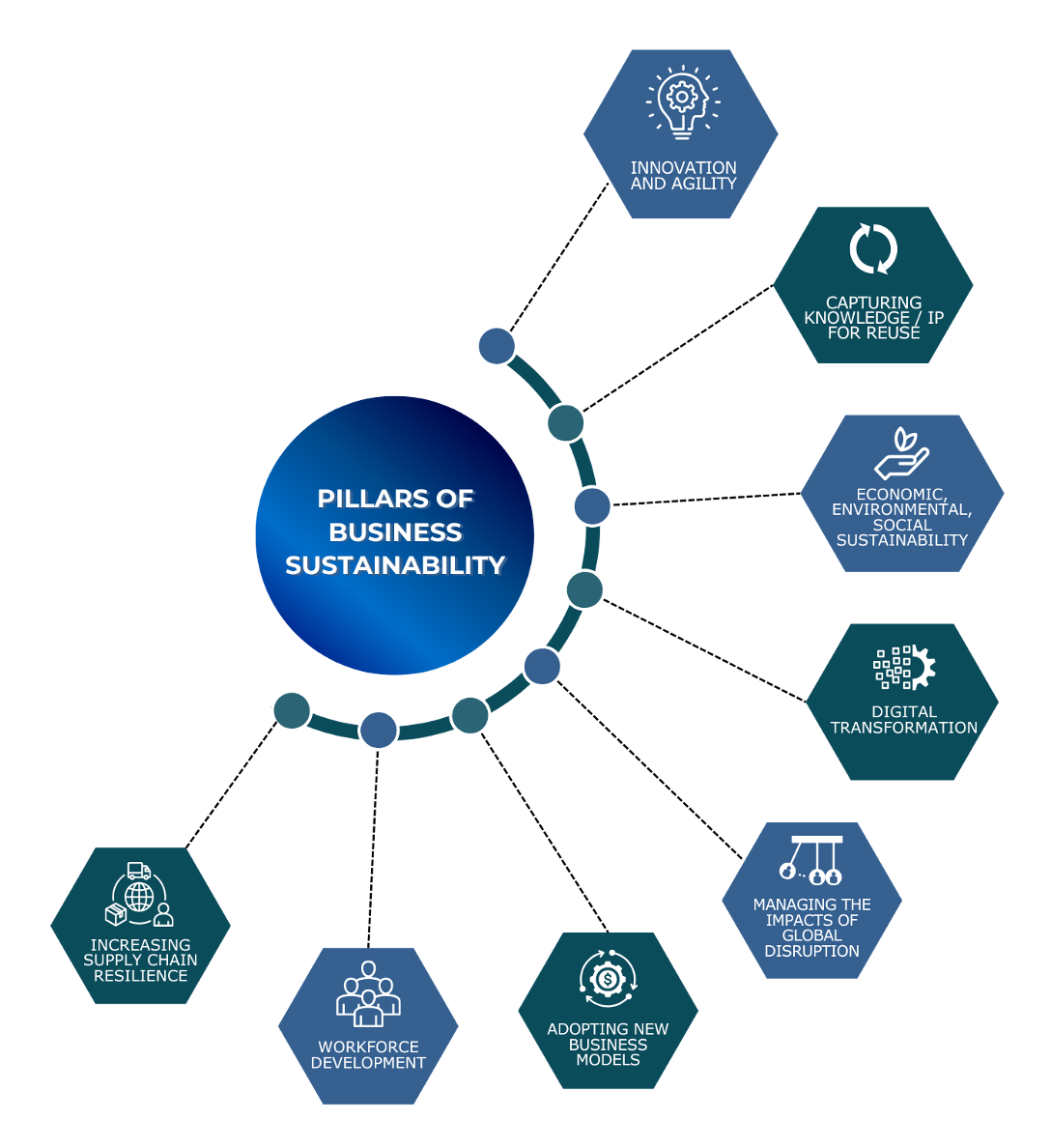 ESG for Sustainable Business Success
As always, the study looks at ESG (environmental, sustainability, and governance) in the context of long-term success and profitability. The results show that the vast majority, 86%, say that environmental sustainability is critical or important to the long-term success of their company. The study also shows that ESG strategy drivers, including internal goals for net zero, customer demands, and increased calls for transparency like product passports, have increased.
Digital Transformation is Crucial to Success
As before, survey responses show the importance of digital transformation to long-term success. This year, we added a deeper line of inquiry into the adoption and strategic value of AI (artificial intelligence). Not surprisingly, companies have broad goals for AI, and it is delivering business value. Let’s dig into the details on how companies plan to focus on the essential pillars of long-term business sustainability to ensure business success.
ESG for Sustainable Business Success
As always, the study looks at ESG (environmental, sustainability, and governance) in the context of long-term success and profitability. The results show that the vast majority, 86%, say that environmental sustainability is critical or important to the long-term success of their company. The study also shows that ESG strategy drivers, including internal goals for net zero, customer demands, and increased calls for transparency like product passports, have increased.
Digital Transformation is Crucial to Success
As before, survey responses show the importance of digital transformation to long-term success. This year, we added a deeper line of inquiry into the adoption and strategic value of AI (artificial intelligence). Not surprisingly, companies have broad goals for AI, and it is delivering business value. Let’s dig into the details on how companies plan to focus on the essential pillars of long-term business sustainability to ensure business success.
Significant Shift in Risk and Disruption this Year
The Impact of Geopolitical Factors Grew Risk and disruption factors negatively impacting business shift year to year. This year, the drivers experienced a significant shift. Financial market issues grew steadily over the last four years, and are now the most commonly reportednegative factor. This year it grew by 24%, likely due to recent tariffs and trade wars. Similarly, political uncertainty rose sharply this year, increasing by 74%. Fallout from armed conflict also increased substantially last year, although negative impacts are still less common than from other factors.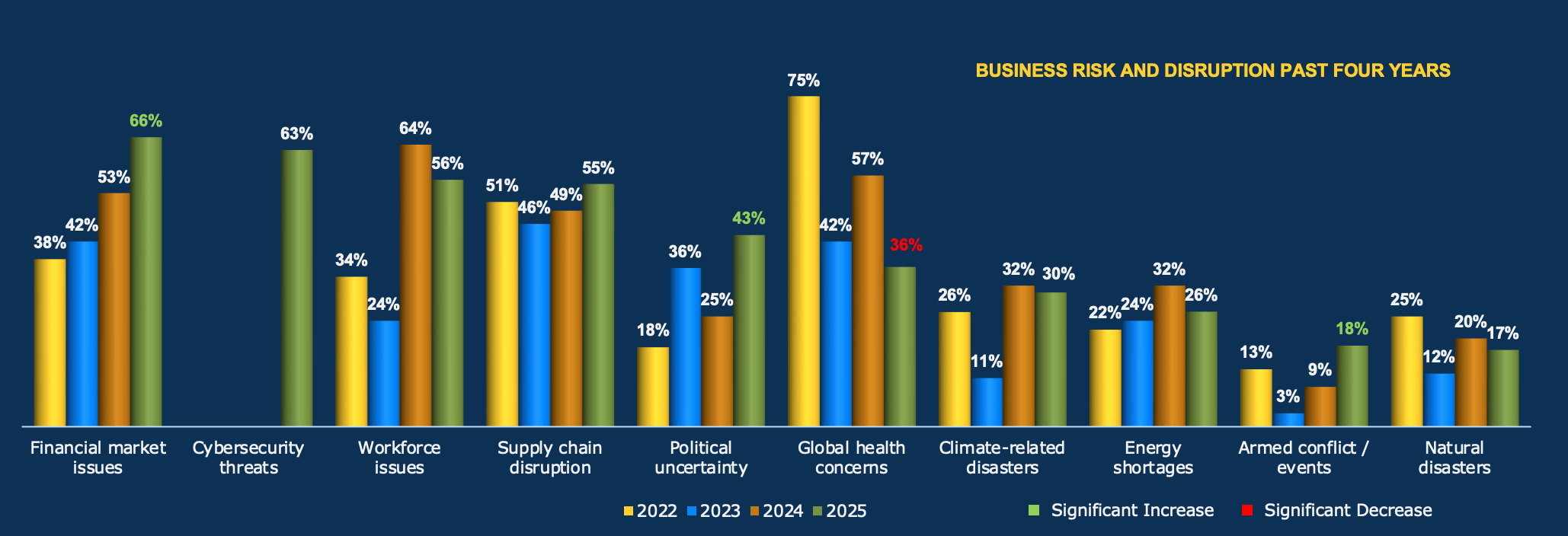 Cybersecurity Threat is Significant
This year’s research began tracking the negative business impact of cybersecurity. This digital threat debuted as the second most commonly reported risk over the last year and was reported by almost two-thirds of respondents. Companies today can’t ignore online threats, and we expect this to continue as companies become increasingly digitalized.
Other Factors Subsided
Risks come and go. For example, the impact of global health concerns dropped significantly this year. Workforce issues continue to plague companies, but have dropped slightly in prevalence after a significant increase last year. The impact of energy shortages also subsided somewhat, perhaps as companies learned to deal with issues and uncertainty decreased. Despite these reductions, of course, any of these could become significant issues in the coming year, demanding vigilance.
Cybersecurity Threat is Significant
This year’s research began tracking the negative business impact of cybersecurity. This digital threat debuted as the second most commonly reported risk over the last year and was reported by almost two-thirds of respondents. Companies today can’t ignore online threats, and we expect this to continue as companies become increasingly digitalized.
Other Factors Subsided
Risks come and go. For example, the impact of global health concerns dropped significantly this year. Workforce issues continue to plague companies, but have dropped slightly in prevalence after a significant increase last year. The impact of energy shortages also subsided somewhat, perhaps as companies learned to deal with issues and uncertainty decreased. Despite these reductions, of course, any of these could become significant issues in the coming year, demanding vigilance.
Conclusions and Recommendations
Be Prepared to Respond with Agility Although the underlying factors shift with the times, business risk and disruption continue to grow. Over the last three years, the issues leading to negative business impacts have shifted from supply chain disruptions to workforce issues to the current impact of global financial issues. To address the risk, companies are adjusting the focus of their actions. This year, companies are increasing emphasis and accelerating digital transformation, developing the workforce of the future, and creating supply chain resilience. Continue Focusing on Long-Term Success, including ESG In addition to addressing time-sensitive disruptors, companies must maintain focus on the fundamentals of business to be successful over the long term. Additional pillars that companies report are critical to long-term success include product/service innovation and agility, environmental and social responsibility, and developing the workforce of the future.
ESG drivers remain steady, although the demand for transparency, including product passports, has increased. Even in these challenging times, when priorities may falter, companies this year are 26% more likely to include ESG as a critical long-term success driver, and more companies are incorporating ESG priorities into their corporate strategy and actions.
Focus on Resilience and Explore Sovereignty
Supply chain resilience continued to grow in importance to long-term success. One approach to accomplishing this is seeking supply chain sovereignty. We observed companies putting significant emphasis on supply chain independence and found that many are also pursuing sovereignty in other areas, including technology and data sovereignty.
Extend Digital Transformation Strategies with AI, Cybersecurity
In addition to addressing time-sensitive disruptors, companies must maintain focus on the fundamentals of business to be successful over the long term. Additional pillars that companies report are critical to long-term success include product/service innovation and agility, environmental and social responsibility, and developing the workforce of the future.
ESG drivers remain steady, although the demand for transparency, including product passports, has increased. Even in these challenging times, when priorities may falter, companies this year are 26% more likely to include ESG as a critical long-term success driver, and more companies are incorporating ESG priorities into their corporate strategy and actions.
Focus on Resilience and Explore Sovereignty
Supply chain resilience continued to grow in importance to long-term success. One approach to accomplishing this is seeking supply chain sovereignty. We observed companies putting significant emphasis on supply chain independence and found that many are also pursuing sovereignty in other areas, including technology and data sovereignty.
Extend Digital Transformation Strategies with AI, Cybersecurity
 Digital transformation is seen as the most common factor impacting long-term success. It’s the most common area companies are accelerating to combat short-term disruption. Technology is essential to long-term business success and adds direct value. Two areas getting significant attention are AI and cybersecurity.
Cybersecurity, as a new focus, is top of mind for executives, not just technologists. It showed up as both a significant driver of long-term success and a significant risk that creates negative impacts on companies. Company leaders are also focused on AI and have a wide variety of goals, are adopting a variety of approaches, and are gaining value despite facing both business and technical challenges. We see a trend toward companies looking to their solution providers to help with holistic, industry- and application-specific solutions built into their existing solution platform to speed up and ease adoption.
Remain Vigilant and Prepare for Disruption
This survey, as the previous ones, makes it clear that company success and profitability are under siege by a variety of challenging and changing factors. To survive, companies will need to continue to monitor and adapt to risk and disruption. We believe those that digitally transform will be better positioned to overcome short-term risk and disruption and improve the performance in the pillars that allow them to achieve long-term success.
*This summary is an abbreviated version of the ebook and does not contain the full content. For the full report, please visit our sponsor Dassault Systèmes.
If you have difficulty obtaining a copy of the research, please contact us.
[post_title] => Executive Strategies for Sustainable Business Success 2025
[post_excerpt] =>
[post_status] => publish
[comment_status] => open
[ping_status] => open
[post_password] =>
[post_name] => long-term-success
[to_ping] =>
[pinged] =>
[post_modified] => 2025-08-20 09:59:21
[post_modified_gmt] => 2025-08-20 13:59:21
[post_content_filtered] =>
[post_parent] => 0
[guid] => https://tech-clarity.com/?p=22535
[menu_order] => 0
[post_type] => post
[post_mime_type] =>
[comment_count] => 0
[filter] => raw
)
[17] => WP_Post Object
(
[ID] => 22496
[post_author] => 2572
[post_date] => 2025-08-19 09:13:59
[post_date_gmt] => 2025-08-19 13:13:59
[post_content] =>
Digital transformation is seen as the most common factor impacting long-term success. It’s the most common area companies are accelerating to combat short-term disruption. Technology is essential to long-term business success and adds direct value. Two areas getting significant attention are AI and cybersecurity.
Cybersecurity, as a new focus, is top of mind for executives, not just technologists. It showed up as both a significant driver of long-term success and a significant risk that creates negative impacts on companies. Company leaders are also focused on AI and have a wide variety of goals, are adopting a variety of approaches, and are gaining value despite facing both business and technical challenges. We see a trend toward companies looking to their solution providers to help with holistic, industry- and application-specific solutions built into their existing solution platform to speed up and ease adoption.
Remain Vigilant and Prepare for Disruption
This survey, as the previous ones, makes it clear that company success and profitability are under siege by a variety of challenging and changing factors. To survive, companies will need to continue to monitor and adapt to risk and disruption. We believe those that digitally transform will be better positioned to overcome short-term risk and disruption and improve the performance in the pillars that allow them to achieve long-term success.
*This summary is an abbreviated version of the ebook and does not contain the full content. For the full report, please visit our sponsor Dassault Systèmes.
If you have difficulty obtaining a copy of the research, please contact us.
[post_title] => Executive Strategies for Sustainable Business Success 2025
[post_excerpt] =>
[post_status] => publish
[comment_status] => open
[ping_status] => open
[post_password] =>
[post_name] => long-term-success
[to_ping] =>
[pinged] =>
[post_modified] => 2025-08-20 09:59:21
[post_modified_gmt] => 2025-08-20 13:59:21
[post_content_filtered] =>
[post_parent] => 0
[guid] => https://tech-clarity.com/?p=22535
[menu_order] => 0
[post_type] => post
[post_mime_type] =>
[comment_count] => 0
[filter] => raw
)
[17] => WP_Post Object
(
[ID] => 22496
[post_author] => 2572
[post_date] => 2025-08-19 09:13:59
[post_date_gmt] => 2025-08-19 13:13:59
[post_content] =>  How can shipbuilding companies improve engineering productivity?
Shipbuilding has become increasingly complex, with a growing number of owner and sustainability requirements, new technologies, suppliers, and co-makers. Engineers are critical to successfully meeting these requirements. Yet, engineers regularly lose productivity to non-value-add tasks that rob them of their ability to innovate and threaten their company's ability to compete, differentiate, and grow. Plus, this wasted time leaves little bandwidth to respond agilely to the fluctuating needs of the global economy. Also, wasted time increases the risk of late delivery penalties. Imagine the potential of identifying and removing the most common non-value-add activities engineers face and empowering them to focus on designing better ships.
This research examines how engineers spend their time, where they lose productivity, and the impact on the business. It then identifies solutions and approaches to reduce time wasters. Based on a survey of 228 manufacturers across industries, this report looks at the challenges and opportunities from the perspective of shipbuilding companies.
Please enjoy the summary* below. For the full research, please visit our sponsor, Siemens (registration required).
This report is based off the research published in The Business Value of Reducing Engineering Time Wasters which takes a look across all industries.
For other industry-specific related research, read:
How can shipbuilding companies improve engineering productivity?
Shipbuilding has become increasingly complex, with a growing number of owner and sustainability requirements, new technologies, suppliers, and co-makers. Engineers are critical to successfully meeting these requirements. Yet, engineers regularly lose productivity to non-value-add tasks that rob them of their ability to innovate and threaten their company's ability to compete, differentiate, and grow. Plus, this wasted time leaves little bandwidth to respond agilely to the fluctuating needs of the global economy. Also, wasted time increases the risk of late delivery penalties. Imagine the potential of identifying and removing the most common non-value-add activities engineers face and empowering them to focus on designing better ships.
This research examines how engineers spend their time, where they lose productivity, and the impact on the business. It then identifies solutions and approaches to reduce time wasters. Based on a survey of 228 manufacturers across industries, this report looks at the challenges and opportunities from the perspective of shipbuilding companies.
Please enjoy the summary* below. For the full research, please visit our sponsor, Siemens (registration required).
This report is based off the research published in The Business Value of Reducing Engineering Time Wasters which takes a look across all industries.
For other industry-specific related research, read:
- Reducing Engineering Time Wasters in Aerospace & Defense
- Reducing Engineering Time Wasters in Heavy Equipment
- Reducing Engineering Time Wasters in Consumer Products
Table of Contents
- Executive Summary
- Product Development is Critical to Business Strategies
- The Time Wasters
- Implications of Time Wasters to the Business
- A Solution to Avoid Time Wasters
- Business Value from PLM
- Extending PLM Use Results in Greater Satisfaction
- How Companies Implement PLM
- Additional Values Due to the Cloud
- Conclusions
- Recommendations
- About the Research
- Acknowledgments
Executive Summary
Engineers Impact Business Success Engineering is critical to exceptional ship design. Likewise, engineers are crucial to ensure designs incorporate owner requirements, leverage new technology, meet environmental and compliance regulations, stay within budget, and meet delivery dates. Therefore, empowering engineers is key to the successful execution of business strategies. Too Many Time Wasters Unfortunately, engineers report spending too much time on non-value-added work with too many interruptions, taking them away from critical innovation work. Furthermore, 87% of companies developing complex products, such as ships, say this loss in engineering productivity comes at a significant business cost due to missed deadlines, higher costs, less innovation, and poor quality. One way to overcome productivity losses is to manage product data better and make it accessible to those who need it, when they need it, especially suppliers. Reclaiming Wasted Time This report identifies substantial engineering time wasters and examines them from the perspective of shipbuilding companies. It explores how companies of all sizes reclaim lost time by examining the use and value of PLM (Product Lifecycle Management) solutions to centralize data across multiple domains, manage processes, and collaborate better including with suppliers. Incidentally, PLM users reported fewer changes due to outdated information and errors, significantly reducing non-value-added work and shortening development times. This report also examines how companies select and use PLM solutions, including cloud-based implementations. The Time Wasters
The Time Wasters
What Slows Engineers Down?
The graph identifies the top engineering time wasters faced by companies developing complex products like ships. The findings highlight how much time engineers waste on non-value-added work. They need better ways to automate tedious tasks so engineers can focus more energy on meeting customer requirements. Another top-ranking time waster, too many manual processes/bottlenecks such as spreadsheet-driven processes, emphasizes this further.
Interruptions
Similarly, constant interruptions to answer questions, share data, collaborate with internal team members, the supply chain, class societies, and clients also slow engineers down. These interruptions break an engineer's train of thought and distract them from their work.
Finding Needed Data
Companies developing complex products such as ships also waste efforts because they can’t find what they need. They waste time recreating what they can't find, wasting time and risking introducing new errors that could be avoided with more reuse. In particular, data locked in spreadsheets can be difficult to find. Better methods to centralize access to data would avoid all that searching and help get that time back.
Consolidating Data
Considering the number of disciplines involved in ship development, it can be difficult to get a consolidated view of all data associated with a ship. This makes it difficult to find, update, and share data. Instead, engineers waste time searching for it or fixing errors due to outdated data. Further, these challenges negatively impact suppliers and co-makers if they can't get an accurate view of the data. Downstream lifecycle processes such as servicing, maintenance, and decommissioning may also suffer.
Conclusions
 Reclaiming Lost Time
Shipbuilders prioritize their future growth and sustained success with a market-leading product of superior quality, on time, and within budget. To support this, they can significantly boost their product development capabilities by eliminating time wasters that consume engineers' valuable time.
Companies developing complex products such as ships find that PLM can empower their engineers to innovate by significantly reducing engineers' time on non-value-added tasks. As a result, they can enjoy a competitive advantage. In addition, technological advances, such as cloud-based offerings, can reduce implementation time, cost, and difficulty, making PLM more accessible.
*This summary is an abbreviated version of the ebook and does not contain the full content. For the full report, please visit our sponsor Siemens.
If you have difficulty obtaining a copy of the research, please contact us.
[post_title] => Shipbuilding: Reducing Engineering Time Wasters
[post_excerpt] =>
[post_status] => publish
[comment_status] => open
[ping_status] => open
[post_password] =>
[post_name] => shipbuilding
[to_ping] =>
[pinged] =>
[post_modified] => 2025-08-19 09:13:59
[post_modified_gmt] => 2025-08-19 13:13:59
[post_content_filtered] =>
[post_parent] => 0
[guid] => https://tech-clarity.com/?p=22496
[menu_order] => 0
[post_type] => post
[post_mime_type] =>
[comment_count] => 0
[filter] => raw
)
[18] => WP_Post Object
(
[ID] => 22648
[post_author] => 2581
[post_date] => 2025-08-18 10:00:01
[post_date_gmt] => 2025-08-18 14:00:01
[post_content] =>
Reclaiming Lost Time
Shipbuilders prioritize their future growth and sustained success with a market-leading product of superior quality, on time, and within budget. To support this, they can significantly boost their product development capabilities by eliminating time wasters that consume engineers' valuable time.
Companies developing complex products such as ships find that PLM can empower their engineers to innovate by significantly reducing engineers' time on non-value-added tasks. As a result, they can enjoy a competitive advantage. In addition, technological advances, such as cloud-based offerings, can reduce implementation time, cost, and difficulty, making PLM more accessible.
*This summary is an abbreviated version of the ebook and does not contain the full content. For the full report, please visit our sponsor Siemens.
If you have difficulty obtaining a copy of the research, please contact us.
[post_title] => Shipbuilding: Reducing Engineering Time Wasters
[post_excerpt] =>
[post_status] => publish
[comment_status] => open
[ping_status] => open
[post_password] =>
[post_name] => shipbuilding
[to_ping] =>
[pinged] =>
[post_modified] => 2025-08-19 09:13:59
[post_modified_gmt] => 2025-08-19 13:13:59
[post_content_filtered] =>
[post_parent] => 0
[guid] => https://tech-clarity.com/?p=22496
[menu_order] => 0
[post_type] => post
[post_mime_type] =>
[comment_count] => 0
[filter] => raw
)
[18] => WP_Post Object
(
[ID] => 22648
[post_author] => 2581
[post_date] => 2025-08-18 10:00:01
[post_date_gmt] => 2025-08-18 14:00:01
[post_content] => Reinventing MES/MOM and Operations
We’ve followed Tulip since the early days and were excited to catch up and see what they have accomplished over the past year. From their inception, Tulip Interfaces deliberately set themselves apart from existing industry acronyms like MES (Manufacturing Execution Systems) and MOM (Manufacturing Operations Management). This decision offered advantages and challenges, as many manufacturers seek solutions based on a clearly defined TLA (Three Letter Acronym). Instead, Tulip introduced itself as a Frontline Operations Platform. Early adopters of the solution/toolkit were drawn to Tulip’s platform for its intuitive application development and the potential for reusability—well before “composable enterprise” became an industry buzz phrase.
Critics and skeptics initially raised concerns about the absence of a unified data model, weak configuration management, minimal revision control, governance, and limited security. Over time, however, Tulip addressed these shortcomings. The platform matured, the library of available applications expanded, and critical features were refined.
Tulip’s reach grew from its roots in discrete manufacturing to include life sciences—encompassing pharmaceuticals, biotech, and medical devices—and now extends to aerospace and defense. Tulip has continued innovating in content and data management, edge and enterprise connectivity, and security and governance throughout this evolution.
Tulip is well-positioned as a data analytics and insights platform developer designed to transform factories and manage global operations digitally. Our research shows that manufacturers investing in Analytics and AI are gaining substantial benefits (see Making Manufacturing Analytics and AI Matter). The benefits matter, as they are in the areas that match their objectives: cost, efficiency/productivity, quality, and error-proofing, most commonly.
Keys to Success - Composability and Connections
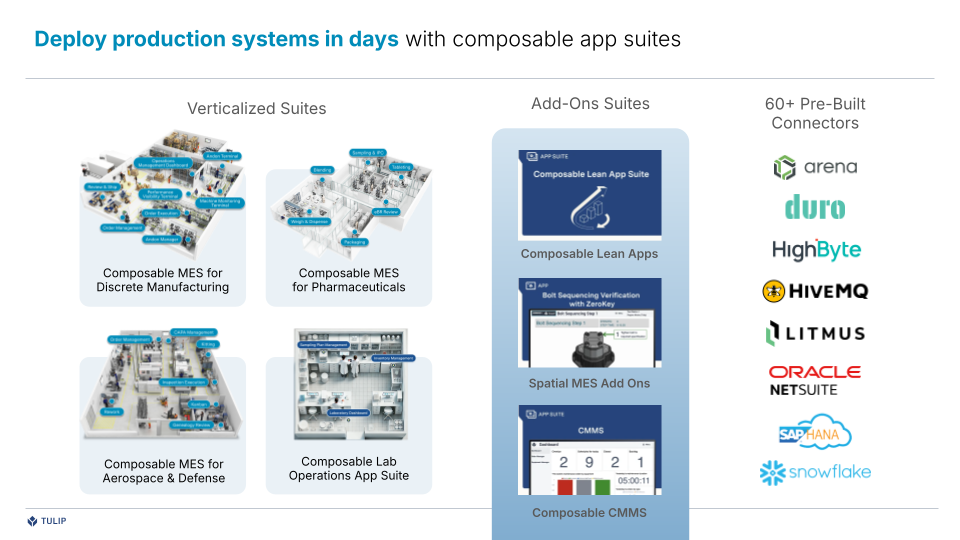
The strength of the Tulip platform has always been the ability to start with predefined functions and compose a solution that can be easily modified and/or extended to meet additional needs. To accelerate customers' abilities to create and extend these solutions, Tulip has provided a library of more than 170 predefined apps and more than 40 predefined app suites. If you are in an industry currently supported by Tulip, you will likely not be starting from scratch to build a solution for your production floor. Suppose your concern is the ability to connect to devices. In that case, Tulip supports the expected protocols for automated equipment (OPC UA, MQTT, Snowflake (UNS), etc.) and web-enabled no-code HMIs for Rockwell Automation, Inductive Automation, DMG Mori, and others. In addition, they have edge drivers for the more mundane devices that most MES vendors do not provide, label printers, scanners, torque tools, pH meters, thermocouples, cameras, scales – over two dozen device types from over thirty vendors. Coupled with drag-and-drop integration connections to ERP and SCM systems, they have created a composition platform that can be used to develop applications and connections for a production-ready system.
Keys to Success - Automations and AI

In 2024, Tulip added a workflow engine to the application creation suite. This capability is called “Automations”, as it is the ability to define workflows and automate them. Like other Tulip capabilities, their library has predefined automations for everyday tasks (more than fifteen at this writing) such as inventory update, part counts, Andon alerting, and production status. As the MES vendor community evaluates the uses of GenAI and LLMs in production, Tulip has built MCP server, their official implementation of the Model Context Protocol for the Tulip platform and is using existing connections and automations as a bridge to Agentic AI. The library already includes two: AI Automation – Defect Characterization and AI Automation – Defect Summarization.
While some skeptics felt it took Tulip way too long to add workflow capabilities, the Automations allowed them to leapfrog some of their competition, past traditional workflow to AI Agents.
Keys to Success - Domain Expertise and Scalability
To support Tulip’s continued growth across industries, it is essential to develop internal expertise in target markets and provide customers with tools and training for scaling from DIY pilots to enterprise production. Tulip is adapting functionality from apps designed for other industries to support new ones, hiring domain experts for those new target industries. This is a valid approach, admittedly time-consuming, especially where it relates to the support of domain-specific rules and regulations from CFR 21 Part 11 to FedRAMP.
The first part of full enterprise support has been achieved by building out their implementation service provider network, currently 90+ implementation partners in 25+ countries, which represents 50% growth year-over-year. However, expertise is something that is acquired over time, as other vendors have discovered. The growth rate of signing new partners does not translate to overnight success.
Future Directions
Some of the areas discussed by Tulip include:
- Their goal is to demonstrate equivalency for FedRAMP, or the Federal Risk and Authorization Management Program, in 2025. FedRAMP is a standardized security assessment and authorization approach for cloud service offerings used by U.S. federal agencies. It aims to provide a cost-effective, risk-based approach to adopting cloud services. FedRAMP ensures that cloud services meet a baseline level of security requirements before government agencies can use them.
- Development of functionality for additional enterprise content sharing across sites and divisions that use Tulip as their operations platform.
- Additional functions and UI components for composable app creation.
- Extending the capability demonstrated at Hanover Messe to create standard operating procedures (SOPs) from a PDF file to app generation from a PDF.
- Improvements in the creation and management of the Tulip ecosystem via a Tulip SDK and a device ecosystem
Thank you to Madilynn Castillo and Natan Linder for the insightful briefing.
[post_title] => Tulip: Evolving Operations for Modern Manufacturing [post_excerpt] => [post_status] => publish [comment_status] => open [ping_status] => open [post_password] => [post_name] => tulip-manufacturing [to_ping] => [pinged] => [post_modified] => 2025-08-27 00:34:35 [post_modified_gmt] => 2025-08-27 04:34:35 [post_content_filtered] => [post_parent] => 0 [guid] => https://tech-clarity.com/?p=22648 [menu_order] => 0 [post_type] => post [post_mime_type] => [comment_count] => 0 [filter] => raw ) [19] => WP_Post Object ( [ID] => 22617 [post_author] => 2581 [post_date] => 2025-08-12 10:00:23 [post_date_gmt] => 2025-08-12 14:00:23 [post_content] => Where can discrete manufacturers go to find an MES/MOM solution developed by manufacturers with nearly a decade of production usage and experience as a multi-tenant cloud solution? 42Q, a wholly owned subsidiary of Sanmina Corporation, is an obvious choice. They provide:
Where can discrete manufacturers go to find an MES/MOM solution developed by manufacturers with nearly a decade of production usage and experience as a multi-tenant cloud solution? 42Q, a wholly owned subsidiary of Sanmina Corporation, is an obvious choice. They provide:
- Smart Factory, a fully featured MES/MOM solution,
- Connected Manufacturing, providing real-time visibility across diverse supply chains, regardless of the MES environment,
- Xcelerators, which quickly digitize specific operational areas in your manufacturing ecosystem and, most recently,
- Xconnect, a low-code-driven robust backend service, is designed to simply, seamlessly, and securely bridge the gap between customers' enterprise systems and the dynamic factory floor.
- To top it off, they have also released Arthur, a GenAI-based chatbot.
Origins and Smart Manufacturing Evolution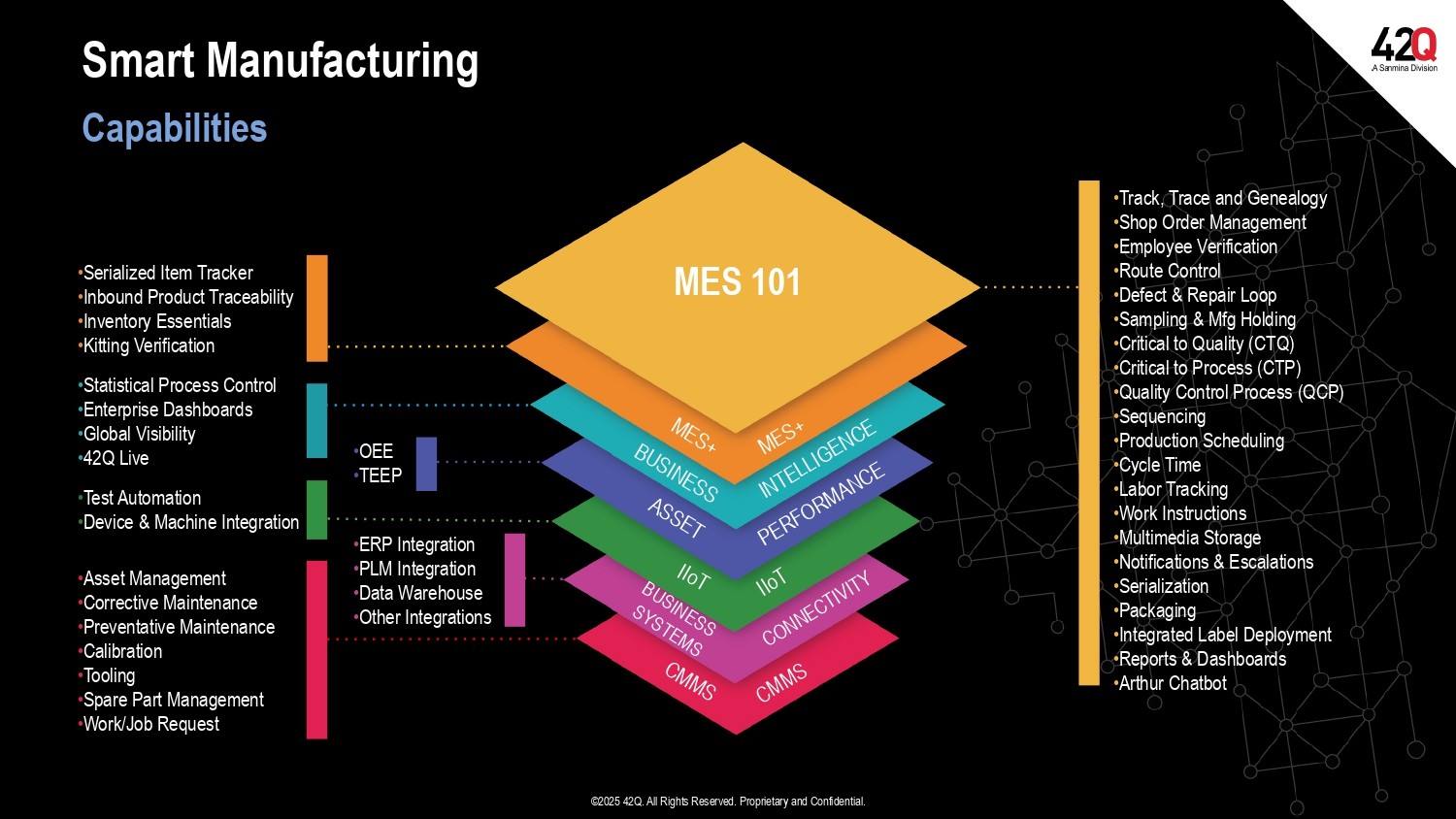
As pioneers in the multi-tenant cloud MES world, they faced challenges from skeptics who believed cloud hosting was inappropriate for MES. However, the broad functionality developed over the years for Sanmina was instantly available for 42Q clients. This was not a ‘minimally viable product’ at launch; it was a battle-tested solution with decades of use in multiple industries across a global footprint.
Xcelerators and Deployment Expertise
MES implementations have always been resource-intensive, long, and complicated. In surveys conducted for MESA International over seven years, the results showed MES implementations averaged between 12 and 18 months, and year to year, this average showed no sign of dropping. 42Q’s answer to this decades-old problem is their Xcelerators, including Digital Factory Xcelerator, eDHR Xcelerator, OEE Xcelerator, CMMS Xcelerator, and IIoT Xcelerator, all designed to meet a time-to-value of 90 days. Customers give 42Q high marks for quick response and quick delivery of solutions, as well as a willingness to collaborate and to take the time to understand the customer's business and unique challenges. 42Q was quick to diagnose and troubleshoot issues, even issues unrelated to the 42Q platform. Of course, as a multi-tenant cloud solution, there is a massive deployment time advantage over on-premises systems regarding multisite deployments. These Xcelerators have been applied in multiple industries, including automotive, aerospace and defense, medical devices, high tech electronics, communication networks, and other discrete industrial settings.Connected Manufacturing and Data Consolidation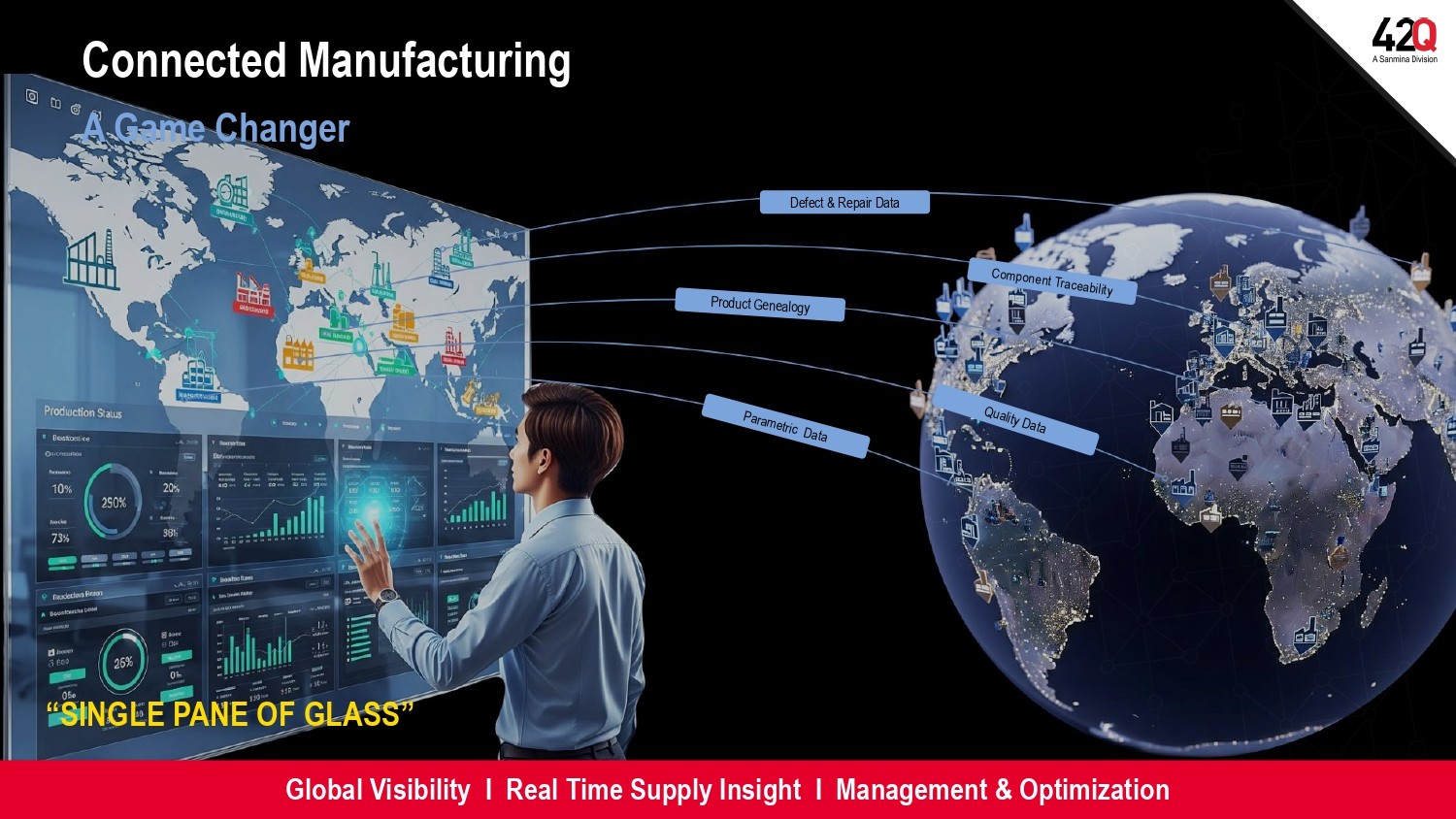
Another advantage 42Q brings to the market is Connected Manufacturing, the infrastructure to create a single data pipeline to consolidate operational data. It streamlines operations by integrating data from all suppliers’ locations, offering a unified, single-pane-of-glass view, empowering teams with insights to make informed decisions and optimize global operations. A customer reported that 42Q has allowed them to consolidate data from their global factories and to support a data pipeline into their manufacturing data lake for analysis at scale. Customers can use this not only to identify quality issues but also to support benchmarking. Connected Manufacturing can also be used to discover emerging best practices at a local level that can be leveraged globally.
These capabilities are not limited to the 42Q applications umbrella. Connected Manufacturing can be implemented even in supplier networks where some suppliers do not use 42Q, enabling unified benchmarking and analytics.
Xconnect
Xconnect, announced this year at the Hanover Messe show, is a backend service designed to bridge the gap between customers' enterprise systems and the factory floor. It securely links ERP and customer systems with factory equipment, machines, and IIoT devices for bidirectional data flow. Xconnect is a data integration tool at the core of 42Q's smart manufacturing strategy. It provides a flexible, no-code/low-code solution for connecting and transforming data from various sources, enabling visibility, automating controls and empowering decision makers across your manufacturing ecosystem.Arthur – a Chatbot with 30 years of manufacturing experience
Chatbots have become relatively common, especially in customer service. Their performance can be spotty, often due to training the bots using large language models. Manufacturers may be skeptical of the maturity and value of these chatbots, and fearful of the widely reported hallucinations from commercial GenAI systems like Copilot, ChatGPT, Claude from Anthropic, Google’s Gemini, and Meta AI.
42Q has released their own Chatbot, Arthur. Arthur has been trained in the 42Q Content Hub and Learning Management System, leveraging 30 years of global manufacturing expertise. Powered by the advanced Claude Sonnet LLM and orchestrated by Amazon Bedrock, Arthur provides accurate, context-rich responses through Retrieval Augmented Generation (RAG). Arthur is multilingual, context-aware, and can interpret data in any language or format. Consider Arthur, the knowledgeable senior shop expert who can quickly evaluate an issue based on their experience and offer alternative approaches for solving problems, ensuring reliable, actionable insights without the risks associated with general-purpose GenAI.
Thank you, Wellington Giolo, for the detailed briefing.
[post_title] => 42Q – First MES/MOM to the Cloud and Still Going Strong
[post_excerpt] =>
[post_status] => publish
[comment_status] => open
[ping_status] => open
[post_password] =>
[post_name] => 42q-mes-mom
[to_ping] =>
[pinged] =>
[post_modified] => 2025-08-25 23:39:05
[post_modified_gmt] => 2025-08-26 03:39:05
[post_content_filtered] =>
[post_parent] => 0
[guid] => https://tech-clarity.com/?p=22617
[menu_order] => 0
[post_type] => post
[post_mime_type] =>
[comment_count] => 0
[filter] => raw
)
)
[post_count] => 20
[current_post] => -1
[before_loop] => 1
[in_the_loop] =>
[post] => WP_Post Object
(
[ID] => 22809
[post_author] => 2572
[post_date] => 2025-09-17 09:57:38
[post_date_gmt] => 2025-09-17 13:57:38
[post_content] => 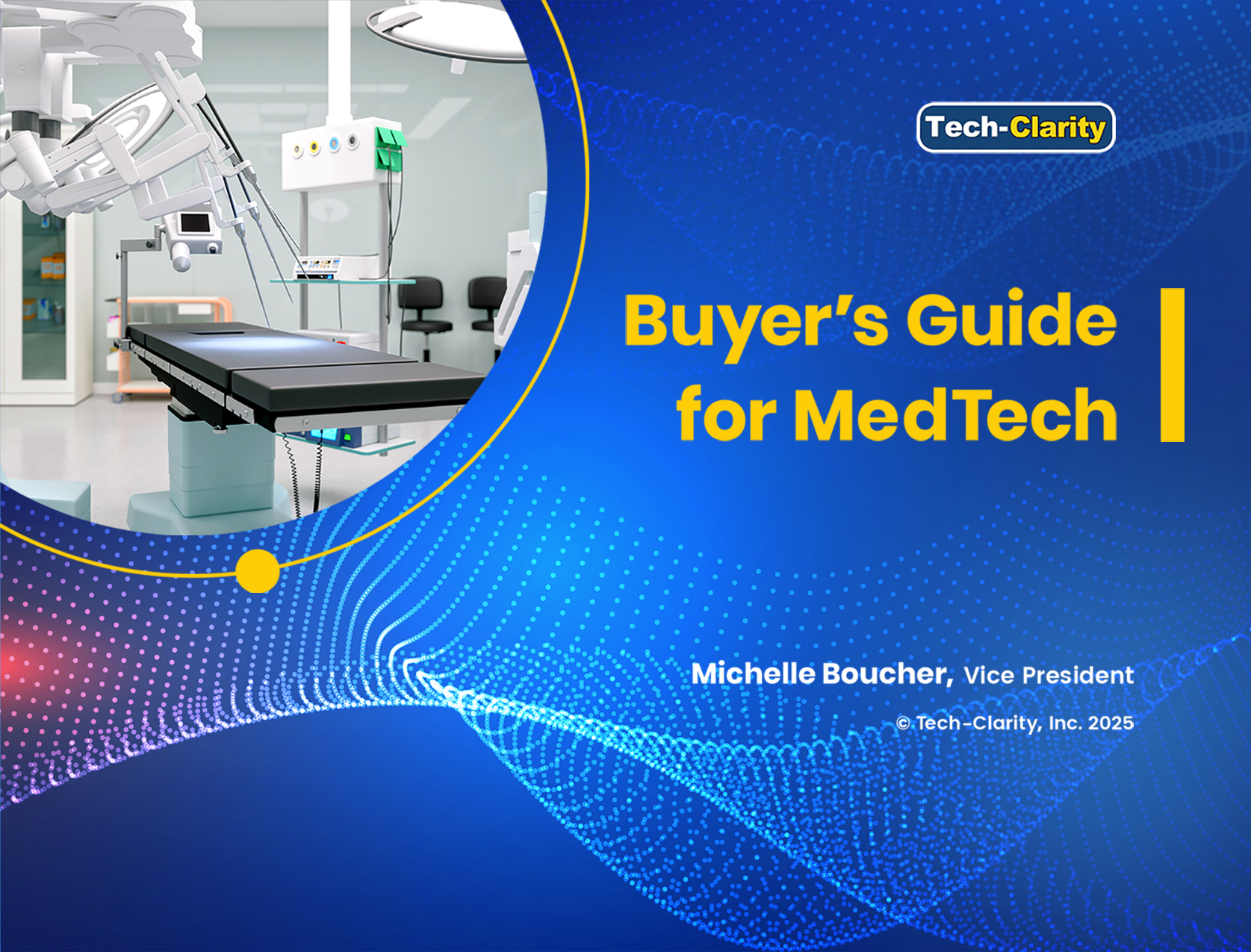 What will help MedTech companies stay competitive in an era marked by rapid innovation, rising regulatory complexity, and global disruption?
As the industry moves toward smarter, more personalized, and increasingly connected healthcare, MedTech manufacturers face mounting pressure to reduce time to market, improve patient outcomes, control costs, and ensure compliance without sacrificing quality or patient safety. Achieving success in this environment requires digital transformation. With it, MedTech companies can realize greater efficiencies while developing, building, and servicing products and devices across their lifecycle. What should companies consider to successfully select the right solution?
This buyer's guide outlines key buying criteria across four critical areas: software functionality, implementation support, vendor capabilities, and company-specific needs. Based on expert interviews and market research, it's designed to help MedTech leaders evaluate and invest in the tools that will drive innovation, efficiency, and compliance in the years ahead.
Please enjoy the summary* below. For the full research, please visit our sponsor, PTC (registration required).
What will help MedTech companies stay competitive in an era marked by rapid innovation, rising regulatory complexity, and global disruption?
As the industry moves toward smarter, more personalized, and increasingly connected healthcare, MedTech manufacturers face mounting pressure to reduce time to market, improve patient outcomes, control costs, and ensure compliance without sacrificing quality or patient safety. Achieving success in this environment requires digital transformation. With it, MedTech companies can realize greater efficiencies while developing, building, and servicing products and devices across their lifecycle. What should companies consider to successfully select the right solution?
This buyer's guide outlines key buying criteria across four critical areas: software functionality, implementation support, vendor capabilities, and company-specific needs. Based on expert interviews and market research, it's designed to help MedTech leaders evaluate and invest in the tools that will drive innovation, efficiency, and compliance in the years ahead.
Please enjoy the summary* below. For the full research, please visit our sponsor, PTC (registration required).
Table of Contents
- Executive Summary
- Business Needs Driving Development Investment
- MedTech Development Challenges
- The Value of a Digital Thread
- 1. Requirements Management
- 2. Hardware Development
- 3. Software Development
- 4. Smart Connected Products
- 5. Regulatory Compliance
- 6. Quality Management
- 7. Plan for Manufacturing
- 8. Service & Post-Market
- Adoption and Implementation
- Vendor Considerations
- Specific Company Needs
- Conclusions and Next Steps
- Acknowledgments
Executive Summary
MedTech Opportunities By 2030, one in six people worldwide will be over 60, which will lead to an increase in age-related disorders. Additionally, there has been a rise in chronic diseases, such as diabetes, among younger populations. Trends like this are leading to the development of novel treatment and therapy options. This significant surge in innovation is evident in the 19,100 submissions the FDA received in 2023, along with the record 167 breakthrough designations it granted. Artificial intelligence (AI) is driving even more innovation as the FDA has now authorized over 1,000 AI-enabled devices. Given these trends, the global MedTech market is projected to grow 6.5% annually through 2032.5 The companies that thrive will likely be those that prioritize novel innovations, as incremental improvements won’t be enough. R&D excellence will be essential for growth. Challenges to Overcome Despite the strong market potential, MedTech companies face increasing regulatory complexity, rising costs, and growing product complexity, all of which reduce R&D productivity. To succeed, manufacturers must look beyond minor process improvements. Life sciences leaders see digital transformation as critical to success. To support digital transformation, MedTech companies need an integrated product development solution that connects hardware, software, quality, manufacturing, and service. This solution should enable traceability, compliance, and collaboration, thereby reducing risk, accelerating innovation, and improving outcomes. How to Use This Guide This guide comprises four major sections covering software tool functionality, service requirements, vendor attributes, and special company considerations. Each section includes a checklist of key requirements to support your selection process. While it is not an all-encompassing requirements list, it provides a high-level overview of criteria considerations.
The Value of a Digital Thread
 Operational Resilience
As regulations tighten and risks rise, full traceability has become critical. MedTech companies must demonstrate how decisions are made, how changes affect safety and performance, and maintain compliance from design to post-market support. Legacy systems cannot maintain this end-to-end visibility. A digital thread, enabled by an integrated solution, supports traceability, audit readiness, and proactive quality management.
Overcome Silos
A digital thread links requirements, design, engineering, manufacturing, quality, and service, making every decision traceable, every change visible, and every team aligned. Traceability accelerates root cause analysis, simplifies compliance, and improves first-time-right development. When requirements are linked to test results, quality and regulatory assurance become built-in.
By integrating Application Lifecycle Management (ALM), Product Lifecycle Management (PLM), Quality Management Systems (QMS), ERP, Manufacturing Execution Systems (MES), and Service Lifecycle Management (SLM), companies improve collaboration, manage requirements, plan for manufacturing, and leverage real-world service data in a shared digital environment. This integration yields numerous business benefits (see graphic).10
Prepare for the Future
This approach enables MedTech companies to transition from document-based processes to data-driven development, integrated quality systems, and connected service operations. It provides the agility needed to thrive in today's disruptive environment. The right solution will also support next-generation capabilities like AI, digital twins, and open interoperability.
Operational Resilience
As regulations tighten and risks rise, full traceability has become critical. MedTech companies must demonstrate how decisions are made, how changes affect safety and performance, and maintain compliance from design to post-market support. Legacy systems cannot maintain this end-to-end visibility. A digital thread, enabled by an integrated solution, supports traceability, audit readiness, and proactive quality management.
Overcome Silos
A digital thread links requirements, design, engineering, manufacturing, quality, and service, making every decision traceable, every change visible, and every team aligned. Traceability accelerates root cause analysis, simplifies compliance, and improves first-time-right development. When requirements are linked to test results, quality and regulatory assurance become built-in.
By integrating Application Lifecycle Management (ALM), Product Lifecycle Management (PLM), Quality Management Systems (QMS), ERP, Manufacturing Execution Systems (MES), and Service Lifecycle Management (SLM), companies improve collaboration, manage requirements, plan for manufacturing, and leverage real-world service data in a shared digital environment. This integration yields numerous business benefits (see graphic).10
Prepare for the Future
This approach enables MedTech companies to transition from document-based processes to data-driven development, integrated quality systems, and connected service operations. It provides the agility needed to thrive in today's disruptive environment. The right solution will also support next-generation capabilities like AI, digital twins, and open interoperability.
Adoption and Implementation
Accelerate Adoption To realize the expected value of the solution, it’s essential to drive adoption across teams, ensure systems integrate, and support long-term scalability. In a high-stakes, regulated environment, MedTech companies must transition with minimal disruption while transforming digitally. Why it Matters A modular, scalable architecture lets you start small and expand, minimizing disruption. A cloud-based deployment improves performance and global accessibility. Seamless integration with ERP, MES, and QMS reduces friction for cross-functional adoption. Flexible workflows and customizable UIs accommodate different process maturities and user roles, boosting usability. Low-code/no-code tools let admins adapt workflows, forms, and templates without heavy IT involvement. Combined with built-in analytics further supports adoption and performance. MedTech-specific templates, best-practice workflows, and structured onboarding all accelerate time to value. Validation-ready solutions simplify maintaining compliance under Computer Software Assurance (CSA).Conclusions and Next Steps
Prepare for the Future The MedTech sector is facing a perfect storm of challenges, including tightening regulations, geopolitical instability, rising costs, and constant pressure to innovate. To stay competitive, manufacturers must not only ensure product quality and patient safety, they must also build agility, resilience, and efficiency into their core processes for designing, developing, manufacturing, and servicing products. This requires a fundamental shift from fragmented systems and manual processes to a unified solution. These challenges jeopardize not only efficiency but also compliance, customer satisfaction, and even patient safety. The right solution can eliminate these bottlenecks by connecting every phase of the product lifecycle, integrating quality and compliance by design, and providing the digital agility that MedTech organizations need to thrive in a rapidly changing environment. Next Steps Use this buyer’s guide to define your organization’s priorities and must-have capabilities. Begin evaluating solution providers that offer integrated PLM, ALM, QMS, and service lifecycle tools tailored to the MedTech industry. Look for platforms that support regulatory compliance, multi-disciplinary collaboration, and scalable deployment. Engage cross-functional stakeholders early to align on goals and ensure a successful transformation. *This summary is an abbreviated version of the ebook and does not contain the full content. For the full report, please visit our sponsor PTC. If you have difficulty obtaining a copy of the research, please contact us. [post_title] => Buyer’s Guide for MedTech [post_excerpt] => [post_status] => publish [comment_status] => open [ping_status] => open [post_password] => [post_name] => medtech-buyers-guide [to_ping] => [pinged] => [post_modified] => 2025-09-17 09:57:38 [post_modified_gmt] => 2025-09-17 13:57:38 [post_content_filtered] => [post_parent] => 0 [guid] => https://tech-clarity.com/?p=22809 [menu_order] => 0 [post_type] => post [post_mime_type] => [comment_count] => 0 [filter] => raw ) [comment_count] => 0 [current_comment] => -1 [found_posts] => 802 [max_num_pages] => 41 [max_num_comment_pages] => 0 [is_single] => [is_preview] => [is_page] => [is_archive] => [is_date] => [is_year] => [is_month] => [is_day] => [is_time] => [is_author] => [is_category] => [is_tag] => [is_tax] => [is_search] => [is_feed] => [is_comment_feed] => [is_trackback] => [is_home] => 1 [is_privacy_policy] => [is_404] => [is_embed] => [is_paged] => [is_admin] => [is_attachment] => [is_singular] => [is_robots] => [is_favicon] => [is_posts_page] => [is_post_type_archive] => [query_vars_hash:WP_Query:private] => d22f48dc892580878a14e3095e7e5249 [query_vars_changed:WP_Query:private] => 1 [thumbnails_cached] => [allow_query_attachment_by_filename:protected] => [stopwords:WP_Query:private] => [compat_fields:WP_Query:private] => Array ( [0] => query_vars_hash [1] => query_vars_changed ) [compat_methods:WP_Query:private] => Array ( [0] => init_query_flags [1] => parse_tax_query ) [query_cache_key:WP_Query:private] => wp_query:1cd9c62744c30561ab5c1395d01058c6:0.77484100 17641730380.78418400 1764173038 )All Results for "All"
Siemens Realize LIVE 2025: A Vision for AI, Simulation, and Immersive Engineering in a Connected Digital Thread
Recently, we attended Realize LIVE 2025 events in both Detroit and Amsterdam. During these events, Siemens presented a clear and cohesive vision for helping customers manage increasing product complexity through digital transformation. This vision incorporates AI, cloud technology, a comprehensive digital twin, and an industry-tailored digital threads. Across multiple presentations, starting with the vision shared…
Industrial Machinery: Reducing Engineering Time Wasters
How can machine builders improve engineering productivity? Industrial machinery has become increasingly complex, with even more mechanical components, electronics, and software. Customer needs for improved maintainability, increased automation, and better efficiency have driven this complexity further. Engineers are critical to successfully meet these requirements. Yet, engineers regularly lose productivity to non-value-add tasks that not only…
Future-Ready Manufacturing with the Right MES/MOM, Analytics, and AI
Given how fast technology and markets are changing, how can manufacturers of intelligent products ensure they are ready for what’s next? Future-ready manufacturing requires plant floor systems that go beyond traditional manufacturing execution systems (MES). With the full scope of manufacturing operations management (MOM), analytics, and artificial intelligence (AI), companies have a good opportunity to…
SSI: Shipbuilding Platform That’s Purpose-Built from the Hull Up
We recently had the opportunity to speak with Denis Morais and Greg Goulanian from SSI. SSI offers specialized solutions for the design, engineering, construction, and maintenance of shipbuilding projects. We’ve known SSI for years and realized that their strategy had shifted so felt it was time for an update. Who Are They? SSI focuses…
Accelerating Electrical Design Survey
What are your biggest electrical design challenges? We are researching electrical design, including top challenges, identifying the most time consuming tasks, the impact of greater automation, and how poor collaboration between electrical and mechanical engineers affects the development process. We will also use the results to identify best practices. The survey takes about 10 to…
Trends in Configuring Products to Order
Introducing the Topic We’ve been researching make-to-order (MTO) and engineer-to-order (ETO) approaches for over two decades and we’ve witnessed continued growth in product customization. We’ve also watched configuration approaches and technologies evolve. Two things have been consistent over time: Configured products are compelling for customers Configuring and making products to order is challenging for manufacturers…
Highlights from Hexagon Live Global 2025
Hexagon AB invited Tech-Clarity to the recently concluded HxGN LIVE Global 2025 event in Las Vegas and our analyst, Arvind Krishnan covered this event. In this article, we want to discuss three announcements that stood out: Octave, Proplan AI/Autonomous Metrology Suite, and Aeon. Octave – The New Home for Asset Lifecycle Intelligence What is Octave,…
Automotive: How Top Companies Balance Quality, Cost, and Sustainability
How do Top Performing automotive companies balance quality, cost, and sustainability to gain a competitive edge? Early design decisions significantly shape a vehicle’s total cost and environmental impact. Yet, for many OEMs and suppliers, critical cost and carbon footprint data is scattered across systems, making it hard to evaluate trade-offs when it matters most. How…
Howie Markson Joins Tech-Clarity Research Team for Digital Innovation
We are pleased to announce that Howie Markson joins Tech-Clarity as Director of Research for Digital Innovation. This strategic hire strengthens Tech-Clarity’s ability to help educate manufacturers on how to navigate complex technology decisions to improve business performance. Howie’s focus areas include product design, simulation, PLM, PDM, SLM, IoT, AI, and other product development solutions…
Jim Brown Talks Digital Transformation on The Industry Forward Podcast
Tech-Clarity President and Founder Jim Brown had the opportunity to join Siemens Vice President of Industry Strategy Dale Tutt on his podcast, The Industry Forward. Host Conor Pieck leads a lively conversation between Dale and Jim where Jim shares insights from Tech-Clarity’s research and Dale offers perspectives from his rich experience in the manufacturing and…
Covalent Expands Workforce Operations
Can manufacturers maximize plant human resources as effectively as inventory and equipment? Covalent would say yes. That is what their workforce operations platform is designed to do: continuously maximize labor effectiveness. They continue to build out in multiple directions: functionally, beyond tracking training and job experience to creating an interactive skills matrix, optimizing work allocation,…
Operationalize Collaboration for Agility and Resilience
How can individuals be more effective and efficient through improved collaboration? How can companies get the most out of their people, processes, projects, and portfolios? We’ll explore how improved collaboration, both structured and unstructured, helps companies grow, scale their business, and become more resilient to achieve long-term, sustainable business success. We’ll also share how to…
PTC Strengthens ThingWorx Industrial Data Management Platform
What makes a digital thread that weaves through manufacturing possible? The answer is: operational data management, which includes a host of capabilities to connect, collect, contextualize, and make data flow across offices, plants, and the field. ThingWorx, a PTC Technology, has been doing that for years, and we recently had an update briefing on version…
When is MES Best Implemented Before PLM?
Should emerging companies implement factory software before product lifecycle software? Sometimes. Julie Fraser’s blog post for the First Resonance site explores the strengths of modern MES and when it might be the priority application to implement, even when PLM is not yet in place. Software for a Manufacturing Business Young companies, especially those with breakthrough…
Apprentice Adds Agentic AI to No-Code Cloud Pharma MES
Can a highly regulated pharmaceutical or biotech company trust AI in their GXP manufacturing operations? Apprentice says yes. In the past year, they have added GenAI for intelligent context-awareness to the Tempo MES / LES / Automation solution. Now, they have added agentic AI to automate production and lab processes further. It might sound like…
Executive Strategies for Sustainable Business Success 2025
Over the last seven years we’ve researched what companies are doing to drive long-term, sustainable business success. This year we extend our focus with a new look at business sovereignty and a deeper look into AI. What are the biggest disruptors companies face? What strategies are companies adopting? What priorities are they placing on the…
Shipbuilding: Reducing Engineering Time Wasters
How can shipbuilding companies improve engineering productivity? Shipbuilding has become increasingly complex, with a growing number of owner and sustainability requirements, new technologies, suppliers, and co-makers. Engineers are critical to successfully meeting these requirements. Yet, engineers regularly lose productivity to non-value-add tasks that rob them of their ability to innovate and threaten their company’s ability…
Tulip: Evolving Operations for Modern Manufacturing
Reinventing MES/MOM and Operations We’ve followed Tulip since the early days and were excited to catch up and see what they have accomplished over the past year. From their inception, Tulip Interfaces deliberately set themselves apart from existing industry acronyms like MES (Manufacturing Execution Systems) and MOM (Manufacturing Operations Management). This decision offered advantages and…
42Q – First MES/MOM to the Cloud and Still Going Strong
Where can discrete manufacturers go to find an MES/MOM solution developed by manufacturers with nearly a decade of production usage and experience as a multi-tenant cloud solution? 42Q, a wholly owned subsidiary of Sanmina Corporation, is an obvious choice. They provide: Smart Factory, a fully featured MES/MOM solution, Connected Manufacturing, providing real-time visibility across diverse…

